Consumer Attitudes and Buying Behavior for Home Furniture
VerifiedAdded on 2023/06/15
|47
|14990
|473
AI Summary
This report provides detailed information concerning consumers’ attitudes and buying behavior for home furniture. For organizational purposes, information is categorized according to the five stages of the consumer decision process: (1) problem or need recognition, (2) information search, (3) alternative evaluation, (4) outlet selection and purchase, and (5) post-purchase evaluation. Specifically, the topics of recognizing the need for new furniture, influencers of the decision, important evaluative criteria, information sources, brand and store loyalty, shopping for furniture online, and cognitive dissonance that may be felt after a purchase are included.
Contribute Materials
Your contribution can guide someone’s learning journey. Share your
documents today.

Consumer Attitudes and Buying Behavior for Home Furniture
Prepared for:
Franklin Furniture Institute
Furniture Outreach Program
Prepared by:
Nicole Ponder
Professor of Marketing
Department of Marketing, Quantitative Analysis, and Business Law
College of Business
Box 9582
Mississippi State, MS 39762
Phone: (662) 325-1998
Fax: (662) 325-7012
Email: nponder@business.msstate.edu
This report was prepared with the help of a grant supplied by Lane Furniture Company and
the Furniture Outreach Program at the Franklin Furniture Institute. The author wishes to
thank Toni Ford for her help with data analysis. Thanks also to Bill Martin and Amy
Garrard for their helpful comments during survey development.
July 10, 2013
Prepared for:
Franklin Furniture Institute
Furniture Outreach Program
Prepared by:
Nicole Ponder
Professor of Marketing
Department of Marketing, Quantitative Analysis, and Business Law
College of Business
Box 9582
Mississippi State, MS 39762
Phone: (662) 325-1998
Fax: (662) 325-7012
Email: nponder@business.msstate.edu
This report was prepared with the help of a grant supplied by Lane Furniture Company and
the Furniture Outreach Program at the Franklin Furniture Institute. The author wishes to
thank Toni Ford for her help with data analysis. Thanks also to Bill Martin and Amy
Garrard for their helpful comments during survey development.
July 10, 2013
Secure Best Marks with AI Grader
Need help grading? Try our AI Grader for instant feedback on your assignments.

i
TABLE OF CONTENTS
LIST OF TABLES .............................................................................................................. ii
EXECUTIVE SUMMARY ............................................................................................... iii
INTRODUCTION ............................................................................................................... 1
PROBLEM IDENTIFICATION .......................................................................... 2
RESEARCH METHOD ...................................................................................................... 4
SURVEY DEVELOPMENT ................................................................................ 4
DATA COLLECTION AND SAMPLING PROCEDURE ................................. 5
DATA ANALYSIS .............................................................................................. 8
RESULTS ............................................................................................................................ 9
PROBLEM OR NEED RECOGNITION ............................................................. 9
FURNITURE AND THE SELF-CONCEPT ............................................. 10
FAVORITE FURNITURE IN THE HOME ............................................. 12
FREQUENCY OF PURCHASE DECISIONS ......................................... 13
INFORMATION SEARCH................................................................................ 14
EVALUATIVE CRITERIA ...................................................................... 15
CONSIDERATION SET ........................................................................... 18
INFORMATION SOURCES .................................................................... 19
ALTERNATIVE EVALUATION ...................................................................... 24
OUTLET SELECTION AND PURCHASE ...................................................... 27
IN-STORE SHOPPING AND PURCHASING ........................................ 27
INTERNET SHOPPING AND PURCHASING ....................................... 27
POST-PURCHASE EVALUATION ................................................................. 28
RECOMMENDATIONS ................................................................................................... 30
REFERENCES .................................................................................................................. 33
APPENDIX: SURVEY INSTRUMENT ........................................................................... 35
TABLE OF CONTENTS
LIST OF TABLES .............................................................................................................. ii
EXECUTIVE SUMMARY ............................................................................................... iii
INTRODUCTION ............................................................................................................... 1
PROBLEM IDENTIFICATION .......................................................................... 2
RESEARCH METHOD ...................................................................................................... 4
SURVEY DEVELOPMENT ................................................................................ 4
DATA COLLECTION AND SAMPLING PROCEDURE ................................. 5
DATA ANALYSIS .............................................................................................. 8
RESULTS ............................................................................................................................ 9
PROBLEM OR NEED RECOGNITION ............................................................. 9
FURNITURE AND THE SELF-CONCEPT ............................................. 10
FAVORITE FURNITURE IN THE HOME ............................................. 12
FREQUENCY OF PURCHASE DECISIONS ......................................... 13
INFORMATION SEARCH................................................................................ 14
EVALUATIVE CRITERIA ...................................................................... 15
CONSIDERATION SET ........................................................................... 18
INFORMATION SOURCES .................................................................... 19
ALTERNATIVE EVALUATION ...................................................................... 24
OUTLET SELECTION AND PURCHASE ...................................................... 27
IN-STORE SHOPPING AND PURCHASING ........................................ 27
INTERNET SHOPPING AND PURCHASING ....................................... 27
POST-PURCHASE EVALUATION ................................................................. 28
RECOMMENDATIONS ................................................................................................... 30
REFERENCES .................................................................................................................. 33
APPENDIX: SURVEY INSTRUMENT ........................................................................... 35

ii
LIST OF TABLES
TABLE
1 GENERATIONAL GROUPS COMPARED IN THIS REPORT ........................ 3
2 TOPICS INCLUDED IN SURVEY…………………………………………..…5
3 DEMOGRAPHIC CHARACTERISTICS OF SURVEY RESPONDENTS ....... 7
4 COMMENTS CONCERNING THE SIGNIFICANCE OF FURNITURE ....... 11
5 SUPPORT FOR FURNITURE MADE IN THE U.S.A. ................................... 16
6 SUPPORT FOR ENVIRONMENTALLY-FRIENDLY FURNITURE ............ 17
7 CONSUMERS’ FAVORITE FURNITURE BRANDS AND STORES............ 19
8 THE ROLE OF TRADITIONAL MEDIA IN INFORMATION SEARCH ...... 20
9 THE ROLE OF THE INTERNET IN INFORMATION SEARCH ................... 22
10 SOCIAL MEDIA AS AN INFORMATION SOURCE ..................................... 24
11 FEATURES FOR WHICH CONSUMERS WILL PAY MORE ....................... 25
12 SURVEY ITEMS RELATED TO COGNITIVE DISSONANCE ..................... 29
LIST OF TABLES
TABLE
1 GENERATIONAL GROUPS COMPARED IN THIS REPORT ........................ 3
2 TOPICS INCLUDED IN SURVEY…………………………………………..…5
3 DEMOGRAPHIC CHARACTERISTICS OF SURVEY RESPONDENTS ....... 7
4 COMMENTS CONCERNING THE SIGNIFICANCE OF FURNITURE ....... 11
5 SUPPORT FOR FURNITURE MADE IN THE U.S.A. ................................... 16
6 SUPPORT FOR ENVIRONMENTALLY-FRIENDLY FURNITURE ............ 17
7 CONSUMERS’ FAVORITE FURNITURE BRANDS AND STORES............ 19
8 THE ROLE OF TRADITIONAL MEDIA IN INFORMATION SEARCH ...... 20
9 THE ROLE OF THE INTERNET IN INFORMATION SEARCH ................... 22
10 SOCIAL MEDIA AS AN INFORMATION SOURCE ..................................... 24
11 FEATURES FOR WHICH CONSUMERS WILL PAY MORE ....................... 25
12 SURVEY ITEMS RELATED TO COGNITIVE DISSONANCE ..................... 29
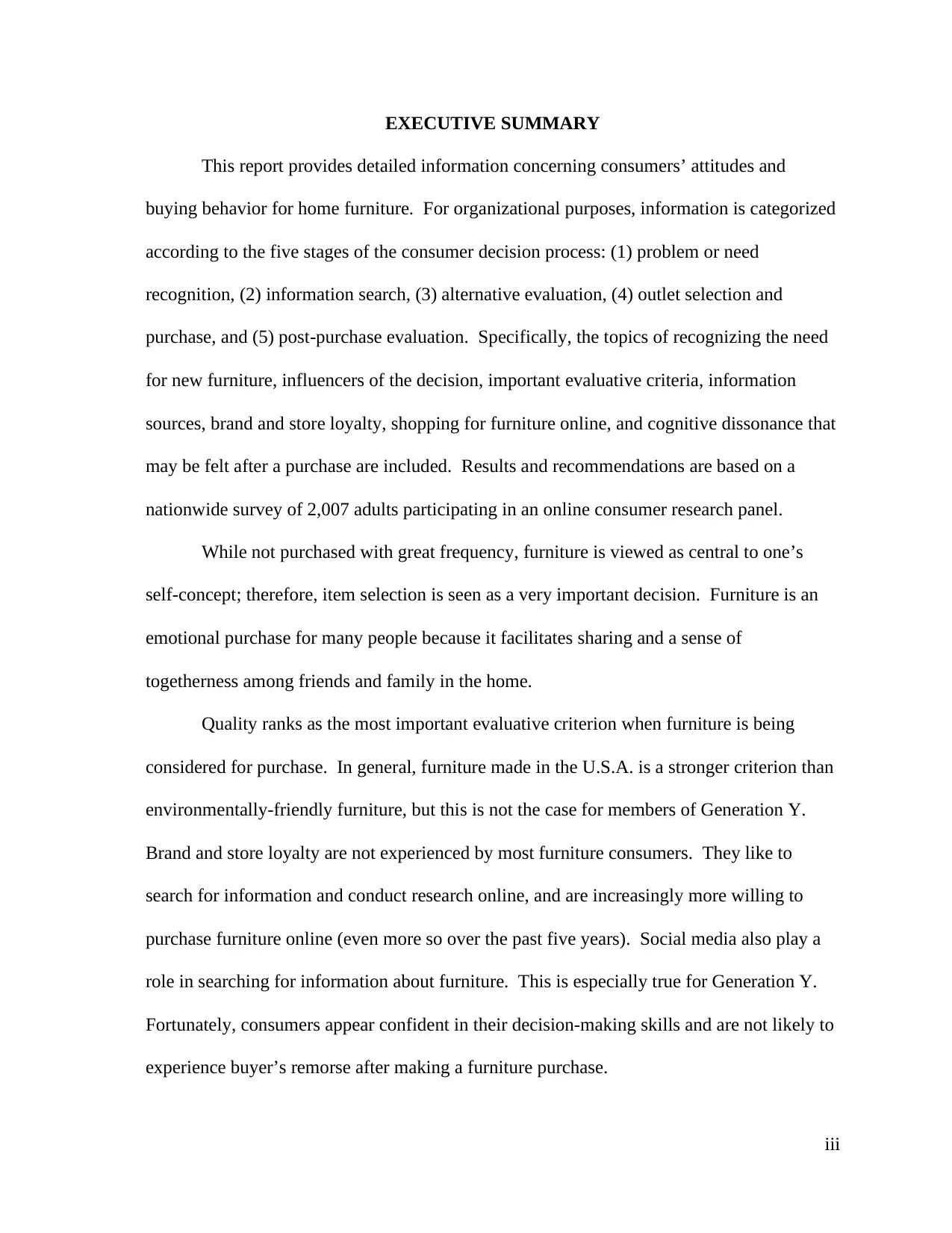
iii
EXECUTIVE SUMMARY
This report provides detailed information concerning consumers’ attitudes and
buying behavior for home furniture. For organizational purposes, information is categorized
according to the five stages of the consumer decision process: (1) problem or need
recognition, (2) information search, (3) alternative evaluation, (4) outlet selection and
purchase, and (5) post-purchase evaluation. Specifically, the topics of recognizing the need
for new furniture, influencers of the decision, important evaluative criteria, information
sources, brand and store loyalty, shopping for furniture online, and cognitive dissonance that
may be felt after a purchase are included. Results and recommendations are based on a
nationwide survey of 2,007 adults participating in an online consumer research panel.
While not purchased with great frequency, furniture is viewed as central to one’s
self-concept; therefore, item selection is seen as a very important decision. Furniture is an
emotional purchase for many people because it facilitates sharing and a sense of
togetherness among friends and family in the home.
Quality ranks as the most important evaluative criterion when furniture is being
considered for purchase. In general, furniture made in the U.S.A. is a stronger criterion than
environmentally-friendly furniture, but this is not the case for members of Generation Y.
Brand and store loyalty are not experienced by most furniture consumers. They like to
search for information and conduct research online, and are increasingly more willing to
purchase furniture online (even more so over the past five years). Social media also play a
role in searching for information about furniture. This is especially true for Generation Y.
Fortunately, consumers appear confident in their decision-making skills and are not likely to
experience buyer’s remorse after making a furniture purchase.
EXECUTIVE SUMMARY
This report provides detailed information concerning consumers’ attitudes and
buying behavior for home furniture. For organizational purposes, information is categorized
according to the five stages of the consumer decision process: (1) problem or need
recognition, (2) information search, (3) alternative evaluation, (4) outlet selection and
purchase, and (5) post-purchase evaluation. Specifically, the topics of recognizing the need
for new furniture, influencers of the decision, important evaluative criteria, information
sources, brand and store loyalty, shopping for furniture online, and cognitive dissonance that
may be felt after a purchase are included. Results and recommendations are based on a
nationwide survey of 2,007 adults participating in an online consumer research panel.
While not purchased with great frequency, furniture is viewed as central to one’s
self-concept; therefore, item selection is seen as a very important decision. Furniture is an
emotional purchase for many people because it facilitates sharing and a sense of
togetherness among friends and family in the home.
Quality ranks as the most important evaluative criterion when furniture is being
considered for purchase. In general, furniture made in the U.S.A. is a stronger criterion than
environmentally-friendly furniture, but this is not the case for members of Generation Y.
Brand and store loyalty are not experienced by most furniture consumers. They like to
search for information and conduct research online, and are increasingly more willing to
purchase furniture online (even more so over the past five years). Social media also play a
role in searching for information about furniture. This is especially true for Generation Y.
Fortunately, consumers appear confident in their decision-making skills and are not likely to
experience buyer’s remorse after making a furniture purchase.
Secure Best Marks with AI Grader
Need help grading? Try our AI Grader for instant feedback on your assignments.
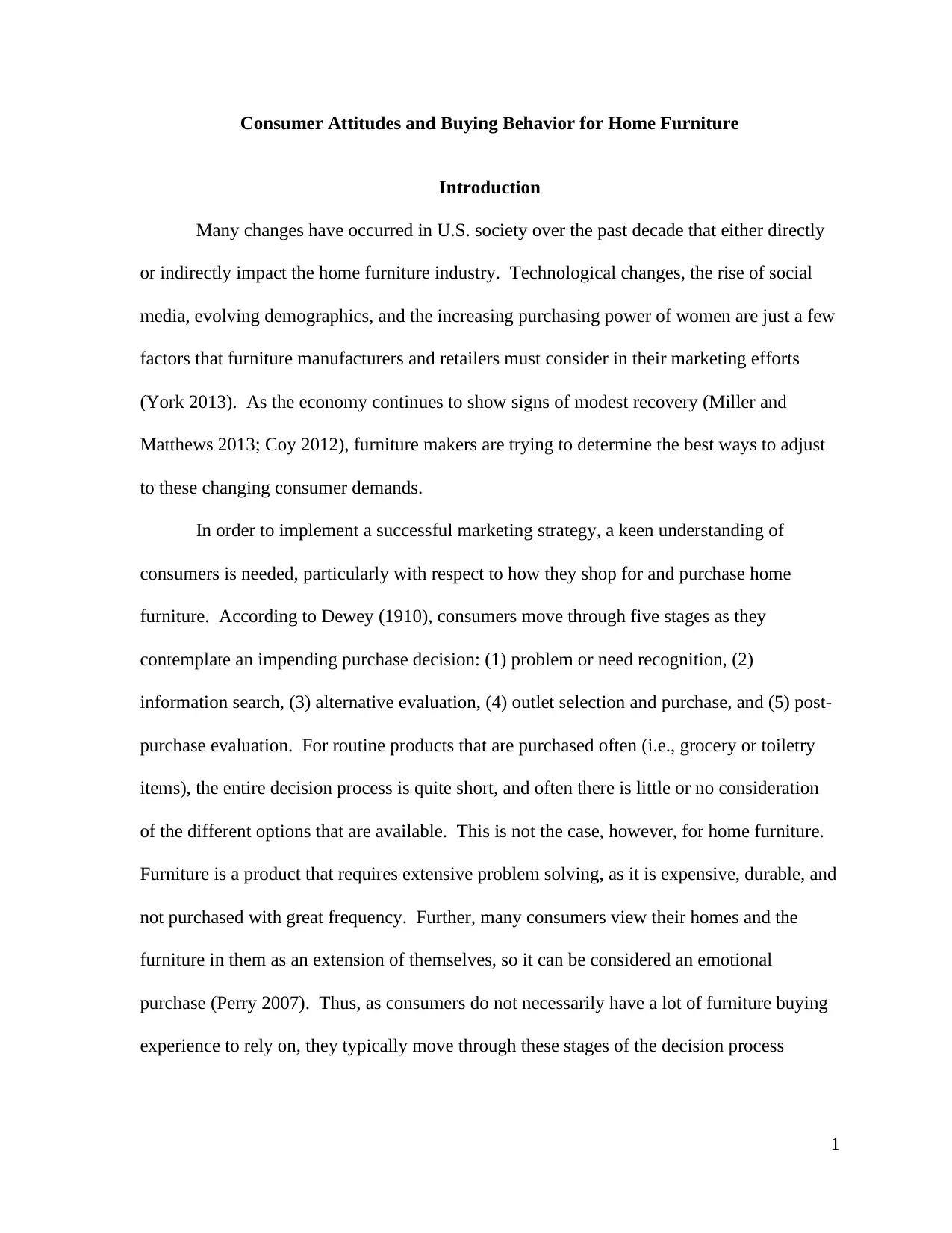
1
Consumer Attitudes and Buying Behavior for Home Furniture
Introduction
Many changes have occurred in U.S. society over the past decade that either directly
or indirectly impact the home furniture industry. Technological changes, the rise of social
media, evolving demographics, and the increasing purchasing power of women are just a few
factors that furniture manufacturers and retailers must consider in their marketing efforts
(York 2013). As the economy continues to show signs of modest recovery (Miller and
Matthews 2013; Coy 2012), furniture makers are trying to determine the best ways to adjust
to these changing consumer demands.
In order to implement a successful marketing strategy, a keen understanding of
consumers is needed, particularly with respect to how they shop for and purchase home
furniture. According to Dewey (1910), consumers move through five stages as they
contemplate an impending purchase decision: (1) problem or need recognition, (2)
information search, (3) alternative evaluation, (4) outlet selection and purchase, and (5) post-
purchase evaluation. For routine products that are purchased often (i.e., grocery or toiletry
items), the entire decision process is quite short, and often there is little or no consideration
of the different options that are available. This is not the case, however, for home furniture.
Furniture is a product that requires extensive problem solving, as it is expensive, durable, and
not purchased with great frequency. Further, many consumers view their homes and the
furniture in them as an extension of themselves, so it can be considered an emotional
purchase (Perry 2007). Thus, as consumers do not necessarily have a lot of furniture buying
experience to rely on, they typically move through these stages of the decision process
Consumer Attitudes and Buying Behavior for Home Furniture
Introduction
Many changes have occurred in U.S. society over the past decade that either directly
or indirectly impact the home furniture industry. Technological changes, the rise of social
media, evolving demographics, and the increasing purchasing power of women are just a few
factors that furniture manufacturers and retailers must consider in their marketing efforts
(York 2013). As the economy continues to show signs of modest recovery (Miller and
Matthews 2013; Coy 2012), furniture makers are trying to determine the best ways to adjust
to these changing consumer demands.
In order to implement a successful marketing strategy, a keen understanding of
consumers is needed, particularly with respect to how they shop for and purchase home
furniture. According to Dewey (1910), consumers move through five stages as they
contemplate an impending purchase decision: (1) problem or need recognition, (2)
information search, (3) alternative evaluation, (4) outlet selection and purchase, and (5) post-
purchase evaluation. For routine products that are purchased often (i.e., grocery or toiletry
items), the entire decision process is quite short, and often there is little or no consideration
of the different options that are available. This is not the case, however, for home furniture.
Furniture is a product that requires extensive problem solving, as it is expensive, durable, and
not purchased with great frequency. Further, many consumers view their homes and the
furniture in them as an extension of themselves, so it can be considered an emotional
purchase (Perry 2007). Thus, as consumers do not necessarily have a lot of furniture buying
experience to rely on, they typically move through these stages of the decision process
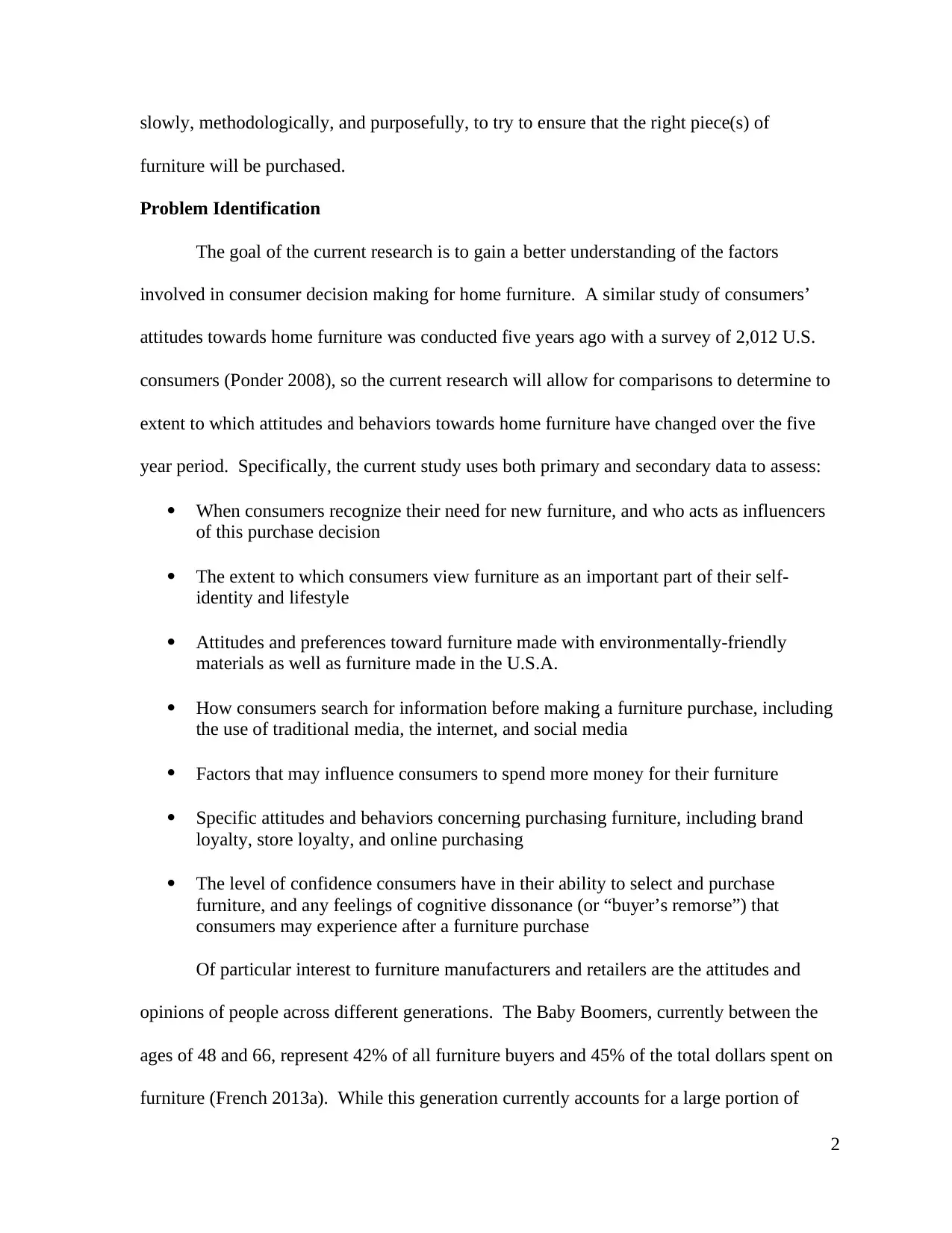
2
slowly, methodologically, and purposefully, to try to ensure that the right piece(s) of
furniture will be purchased.
Problem Identification
The goal of the current research is to gain a better understanding of the factors
involved in consumer decision making for home furniture. A similar study of consumers’
attitudes towards home furniture was conducted five years ago with a survey of 2,012 U.S.
consumers (Ponder 2008), so the current research will allow for comparisons to determine to
extent to which attitudes and behaviors towards home furniture have changed over the five
year period. Specifically, the current study uses both primary and secondary data to assess:
When consumers recognize their need for new furniture, and who acts as influencers
of this purchase decision
The extent to which consumers view furniture as an important part of their self-
identity and lifestyle
Attitudes and preferences toward furniture made with environmentally-friendly
materials as well as furniture made in the U.S.A.
How consumers search for information before making a furniture purchase, including
the use of traditional media, the internet, and social media
Factors that may influence consumers to spend more money for their furniture
Specific attitudes and behaviors concerning purchasing furniture, including brand
loyalty, store loyalty, and online purchasing
The level of confidence consumers have in their ability to select and purchase
furniture, and any feelings of cognitive dissonance (or “buyer’s remorse”) that
consumers may experience after a furniture purchase
Of particular interest to furniture manufacturers and retailers are the attitudes and
opinions of people across different generations. The Baby Boomers, currently between the
ages of 48 and 66, represent 42% of all furniture buyers and 45% of the total dollars spent on
furniture (French 2013a). While this generation currently accounts for a large portion of
slowly, methodologically, and purposefully, to try to ensure that the right piece(s) of
furniture will be purchased.
Problem Identification
The goal of the current research is to gain a better understanding of the factors
involved in consumer decision making for home furniture. A similar study of consumers’
attitudes towards home furniture was conducted five years ago with a survey of 2,012 U.S.
consumers (Ponder 2008), so the current research will allow for comparisons to determine to
extent to which attitudes and behaviors towards home furniture have changed over the five
year period. Specifically, the current study uses both primary and secondary data to assess:
When consumers recognize their need for new furniture, and who acts as influencers
of this purchase decision
The extent to which consumers view furniture as an important part of their self-
identity and lifestyle
Attitudes and preferences toward furniture made with environmentally-friendly
materials as well as furniture made in the U.S.A.
How consumers search for information before making a furniture purchase, including
the use of traditional media, the internet, and social media
Factors that may influence consumers to spend more money for their furniture
Specific attitudes and behaviors concerning purchasing furniture, including brand
loyalty, store loyalty, and online purchasing
The level of confidence consumers have in their ability to select and purchase
furniture, and any feelings of cognitive dissonance (or “buyer’s remorse”) that
consumers may experience after a furniture purchase
Of particular interest to furniture manufacturers and retailers are the attitudes and
opinions of people across different generations. The Baby Boomers, currently between the
ages of 48 and 66, represent 42% of all furniture buyers and 45% of the total dollars spent on
furniture (French 2013a). While this generation currently accounts for a large portion of

3
furniture sales, manufacturers and retailers should also consider the attitudes of younger
adults – specifically Generation Y (hereafter Gen Y) or the Millenial generation. Members
of this generation, currently between the ages of 18 and 34, experience life changes that
precipitate the need for home furniture, such as getting married, having a first child, and
buying a first home (French 2011; Evans 2008). While many members of Gen Y chose to
move back with their parents after graduating college, there is evidence that they are finally
moving away from the nest (Hudson 2013). Additionally, this group represents an attractive
market segment because they are large in number. At approximately 71 million people, this
generation is second in size only to the 80 million Baby Boomers. Throughout this report,
comparisons in attitudes and behaviors will be made across generational groups, comparing
attitudes and behaviors of four generational groups listed in Table 1.
TABLE 1
Generational Groups Compared in this Report
Generation Year Born Age in 2012* Number of
respondents
% of total
sample
Generation Y 1978-1994 18-34 501 25%
Generation X 1965-1977 35-47 539 27%
Baby Boomers 1946-1964 48-66 850 42%
Depression & Pre-
Depression
Generations
Prior to 1946 Over 66 116 6%
*Represents age at time survey data were collected.
The Depression and Pre-Depression generations are in fact two separate groups, with
Pre-Depression members born prior to 1930 and Depression generation members born
between 1930 and 1945. However, the data set used here contained only four respondents
who fell into the Pre-Depression generation (ages 83 and older). Therefore, these two
generations were combined for analysis purposes.
furniture sales, manufacturers and retailers should also consider the attitudes of younger
adults – specifically Generation Y (hereafter Gen Y) or the Millenial generation. Members
of this generation, currently between the ages of 18 and 34, experience life changes that
precipitate the need for home furniture, such as getting married, having a first child, and
buying a first home (French 2011; Evans 2008). While many members of Gen Y chose to
move back with their parents after graduating college, there is evidence that they are finally
moving away from the nest (Hudson 2013). Additionally, this group represents an attractive
market segment because they are large in number. At approximately 71 million people, this
generation is second in size only to the 80 million Baby Boomers. Throughout this report,
comparisons in attitudes and behaviors will be made across generational groups, comparing
attitudes and behaviors of four generational groups listed in Table 1.
TABLE 1
Generational Groups Compared in this Report
Generation Year Born Age in 2012* Number of
respondents
% of total
sample
Generation Y 1978-1994 18-34 501 25%
Generation X 1965-1977 35-47 539 27%
Baby Boomers 1946-1964 48-66 850 42%
Depression & Pre-
Depression
Generations
Prior to 1946 Over 66 116 6%
*Represents age at time survey data were collected.
The Depression and Pre-Depression generations are in fact two separate groups, with
Pre-Depression members born prior to 1930 and Depression generation members born
between 1930 and 1945. However, the data set used here contained only four respondents
who fell into the Pre-Depression generation (ages 83 and older). Therefore, these two
generations were combined for analysis purposes.
Paraphrase This Document
Need a fresh take? Get an instant paraphrase of this document with our AI Paraphraser
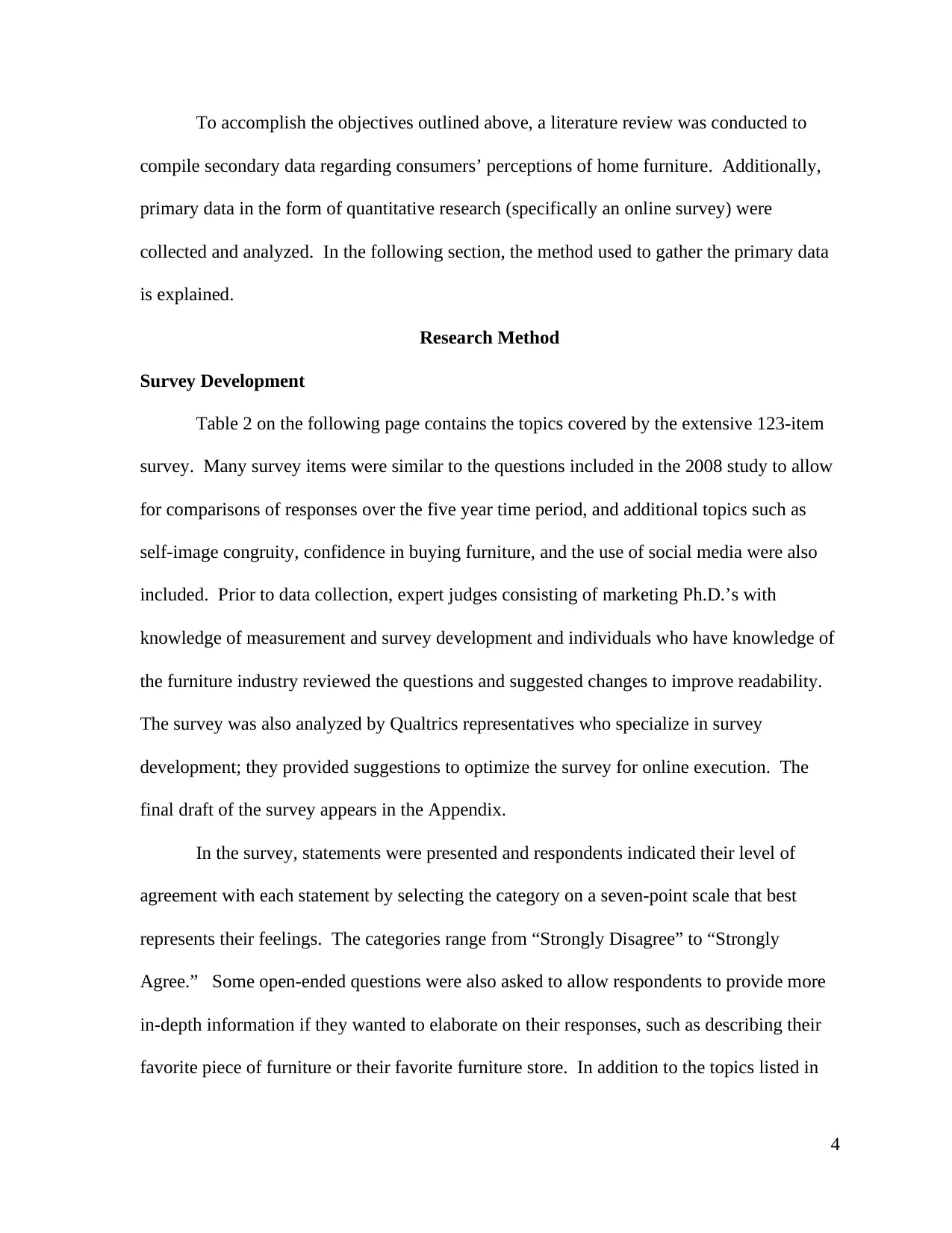
4
To accomplish the objectives outlined above, a literature review was conducted to
compile secondary data regarding consumers’ perceptions of home furniture. Additionally,
primary data in the form of quantitative research (specifically an online survey) were
collected and analyzed. In the following section, the method used to gather the primary data
is explained.
Research Method
Survey Development
Table 2 on the following page contains the topics covered by the extensive 123-item
survey. Many survey items were similar to the questions included in the 2008 study to allow
for comparisons of responses over the five year time period, and additional topics such as
self-image congruity, confidence in buying furniture, and the use of social media were also
included. Prior to data collection, expert judges consisting of marketing Ph.D.’s with
knowledge of measurement and survey development and individuals who have knowledge of
the furniture industry reviewed the questions and suggested changes to improve readability.
The survey was also analyzed by Qualtrics representatives who specialize in survey
development; they provided suggestions to optimize the survey for online execution. The
final draft of the survey appears in the Appendix.
In the survey, statements were presented and respondents indicated their level of
agreement with each statement by selecting the category on a seven-point scale that best
represents their feelings. The categories range from “Strongly Disagree” to “Strongly
Agree.” Some open-ended questions were also asked to allow respondents to provide more
in-depth information if they wanted to elaborate on their responses, such as describing their
favorite piece of furniture or their favorite furniture store. In addition to the topics listed in
To accomplish the objectives outlined above, a literature review was conducted to
compile secondary data regarding consumers’ perceptions of home furniture. Additionally,
primary data in the form of quantitative research (specifically an online survey) were
collected and analyzed. In the following section, the method used to gather the primary data
is explained.
Research Method
Survey Development
Table 2 on the following page contains the topics covered by the extensive 123-item
survey. Many survey items were similar to the questions included in the 2008 study to allow
for comparisons of responses over the five year time period, and additional topics such as
self-image congruity, confidence in buying furniture, and the use of social media were also
included. Prior to data collection, expert judges consisting of marketing Ph.D.’s with
knowledge of measurement and survey development and individuals who have knowledge of
the furniture industry reviewed the questions and suggested changes to improve readability.
The survey was also analyzed by Qualtrics representatives who specialize in survey
development; they provided suggestions to optimize the survey for online execution. The
final draft of the survey appears in the Appendix.
In the survey, statements were presented and respondents indicated their level of
agreement with each statement by selecting the category on a seven-point scale that best
represents their feelings. The categories range from “Strongly Disagree” to “Strongly
Agree.” Some open-ended questions were also asked to allow respondents to provide more
in-depth information if they wanted to elaborate on their responses, such as describing their
favorite piece of furniture or their favorite furniture store. In addition to the topics listed in
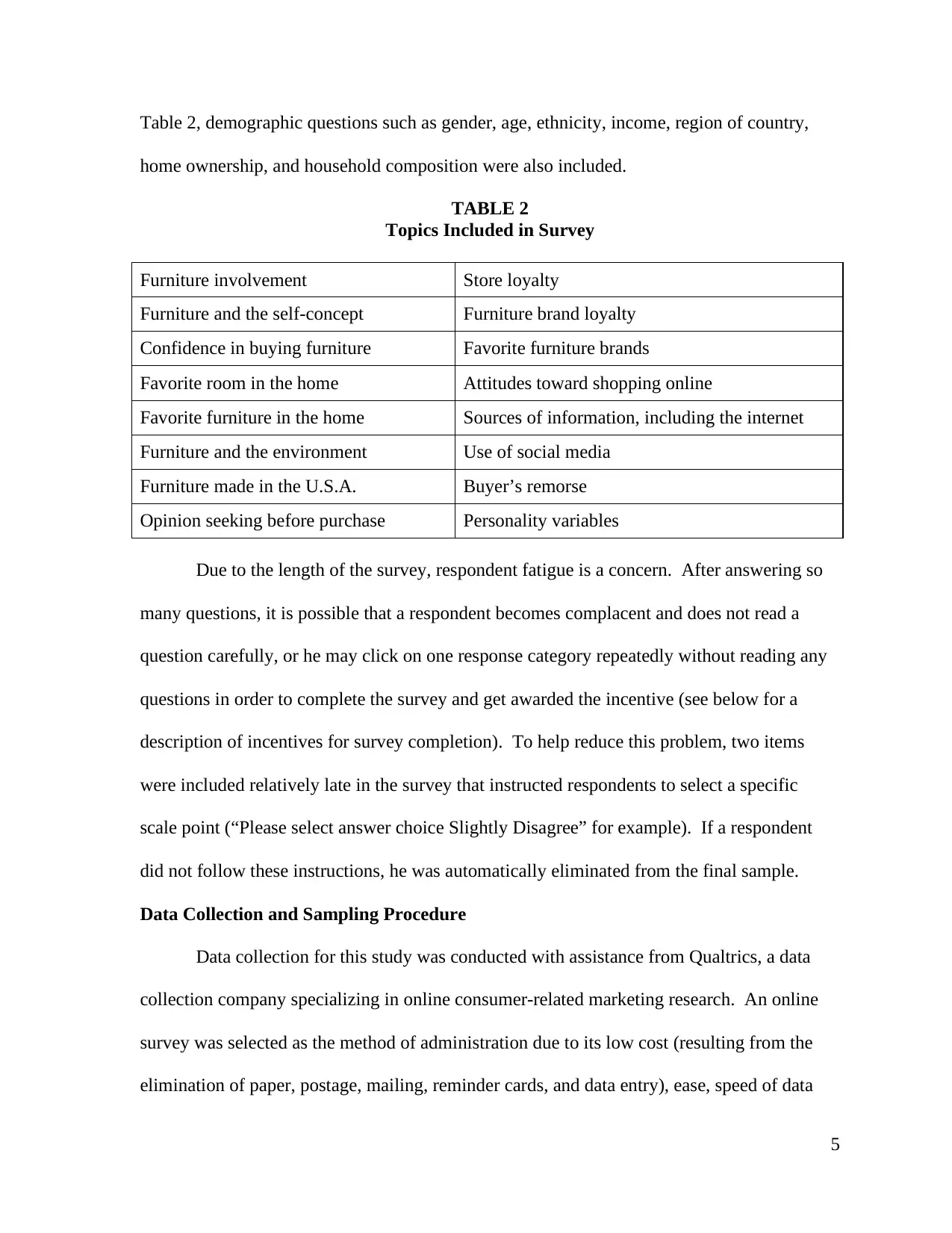
5
Table 2, demographic questions such as gender, age, ethnicity, income, region of country,
home ownership, and household composition were also included.
TABLE 2
Topics Included in Survey
Furniture involvement Store loyalty
Furniture and the self-concept Furniture brand loyalty
Confidence in buying furniture Favorite furniture brands
Favorite room in the home Attitudes toward shopping online
Favorite furniture in the home Sources of information, including the internet
Furniture and the environment Use of social media
Furniture made in the U.S.A. Buyer’s remorse
Opinion seeking before purchase Personality variables
Due to the length of the survey, respondent fatigue is a concern. After answering so
many questions, it is possible that a respondent becomes complacent and does not read a
question carefully, or he may click on one response category repeatedly without reading any
questions in order to complete the survey and get awarded the incentive (see below for a
description of incentives for survey completion). To help reduce this problem, two items
were included relatively late in the survey that instructed respondents to select a specific
scale point (“Please select answer choice Slightly Disagree” for example). If a respondent
did not follow these instructions, he was automatically eliminated from the final sample.
Data Collection and Sampling Procedure
Data collection for this study was conducted with assistance from Qualtrics, a data
collection company specializing in online consumer-related marketing research. An online
survey was selected as the method of administration due to its low cost (resulting from the
elimination of paper, postage, mailing, reminder cards, and data entry), ease, speed of data
Table 2, demographic questions such as gender, age, ethnicity, income, region of country,
home ownership, and household composition were also included.
TABLE 2
Topics Included in Survey
Furniture involvement Store loyalty
Furniture and the self-concept Furniture brand loyalty
Confidence in buying furniture Favorite furniture brands
Favorite room in the home Attitudes toward shopping online
Favorite furniture in the home Sources of information, including the internet
Furniture and the environment Use of social media
Furniture made in the U.S.A. Buyer’s remorse
Opinion seeking before purchase Personality variables
Due to the length of the survey, respondent fatigue is a concern. After answering so
many questions, it is possible that a respondent becomes complacent and does not read a
question carefully, or he may click on one response category repeatedly without reading any
questions in order to complete the survey and get awarded the incentive (see below for a
description of incentives for survey completion). To help reduce this problem, two items
were included relatively late in the survey that instructed respondents to select a specific
scale point (“Please select answer choice Slightly Disagree” for example). If a respondent
did not follow these instructions, he was automatically eliminated from the final sample.
Data Collection and Sampling Procedure
Data collection for this study was conducted with assistance from Qualtrics, a data
collection company specializing in online consumer-related marketing research. An online
survey was selected as the method of administration due to its low cost (resulting from the
elimination of paper, postage, mailing, reminder cards, and data entry), ease, speed of data

6
collection, and efficiency (Duffy, Smith, Terhanian, and Bremer 2005; Dillman 2000). The
biggest potential disadvantage to online surveys lies in the representativeness of the sample.
Are the attitudes and opinions of internet users (and specifically those registered with an
online research company) different from the greater population? As close to 80% of U.S.
households have a computer with internet access in their homes (Nielsen 2008), the
advantages of online surveys are viewed to outweigh any potential disadvantages.
The sampling goal was to obtain a representative sample of at least 2,000 American
respondents that matched the U.S. population on key demographic variables of gender,
ethnicity, and region of country in which the respondent lives. The sample was drawn from a
list of online panelists registered with Qualtrics, which maintains a database of tens of
thousands consumers throughout the U.S. This list was sorted based on the characteristics
specified by the researcher. In this case, the goal was to collect data from individuals at least
18 years of age, with key demographic variables matching those of the U.S. population as
closely as possible.
Regarding incentives, online panelists registered with Qualtrics earn points each time
they complete a survey. Because of the length of this survey (123 questions in total),
respondents were awarded 50 points for completing it. Each respondent has an account
where their points can be deposited and redeemed for various types of merchandise including
cash prizes, gift certificates, and sweepstakes entries.
Email invitations containing a link to the online survey were sent to a total of 10,000
Americans registered with Qualtrics. The survey was closed after the desired number of
responses was achieved, which took approximately one week. Data were collected in late
September and early October of 2012, and the final sample consisted of 2,007 respondents.
collection, and efficiency (Duffy, Smith, Terhanian, and Bremer 2005; Dillman 2000). The
biggest potential disadvantage to online surveys lies in the representativeness of the sample.
Are the attitudes and opinions of internet users (and specifically those registered with an
online research company) different from the greater population? As close to 80% of U.S.
households have a computer with internet access in their homes (Nielsen 2008), the
advantages of online surveys are viewed to outweigh any potential disadvantages.
The sampling goal was to obtain a representative sample of at least 2,000 American
respondents that matched the U.S. population on key demographic variables of gender,
ethnicity, and region of country in which the respondent lives. The sample was drawn from a
list of online panelists registered with Qualtrics, which maintains a database of tens of
thousands consumers throughout the U.S. This list was sorted based on the characteristics
specified by the researcher. In this case, the goal was to collect data from individuals at least
18 years of age, with key demographic variables matching those of the U.S. population as
closely as possible.
Regarding incentives, online panelists registered with Qualtrics earn points each time
they complete a survey. Because of the length of this survey (123 questions in total),
respondents were awarded 50 points for completing it. Each respondent has an account
where their points can be deposited and redeemed for various types of merchandise including
cash prizes, gift certificates, and sweepstakes entries.
Email invitations containing a link to the online survey were sent to a total of 10,000
Americans registered with Qualtrics. The survey was closed after the desired number of
responses was achieved, which took approximately one week. Data were collected in late
September and early October of 2012, and the final sample consisted of 2,007 respondents.
Secure Best Marks with AI Grader
Need help grading? Try our AI Grader for instant feedback on your assignments.
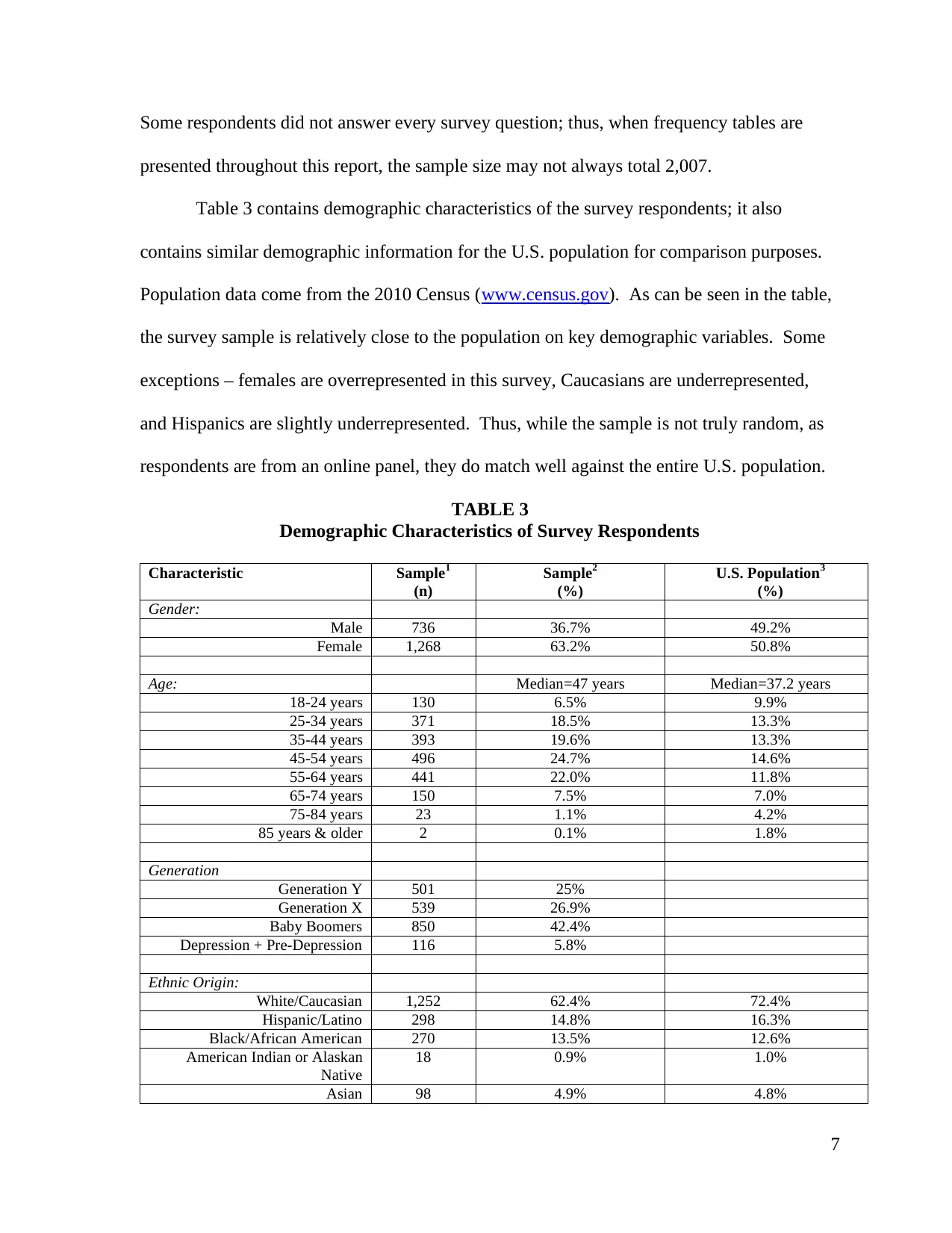
7
Some respondents did not answer every survey question; thus, when frequency tables are
presented throughout this report, the sample size may not always total 2,007.
Table 3 contains demographic characteristics of the survey respondents; it also
contains similar demographic information for the U.S. population for comparison purposes.
Population data come from the 2010 Census (www.census.gov). As can be seen in the table,
the survey sample is relatively close to the population on key demographic variables. Some
exceptions – females are overrepresented in this survey, Caucasians are underrepresented,
and Hispanics are slightly underrepresented. Thus, while the sample is not truly random, as
respondents are from an online panel, they do match well against the entire U.S. population.
TABLE 3
Demographic Characteristics of Survey Respondents
Characteristic Sample1
(n)
Sample2
(%)
U.S. Population3
(%)
Gender:
Male 736 36.7% 49.2%
Female 1,268 63.2% 50.8%
Age: Median=47 years Median=37.2 years
18-24 years 130 6.5% 9.9%
25-34 years 371 18.5% 13.3%
35-44 years 393 19.6% 13.3%
45-54 years 496 24.7% 14.6%
55-64 years 441 22.0% 11.8%
65-74 years 150 7.5% 7.0%
75-84 years 23 1.1% 4.2%
85 years & older 2 0.1% 1.8%
Generation
Generation Y 501 25%
Generation X 539 26.9%
Baby Boomers 850 42.4%
Depression + Pre-Depression 116 5.8%
Ethnic Origin:
White/Caucasian 1,252 62.4% 72.4%
Hispanic/Latino 298 14.8% 16.3%
Black/African American 270 13.5% 12.6%
American Indian or Alaskan
Native
18 0.9% 1.0%
Asian 98 4.9% 4.8%
Some respondents did not answer every survey question; thus, when frequency tables are
presented throughout this report, the sample size may not always total 2,007.
Table 3 contains demographic characteristics of the survey respondents; it also
contains similar demographic information for the U.S. population for comparison purposes.
Population data come from the 2010 Census (www.census.gov). As can be seen in the table,
the survey sample is relatively close to the population on key demographic variables. Some
exceptions – females are overrepresented in this survey, Caucasians are underrepresented,
and Hispanics are slightly underrepresented. Thus, while the sample is not truly random, as
respondents are from an online panel, they do match well against the entire U.S. population.
TABLE 3
Demographic Characteristics of Survey Respondents
Characteristic Sample1
(n)
Sample2
(%)
U.S. Population3
(%)
Gender:
Male 736 36.7% 49.2%
Female 1,268 63.2% 50.8%
Age: Median=47 years Median=37.2 years
18-24 years 130 6.5% 9.9%
25-34 years 371 18.5% 13.3%
35-44 years 393 19.6% 13.3%
45-54 years 496 24.7% 14.6%
55-64 years 441 22.0% 11.8%
65-74 years 150 7.5% 7.0%
75-84 years 23 1.1% 4.2%
85 years & older 2 0.1% 1.8%
Generation
Generation Y 501 25%
Generation X 539 26.9%
Baby Boomers 850 42.4%
Depression + Pre-Depression 116 5.8%
Ethnic Origin:
White/Caucasian 1,252 62.4% 72.4%
Hispanic/Latino 298 14.8% 16.3%
Black/African American 270 13.5% 12.6%
American Indian or Alaskan
Native
18 0.9% 1.0%
Asian 98 4.9% 4.8%
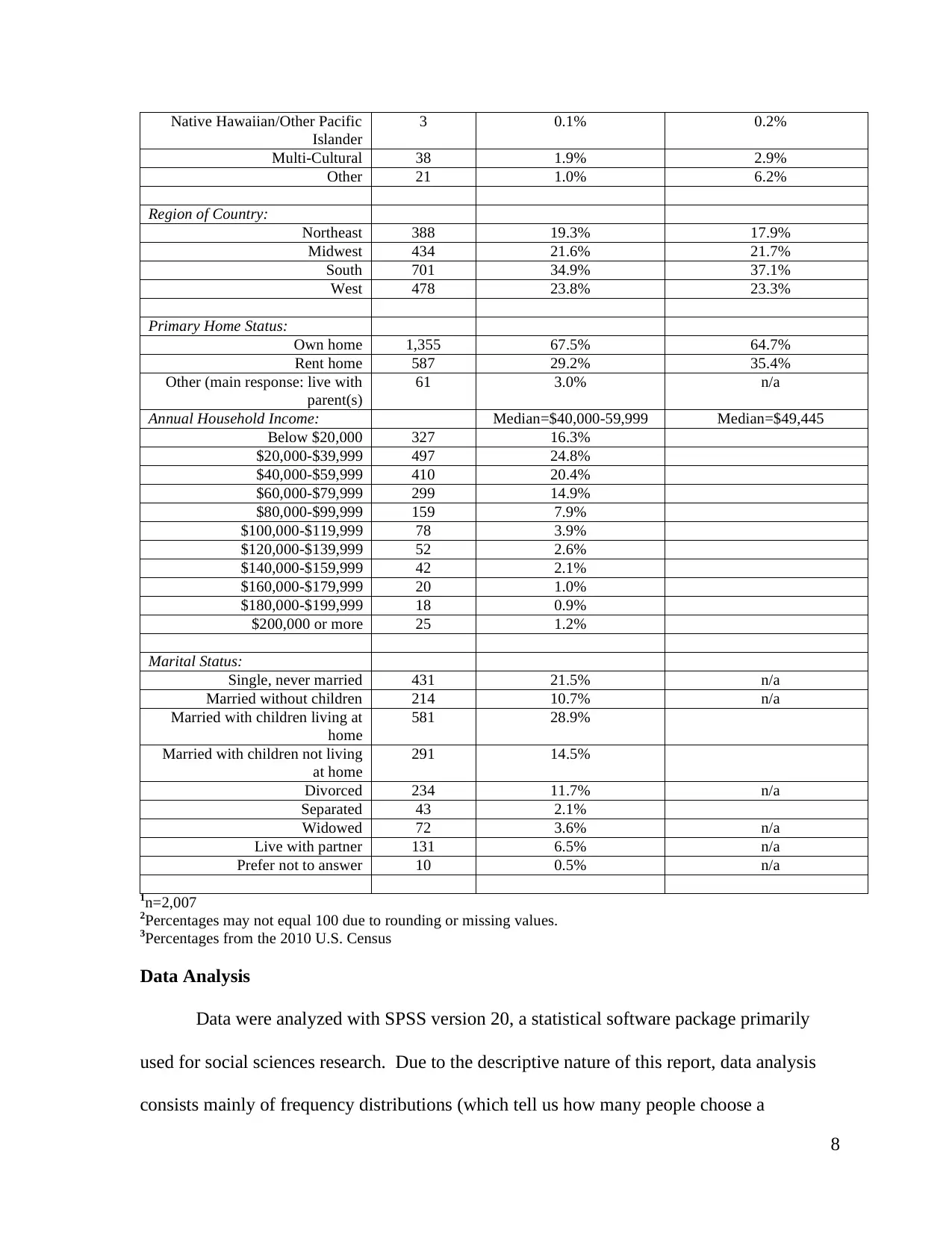
8
Native Hawaiian/Other Pacific
Islander
3 0.1% 0.2%
Multi-Cultural 38 1.9% 2.9%
Other 21 1.0% 6.2%
Region of Country:
Northeast 388 19.3% 17.9%
Midwest 434 21.6% 21.7%
South 701 34.9% 37.1%
West 478 23.8% 23.3%
Primary Home Status:
Own home 1,355 67.5% 64.7%
Rent home 587 29.2% 35.4%
Other (main response: live with
parent(s)
61 3.0% n/a
Annual Household Income: Median=$40,000-59,999 Median=$49,445
Below $20,000 327 16.3%
$20,000-$39,999 497 24.8%
$40,000-$59,999 410 20.4%
$60,000-$79,999 299 14.9%
$80,000-$99,999 159 7.9%
$100,000-$119,999 78 3.9%
$120,000-$139,999 52 2.6%
$140,000-$159,999 42 2.1%
$160,000-$179,999 20 1.0%
$180,000-$199,999 18 0.9%
$200,000 or more 25 1.2%
Marital Status:
Single, never married 431 21.5% n/a
Married without children 214 10.7% n/a
Married with children living at
home
581 28.9%
Married with children not living
at home
291 14.5%
Divorced 234 11.7% n/a
Separated 43 2.1%
Widowed 72 3.6% n/a
Live with partner 131 6.5% n/a
Prefer not to answer 10 0.5% n/a
1n=2,007
2Percentages may not equal 100 due to rounding or missing values.
3Percentages from the 2010 U.S. Census
Data Analysis
Data were analyzed with SPSS version 20, a statistical software package primarily
used for social sciences research. Due to the descriptive nature of this report, data analysis
consists mainly of frequency distributions (which tell us how many people choose a
Native Hawaiian/Other Pacific
Islander
3 0.1% 0.2%
Multi-Cultural 38 1.9% 2.9%
Other 21 1.0% 6.2%
Region of Country:
Northeast 388 19.3% 17.9%
Midwest 434 21.6% 21.7%
South 701 34.9% 37.1%
West 478 23.8% 23.3%
Primary Home Status:
Own home 1,355 67.5% 64.7%
Rent home 587 29.2% 35.4%
Other (main response: live with
parent(s)
61 3.0% n/a
Annual Household Income: Median=$40,000-59,999 Median=$49,445
Below $20,000 327 16.3%
$20,000-$39,999 497 24.8%
$40,000-$59,999 410 20.4%
$60,000-$79,999 299 14.9%
$80,000-$99,999 159 7.9%
$100,000-$119,999 78 3.9%
$120,000-$139,999 52 2.6%
$140,000-$159,999 42 2.1%
$160,000-$179,999 20 1.0%
$180,000-$199,999 18 0.9%
$200,000 or more 25 1.2%
Marital Status:
Single, never married 431 21.5% n/a
Married without children 214 10.7% n/a
Married with children living at
home
581 28.9%
Married with children not living
at home
291 14.5%
Divorced 234 11.7% n/a
Separated 43 2.1%
Widowed 72 3.6% n/a
Live with partner 131 6.5% n/a
Prefer not to answer 10 0.5% n/a
1n=2,007
2Percentages may not equal 100 due to rounding or missing values.
3Percentages from the 2010 U.S. Census
Data Analysis
Data were analyzed with SPSS version 20, a statistical software package primarily
used for social sciences research. Due to the descriptive nature of this report, data analysis
consists mainly of frequency distributions (which tell us how many people choose a
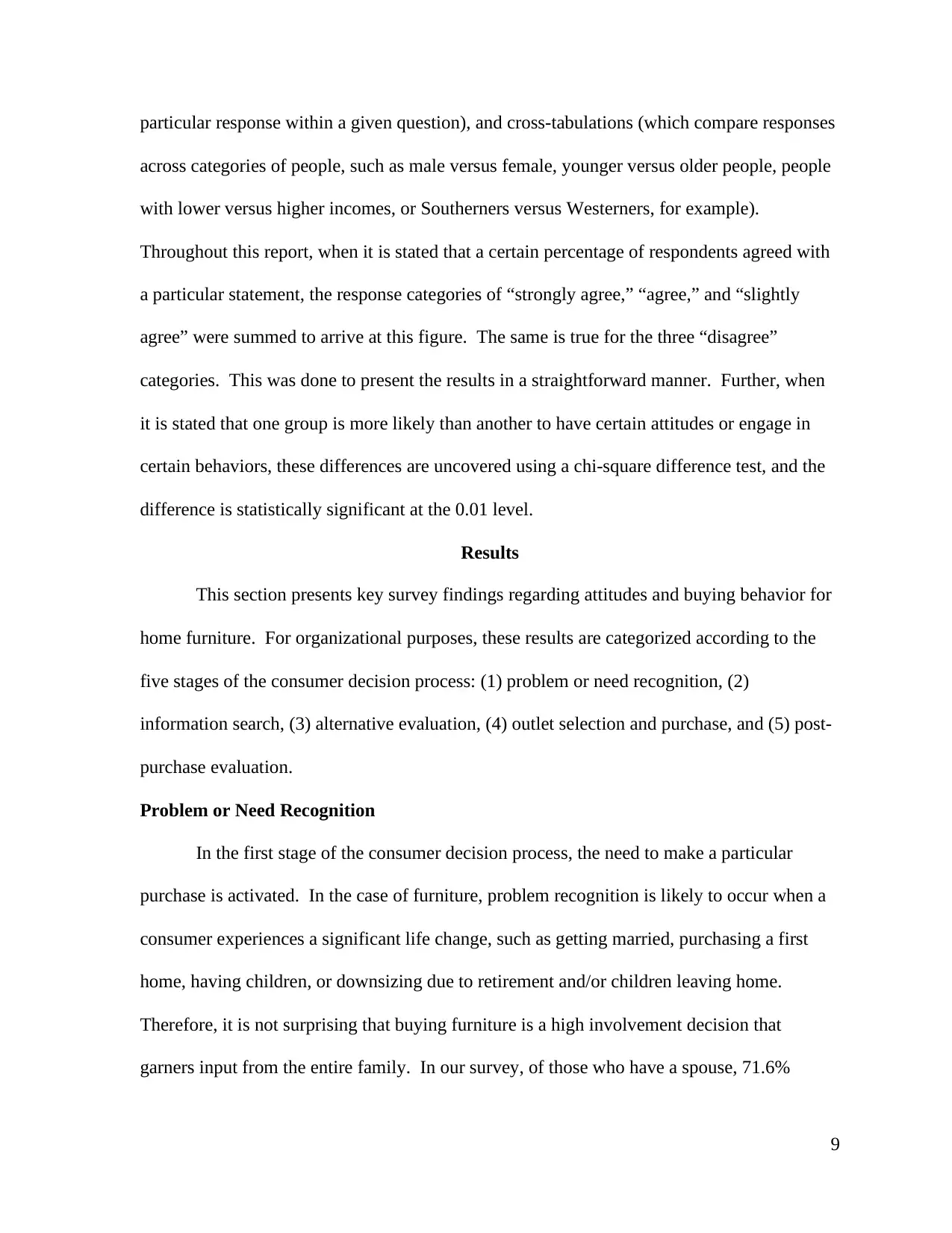
9
particular response within a given question), and cross-tabulations (which compare responses
across categories of people, such as male versus female, younger versus older people, people
with lower versus higher incomes, or Southerners versus Westerners, for example).
Throughout this report, when it is stated that a certain percentage of respondents agreed with
a particular statement, the response categories of “strongly agree,” “agree,” and “slightly
agree” were summed to arrive at this figure. The same is true for the three “disagree”
categories. This was done to present the results in a straightforward manner. Further, when
it is stated that one group is more likely than another to have certain attitudes or engage in
certain behaviors, these differences are uncovered using a chi-square difference test, and the
difference is statistically significant at the 0.01 level.
Results
This section presents key survey findings regarding attitudes and buying behavior for
home furniture. For organizational purposes, these results are categorized according to the
five stages of the consumer decision process: (1) problem or need recognition, (2)
information search, (3) alternative evaluation, (4) outlet selection and purchase, and (5) post-
purchase evaluation.
Problem or Need Recognition
In the first stage of the consumer decision process, the need to make a particular
purchase is activated. In the case of furniture, problem recognition is likely to occur when a
consumer experiences a significant life change, such as getting married, purchasing a first
home, having children, or downsizing due to retirement and/or children leaving home.
Therefore, it is not surprising that buying furniture is a high involvement decision that
garners input from the entire family. In our survey, of those who have a spouse, 71.6%
particular response within a given question), and cross-tabulations (which compare responses
across categories of people, such as male versus female, younger versus older people, people
with lower versus higher incomes, or Southerners versus Westerners, for example).
Throughout this report, when it is stated that a certain percentage of respondents agreed with
a particular statement, the response categories of “strongly agree,” “agree,” and “slightly
agree” were summed to arrive at this figure. The same is true for the three “disagree”
categories. This was done to present the results in a straightforward manner. Further, when
it is stated that one group is more likely than another to have certain attitudes or engage in
certain behaviors, these differences are uncovered using a chi-square difference test, and the
difference is statistically significant at the 0.01 level.
Results
This section presents key survey findings regarding attitudes and buying behavior for
home furniture. For organizational purposes, these results are categorized according to the
five stages of the consumer decision process: (1) problem or need recognition, (2)
information search, (3) alternative evaluation, (4) outlet selection and purchase, and (5) post-
purchase evaluation.
Problem or Need Recognition
In the first stage of the consumer decision process, the need to make a particular
purchase is activated. In the case of furniture, problem recognition is likely to occur when a
consumer experiences a significant life change, such as getting married, purchasing a first
home, having children, or downsizing due to retirement and/or children leaving home.
Therefore, it is not surprising that buying furniture is a high involvement decision that
garners input from the entire family. In our survey, of those who have a spouse, 71.6%
Paraphrase This Document
Need a fresh take? Get an instant paraphrase of this document with our AI Paraphraser

10
consult with their significant other before making a purchase decision, and 67.8% say that
their spouse takes an active role in furniture shopping. When considering only the responses
of females, 57.6% stated that their spouses take an active role in furniture shopping. So
while females are more likely to have an interest in home furniture (68%, compared to 32%
of males), males are still likely to be included in the decision process. For those who have
children, 37.1% of respondents say that their children influence their furniture buying
decisions. In addition, 75% of respondents indicated that they consider the needs of their
entire family when beginning the furniture buying process. These percentages are all
consistent with results from the same questions five years ago.
Furniture and the Self-Concept
Consumers do treat the decision as important, as furniture can serve as an expression
of one’s own identity and personality. A large 72.7% of respondents agreed that, “the design
of my furniture reflects my personality,” 67.0% of respondents agreed with the statement, “A
lot can be said about a person from the furniture s/he owns,” and 60.7% agreed that they
express themselves with the furniture they buy. Regarding furniture as an expression of
one’s personality, there were no differences across generational groups, but, not surprisingly,
females were more likely than males to agree with this statement.
Table 4 provides open-ended comments made by respondents that give an indication
of what their furniture represents to them. The emotional nature of purchasing furniture is
evident when consumers refer to their homes as a place to share and make memories with
friends and family (Perry 2007). Keep in mind that these comments come from the very end
of the survey as an unprompted, open-ended question that simply asked, “And finally, is
there anything you would like to tell us about your feelings towards home furniture?”
consult with their significant other before making a purchase decision, and 67.8% say that
their spouse takes an active role in furniture shopping. When considering only the responses
of females, 57.6% stated that their spouses take an active role in furniture shopping. So
while females are more likely to have an interest in home furniture (68%, compared to 32%
of males), males are still likely to be included in the decision process. For those who have
children, 37.1% of respondents say that their children influence their furniture buying
decisions. In addition, 75% of respondents indicated that they consider the needs of their
entire family when beginning the furniture buying process. These percentages are all
consistent with results from the same questions five years ago.
Furniture and the Self-Concept
Consumers do treat the decision as important, as furniture can serve as an expression
of one’s own identity and personality. A large 72.7% of respondents agreed that, “the design
of my furniture reflects my personality,” 67.0% of respondents agreed with the statement, “A
lot can be said about a person from the furniture s/he owns,” and 60.7% agreed that they
express themselves with the furniture they buy. Regarding furniture as an expression of
one’s personality, there were no differences across generational groups, but, not surprisingly,
females were more likely than males to agree with this statement.
Table 4 provides open-ended comments made by respondents that give an indication
of what their furniture represents to them. The emotional nature of purchasing furniture is
evident when consumers refer to their homes as a place to share and make memories with
friends and family (Perry 2007). Keep in mind that these comments come from the very end
of the survey as an unprompted, open-ended question that simply asked, “And finally, is
there anything you would like to tell us about your feelings towards home furniture?”
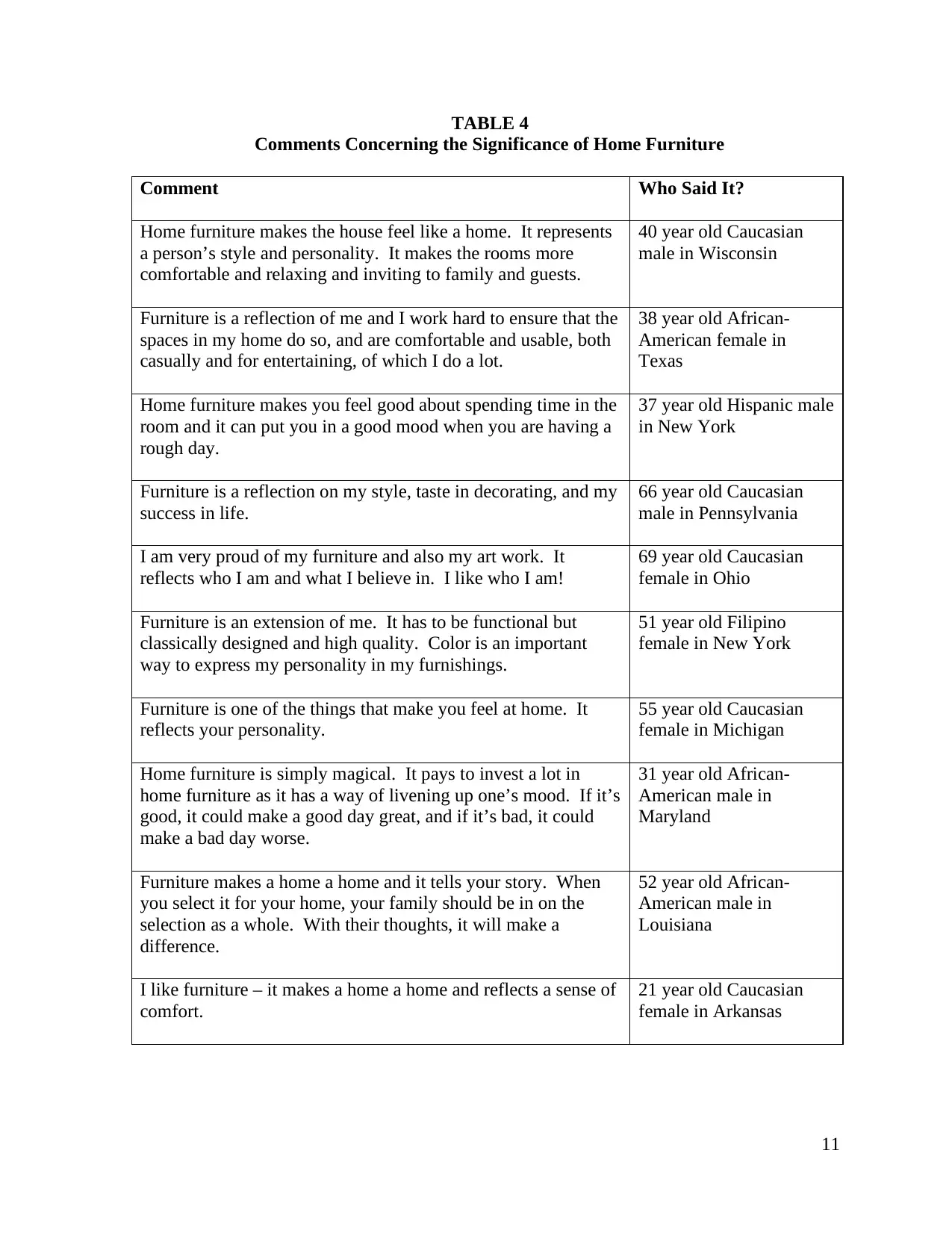
11
TABLE 4
Comments Concerning the Significance of Home Furniture
Comment Who Said It?
Home furniture makes the house feel like a home. It represents
a person’s style and personality. It makes the rooms more
comfortable and relaxing and inviting to family and guests.
40 year old Caucasian
male in Wisconsin
Furniture is a reflection of me and I work hard to ensure that the
spaces in my home do so, and are comfortable and usable, both
casually and for entertaining, of which I do a lot.
38 year old African-
American female in
Texas
Home furniture makes you feel good about spending time in the
room and it can put you in a good mood when you are having a
rough day.
37 year old Hispanic male
in New York
Furniture is a reflection on my style, taste in decorating, and my
success in life.
66 year old Caucasian
male in Pennsylvania
I am very proud of my furniture and also my art work. It
reflects who I am and what I believe in. I like who I am!
69 year old Caucasian
female in Ohio
Furniture is an extension of me. It has to be functional but
classically designed and high quality. Color is an important
way to express my personality in my furnishings.
51 year old Filipino
female in New York
Furniture is one of the things that make you feel at home. It
reflects your personality.
55 year old Caucasian
female in Michigan
Home furniture is simply magical. It pays to invest a lot in
home furniture as it has a way of livening up one’s mood. If it’s
good, it could make a good day great, and if it’s bad, it could
make a bad day worse.
31 year old African-
American male in
Maryland
Furniture makes a home a home and it tells your story. When
you select it for your home, your family should be in on the
selection as a whole. With their thoughts, it will make a
difference.
52 year old African-
American male in
Louisiana
I like furniture – it makes a home a home and reflects a sense of
comfort.
21 year old Caucasian
female in Arkansas
TABLE 4
Comments Concerning the Significance of Home Furniture
Comment Who Said It?
Home furniture makes the house feel like a home. It represents
a person’s style and personality. It makes the rooms more
comfortable and relaxing and inviting to family and guests.
40 year old Caucasian
male in Wisconsin
Furniture is a reflection of me and I work hard to ensure that the
spaces in my home do so, and are comfortable and usable, both
casually and for entertaining, of which I do a lot.
38 year old African-
American female in
Texas
Home furniture makes you feel good about spending time in the
room and it can put you in a good mood when you are having a
rough day.
37 year old Hispanic male
in New York
Furniture is a reflection on my style, taste in decorating, and my
success in life.
66 year old Caucasian
male in Pennsylvania
I am very proud of my furniture and also my art work. It
reflects who I am and what I believe in. I like who I am!
69 year old Caucasian
female in Ohio
Furniture is an extension of me. It has to be functional but
classically designed and high quality. Color is an important
way to express my personality in my furnishings.
51 year old Filipino
female in New York
Furniture is one of the things that make you feel at home. It
reflects your personality.
55 year old Caucasian
female in Michigan
Home furniture is simply magical. It pays to invest a lot in
home furniture as it has a way of livening up one’s mood. If it’s
good, it could make a good day great, and if it’s bad, it could
make a bad day worse.
31 year old African-
American male in
Maryland
Furniture makes a home a home and it tells your story. When
you select it for your home, your family should be in on the
selection as a whole. With their thoughts, it will make a
difference.
52 year old African-
American male in
Louisiana
I like furniture – it makes a home a home and reflects a sense of
comfort.
21 year old Caucasian
female in Arkansas
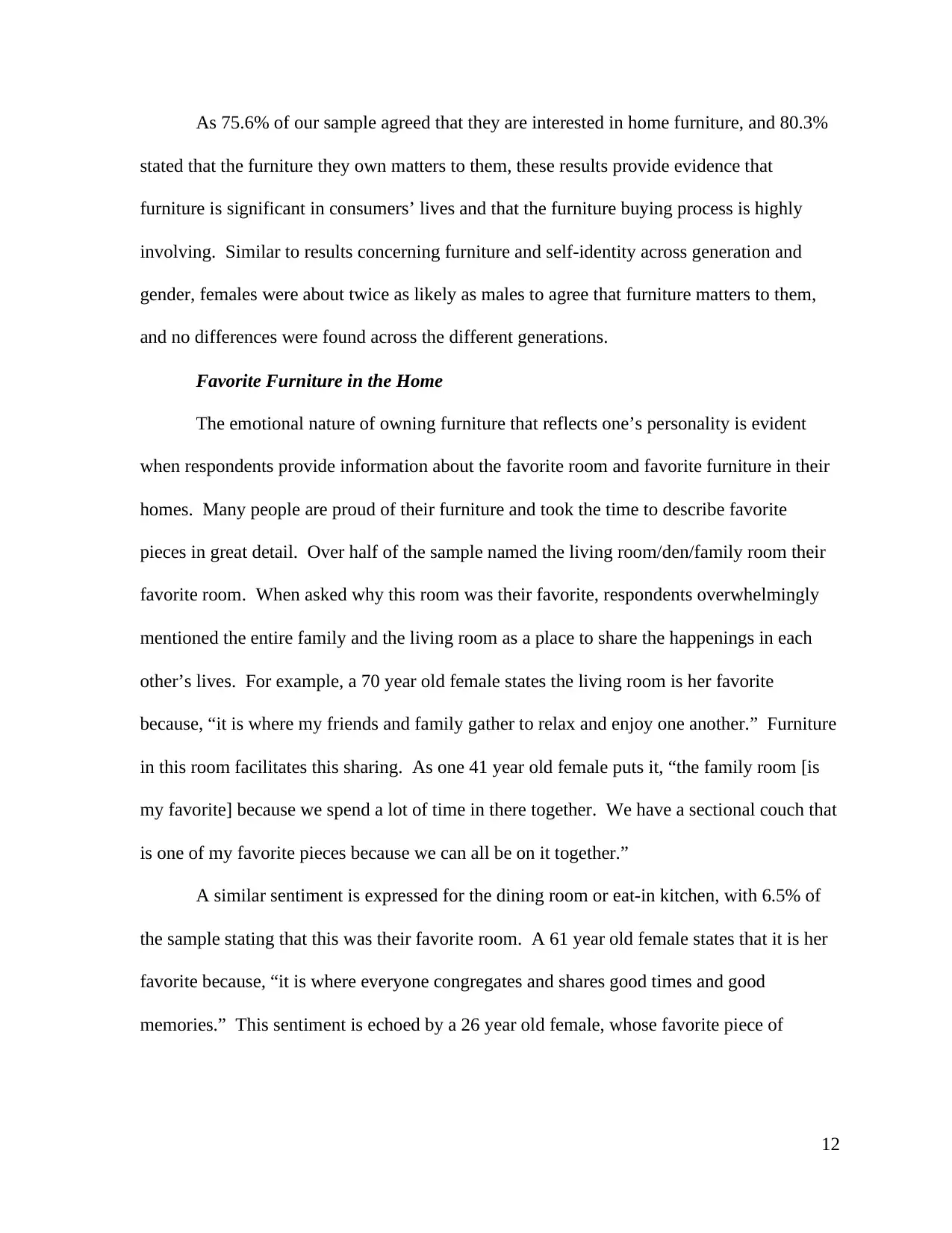
12
As 75.6% of our sample agreed that they are interested in home furniture, and 80.3%
stated that the furniture they own matters to them, these results provide evidence that
furniture is significant in consumers’ lives and that the furniture buying process is highly
involving. Similar to results concerning furniture and self-identity across generation and
gender, females were about twice as likely as males to agree that furniture matters to them,
and no differences were found across the different generations.
Favorite Furniture in the Home
The emotional nature of owning furniture that reflects one’s personality is evident
when respondents provide information about the favorite room and favorite furniture in their
homes. Many people are proud of their furniture and took the time to describe favorite
pieces in great detail. Over half of the sample named the living room/den/family room their
favorite room. When asked why this room was their favorite, respondents overwhelmingly
mentioned the entire family and the living room as a place to share the happenings in each
other’s lives. For example, a 70 year old female states the living room is her favorite
because, “it is where my friends and family gather to relax and enjoy one another.” Furniture
in this room facilitates this sharing. As one 41 year old female puts it, “the family room [is
my favorite] because we spend a lot of time in there together. We have a sectional couch that
is one of my favorite pieces because we can all be on it together.”
A similar sentiment is expressed for the dining room or eat-in kitchen, with 6.5% of
the sample stating that this was their favorite room. A 61 year old female states that it is her
favorite because, “it is where everyone congregates and shares good times and good
memories.” This sentiment is echoed by a 26 year old female, whose favorite piece of
As 75.6% of our sample agreed that they are interested in home furniture, and 80.3%
stated that the furniture they own matters to them, these results provide evidence that
furniture is significant in consumers’ lives and that the furniture buying process is highly
involving. Similar to results concerning furniture and self-identity across generation and
gender, females were about twice as likely as males to agree that furniture matters to them,
and no differences were found across the different generations.
Favorite Furniture in the Home
The emotional nature of owning furniture that reflects one’s personality is evident
when respondents provide information about the favorite room and favorite furniture in their
homes. Many people are proud of their furniture and took the time to describe favorite
pieces in great detail. Over half of the sample named the living room/den/family room their
favorite room. When asked why this room was their favorite, respondents overwhelmingly
mentioned the entire family and the living room as a place to share the happenings in each
other’s lives. For example, a 70 year old female states the living room is her favorite
because, “it is where my friends and family gather to relax and enjoy one another.” Furniture
in this room facilitates this sharing. As one 41 year old female puts it, “the family room [is
my favorite] because we spend a lot of time in there together. We have a sectional couch that
is one of my favorite pieces because we can all be on it together.”
A similar sentiment is expressed for the dining room or eat-in kitchen, with 6.5% of
the sample stating that this was their favorite room. A 61 year old female states that it is her
favorite because, “it is where everyone congregates and shares good times and good
memories.” This sentiment is echoed by a 26 year old female, whose favorite piece of
Secure Best Marks with AI Grader
Need help grading? Try our AI Grader for instant feedback on your assignments.

13
furniture is the dining room table because, “it is where we eat together as a family and it is
also where we do family activities like carving pumpkins and school projects.”
While living rooms and dining areas facilitate togetherness with family and friends,
the master bedroom is a favorite of 28% of our sample because it represents relaxation and
privacy. A 69 year old male states that the master bedroom is his favorite:
“Because it has beautiful oak furniture. It was our first purchase when we got
married. It cost a lot and is very beautiful and sturdy. Very beautiful and is a very
nice room to sleep in. The furniture definitely makes it my favorite.”
This quote is particularly telling in that a 69 year old man refers to his bedroom furniture as
“beautiful” three times within a handful of sentences. In addition, there is a sentimental
attachment present due to the fact that the bedroom set was their first purchase as husband
and wife.
Frequency of Purchase Decisions
While a majority of our sample is interested in home furniture and agrees that their
furniture reflects their personality, it is not a decision that is made with great frequency. For
example, when asked their level of agreement with the statement, “I like to replace some of
my furniture every few years,” only 35.1% of respondents agreed. Likewise, only 18.4%
agreed that, “I change my furniture often to keep up with design trends.” Alternately, when
asked, “I expect my furniture to last for many years,” a sizeable 95.1% of respondents agreed
(which is up from 87.4% in 2008), with 53.2% strongly agreeing with this statement. When
asked about level of agreement about keeping wood and upholstered furniture for a long
time, 92.4% agreed that they plan to keep their wood furniture for a long time, while 86.9%
agreed that they plan to keep their upholstered furniture for a long time. What constitutes a
long time? The most frequently reported category for wood furniture was “over 15 years,”
furniture is the dining room table because, “it is where we eat together as a family and it is
also where we do family activities like carving pumpkins and school projects.”
While living rooms and dining areas facilitate togetherness with family and friends,
the master bedroom is a favorite of 28% of our sample because it represents relaxation and
privacy. A 69 year old male states that the master bedroom is his favorite:
“Because it has beautiful oak furniture. It was our first purchase when we got
married. It cost a lot and is very beautiful and sturdy. Very beautiful and is a very
nice room to sleep in. The furniture definitely makes it my favorite.”
This quote is particularly telling in that a 69 year old man refers to his bedroom furniture as
“beautiful” three times within a handful of sentences. In addition, there is a sentimental
attachment present due to the fact that the bedroom set was their first purchase as husband
and wife.
Frequency of Purchase Decisions
While a majority of our sample is interested in home furniture and agrees that their
furniture reflects their personality, it is not a decision that is made with great frequency. For
example, when asked their level of agreement with the statement, “I like to replace some of
my furniture every few years,” only 35.1% of respondents agreed. Likewise, only 18.4%
agreed that, “I change my furniture often to keep up with design trends.” Alternately, when
asked, “I expect my furniture to last for many years,” a sizeable 95.1% of respondents agreed
(which is up from 87.4% in 2008), with 53.2% strongly agreeing with this statement. When
asked about level of agreement about keeping wood and upholstered furniture for a long
time, 92.4% agreed that they plan to keep their wood furniture for a long time, while 86.9%
agreed that they plan to keep their upholstered furniture for a long time. What constitutes a
long time? The most frequently reported category for wood furniture was “over 15 years,”

14
while the most frequently reported category for upholstered furniture was “7-10 years.” As
one 61 year old female puts it, “You are the one who is going to live with it, like a husband
you want it to last a long time!”
In sum, while the decision to purchase new furniture is not made with great
frequency, it is an important decision that involves the whole family. People care about their
furniture because, as one 41 year old female stated, “Your furniture has to be where your
family feels comfortable and able to relax. With the world so stressful, having a place just to
relax is very important.” This high level of importance means that consumers will move
through the stages of the consumer decision process with careful consideration. How and
where they gather information is discussed below in greater detail.
Information Search
After the need for furniture is recognized, consumers engage in a search for
information about the products/services that can satisfy those needs. While information is
usually gathered to satisfy a pending need or solve a current problem at hand, consumers may
also gather information simply because they enjoy furniture but do not have a specific need
for it. Half of the respondents in our sample (50.1%) agreed that they like to shop for
furniture, even if they do not have a specific need. This figure is up from the 35.4% of
respondents five years ago who agreed with the same statement. These respondents are
mainly women, not surprisingly. Considering generational groups, just over half of Gen X
and Gen Y respondents we surveyed like to shop for furniture regardless of need, while only
a third of the Depression/Pre-Depression generation does.
When gathering information to make a purchase decision, two key pieces of
information are necessary: the evaluative criteria, or features of the furniture that are sought
while the most frequently reported category for upholstered furniture was “7-10 years.” As
one 61 year old female puts it, “You are the one who is going to live with it, like a husband
you want it to last a long time!”
In sum, while the decision to purchase new furniture is not made with great
frequency, it is an important decision that involves the whole family. People care about their
furniture because, as one 41 year old female stated, “Your furniture has to be where your
family feels comfortable and able to relax. With the world so stressful, having a place just to
relax is very important.” This high level of importance means that consumers will move
through the stages of the consumer decision process with careful consideration. How and
where they gather information is discussed below in greater detail.
Information Search
After the need for furniture is recognized, consumers engage in a search for
information about the products/services that can satisfy those needs. While information is
usually gathered to satisfy a pending need or solve a current problem at hand, consumers may
also gather information simply because they enjoy furniture but do not have a specific need
for it. Half of the respondents in our sample (50.1%) agreed that they like to shop for
furniture, even if they do not have a specific need. This figure is up from the 35.4% of
respondents five years ago who agreed with the same statement. These respondents are
mainly women, not surprisingly. Considering generational groups, just over half of Gen X
and Gen Y respondents we surveyed like to shop for furniture regardless of need, while only
a third of the Depression/Pre-Depression generation does.
When gathering information to make a purchase decision, two key pieces of
information are necessary: the evaluative criteria, or features of the furniture that are sought

15
by the consumer; and the consideration set, or brands of furniture being considered for
purchase. Detailed information about evaluative criteria and consideration sets are provided
below.
Evaluative Criteria
The evaluative criteria of “made in the U.S.A.” and “environmentally-friendly
furniture” were examined in the survey in greater detail, as the potential marketability of
these features is of particular interest to U.S. furniture manufacturers. Table 5 provides
results from a series of questions related to U.S. manufactured furniture. When presented
with the statement, “I try to buy furniture only if it is made in the United States,” 57.8% of
our sample agreed. Level of agreement did vary by generational group and region of the
country where the respondent lived. Specifically, agreement increased with age, with the
Depression/Pre-Depression generations most likely to strongly agree with this statement.
Further, Southerners and Midwesterners were more likely to agree with this statement than
those from the West and Northeast. Similar results were found for the statement, “I am
willing to pay more money if the furniture is made in the U.S.A.” (see Table 11). 58.2% of
respondents agreed with this statement, with agreement increasing with age, as well as for
Southerners and Midwesterners.
The questions appearing in Table 5 asked about furniture manufactured in the U.S.A.
versus other countries in general. To ascertain attitudes about American made furniture
versus furniture made in China specifically, the survey also contained the following scenario:
“Suppose a sofa that you really like costs $800 and is made in China. How much more are
you willing to pay for the sofa if it is made in the U.S.A.?” 43.2% of respondents would not
be willing to pay any more than $800 for the sofa, 19.8% would be willing to pay $850 for
by the consumer; and the consideration set, or brands of furniture being considered for
purchase. Detailed information about evaluative criteria and consideration sets are provided
below.
Evaluative Criteria
The evaluative criteria of “made in the U.S.A.” and “environmentally-friendly
furniture” were examined in the survey in greater detail, as the potential marketability of
these features is of particular interest to U.S. furniture manufacturers. Table 5 provides
results from a series of questions related to U.S. manufactured furniture. When presented
with the statement, “I try to buy furniture only if it is made in the United States,” 57.8% of
our sample agreed. Level of agreement did vary by generational group and region of the
country where the respondent lived. Specifically, agreement increased with age, with the
Depression/Pre-Depression generations most likely to strongly agree with this statement.
Further, Southerners and Midwesterners were more likely to agree with this statement than
those from the West and Northeast. Similar results were found for the statement, “I am
willing to pay more money if the furniture is made in the U.S.A.” (see Table 11). 58.2% of
respondents agreed with this statement, with agreement increasing with age, as well as for
Southerners and Midwesterners.
The questions appearing in Table 5 asked about furniture manufactured in the U.S.A.
versus other countries in general. To ascertain attitudes about American made furniture
versus furniture made in China specifically, the survey also contained the following scenario:
“Suppose a sofa that you really like costs $800 and is made in China. How much more are
you willing to pay for the sofa if it is made in the U.S.A.?” 43.2% of respondents would not
be willing to pay any more than $800 for the sofa, 19.8% would be willing to pay $850 for
Paraphrase This Document
Need a fresh take? Get an instant paraphrase of this document with our AI Paraphraser

16
the sofa, 16.9% would be willing to pay $900 for the sofa, 6.1% would be willing to pay
$950 for the sofa, 8.7% would be willing to pay $1,000 for the sofa, and 5.2% would be
willing to pay more than $1,000 for the sofa. No differences were found across gender or
generational group, but Midwesterners were more likely to pay up to $200 more for the sofa
and Southerners were more likely to pay $1,000 or more for the sofa if it is made in the
U.S.A.
TABLE 5
Support for Furniture Made in the U.S.A.
Item
Thinking about where
your furniture is made…
STA*
(7)
A
(6)
SLA
(5)
N
(4)
SLD
(3)
D
(2)
STD
(1)
I try to buy furniture only if
it is made in the United
States.
14.4% 24.3% 19.1% 25.4% 5.0% 7.2% 4.7%
It may cost more in the
long-run, but I prefer to
support American-made
furniture.
17.4% 25.9% 22.4% 23.6% 3.4% 3.6% 3.7%
It is always best to support
American furniture
manufacturers.
25.0% 28.3% 19.5% 20.1% 2.2% 2.2% 2.6%
We should purchase
furniture made in the U.S.A.
instead of furniture made in
other countries.
24.6% 26.6% 18.5% 22.0% 2.8% 2.7% 2.7%
* STA=strongly agree, A=agree, SLA=slightly agree, N=neither agree nor disagree, SLD=slightly disagree,
D=disagree, STD=strongly disagree
n=2,007
Attitudes towards environmentally-friendly furniture were also assessed. On the
survey, the term “environmentally-friendly” was intentionally not specifically defined, so
respondents were left to interpret its meaning on their own. Table 6 provides results from a
the sofa, 16.9% would be willing to pay $900 for the sofa, 6.1% would be willing to pay
$950 for the sofa, 8.7% would be willing to pay $1,000 for the sofa, and 5.2% would be
willing to pay more than $1,000 for the sofa. No differences were found across gender or
generational group, but Midwesterners were more likely to pay up to $200 more for the sofa
and Southerners were more likely to pay $1,000 or more for the sofa if it is made in the
U.S.A.
TABLE 5
Support for Furniture Made in the U.S.A.
Item
Thinking about where
your furniture is made…
STA*
(7)
A
(6)
SLA
(5)
N
(4)
SLD
(3)
D
(2)
STD
(1)
I try to buy furniture only if
it is made in the United
States.
14.4% 24.3% 19.1% 25.4% 5.0% 7.2% 4.7%
It may cost more in the
long-run, but I prefer to
support American-made
furniture.
17.4% 25.9% 22.4% 23.6% 3.4% 3.6% 3.7%
It is always best to support
American furniture
manufacturers.
25.0% 28.3% 19.5% 20.1% 2.2% 2.2% 2.6%
We should purchase
furniture made in the U.S.A.
instead of furniture made in
other countries.
24.6% 26.6% 18.5% 22.0% 2.8% 2.7% 2.7%
* STA=strongly agree, A=agree, SLA=slightly agree, N=neither agree nor disagree, SLD=slightly disagree,
D=disagree, STD=strongly disagree
n=2,007
Attitudes towards environmentally-friendly furniture were also assessed. On the
survey, the term “environmentally-friendly” was intentionally not specifically defined, so
respondents were left to interpret its meaning on their own. Table 6 provides results from a

17
series of questions related to environmentally-friendly furniture. In general, respondents
agreed more with supporting furniture made in the U.S.A. over environmentally-friendly
furniture. Note, however, that the “Neither Agree nor Disagree” category was the one most
chosen for the statements in Table 6. This is likely due to the vagueness of the term.
TABLE 6
Support for Environmentally-Friendly Furniture
Item
How do you feel about
furniture and the
environment? Please
answer the following.
STA*
(7)
A
(6)
SLA
(5)
N
(4)
SLD
(3)
D
(2)
STD
(1)
I want my furniture to be
environmentally-friendly.
9.2% 22.0% 21.7% 37.5% 2.4% 4.2% 2.9%
I feel a moral obligation to
buy environmentally-
friendly furniture for my
home.
6.6% 13.3% 17.3% 31.3% 10.7% 11.4% 9.4%
I will not buy furniture from
a company that is
ecologically irresponsible.
7.0% 13.3% 15.6% 38.9% 10.2% 7.6% 7.4%
I would be willing to stop
buying furniture from
companies who pollute the
environment even though it
might be inconvenient for
me.
11.0% 18.9% 19.2% 30.3% 7.3% 6.3% 7.1%
* STA=strongly agree, A=agree, SLA=slightly agree, N=neither agree nor disagree, SLD=slightly disagree,
D=disagree, STD=strongly disagree
n=2,007
Further, the survey contained a scenario similar to the question about American made
furniture versus furniture made in China: “Suppose a sofa that you really like cost $800 and
is made with materials that have a negative impact on the environment. How much more are
series of questions related to environmentally-friendly furniture. In general, respondents
agreed more with supporting furniture made in the U.S.A. over environmentally-friendly
furniture. Note, however, that the “Neither Agree nor Disagree” category was the one most
chosen for the statements in Table 6. This is likely due to the vagueness of the term.
TABLE 6
Support for Environmentally-Friendly Furniture
Item
How do you feel about
furniture and the
environment? Please
answer the following.
STA*
(7)
A
(6)
SLA
(5)
N
(4)
SLD
(3)
D
(2)
STD
(1)
I want my furniture to be
environmentally-friendly.
9.2% 22.0% 21.7% 37.5% 2.4% 4.2% 2.9%
I feel a moral obligation to
buy environmentally-
friendly furniture for my
home.
6.6% 13.3% 17.3% 31.3% 10.7% 11.4% 9.4%
I will not buy furniture from
a company that is
ecologically irresponsible.
7.0% 13.3% 15.6% 38.9% 10.2% 7.6% 7.4%
I would be willing to stop
buying furniture from
companies who pollute the
environment even though it
might be inconvenient for
me.
11.0% 18.9% 19.2% 30.3% 7.3% 6.3% 7.1%
* STA=strongly agree, A=agree, SLA=slightly agree, N=neither agree nor disagree, SLD=slightly disagree,
D=disagree, STD=strongly disagree
n=2,007
Further, the survey contained a scenario similar to the question about American made
furniture versus furniture made in China: “Suppose a sofa that you really like cost $800 and
is made with materials that have a negative impact on the environment. How much more are

18
you willing to pay for the sofa if it is made with environmentally-friendly materials?” 47.2%
of respondents would not be willing to pay any more than $800 for the sofa, 19.6% would be
willing to pay $850 for the sofa, 16.5% would be willing to pay $900 for the sofa, 4.9%
would be willing to pay $950 for the sofa, 7.7% would be willing to pay $1,000 for the sofa,
and 4.1% would be willing to pay more than $1,000 for the sofa. Interestingly, generational
differences were uncovered for this question. The majority of Baby Boomers (50.9%) and
the Depression/Pre-Depression generations (58.6%) would not be willing to pay any more
than $800 for an environmentally-friendly sofa, but the majority of Gen Y (58.7%) and Gen
X (55.7%) were willing to pay at least some amount greater than $800 for the sofa. More
discussion on marketing furniture made in the U.S.A. and environmentally-friendly furniture
to different generational groups may be found in the Recommendations section.
Consideration Set
A consideration set may be defined as those brands that a consumer will consider
purchasing. These are the brands that get appraised along the evaluative criteria most
important to consumers. Similar to results obtained five years ago, consumers are not
particularly loyal to specific furniture brands. A majority of respondents (77.9%) either
disagreed or were neutral about the statement, “I am very loyal to specific brands of
furniture.” Respondents also tended to disagree with the statement, “I stick with just a
couple of brands of furniture that I know I like.” 76.3% of respondents disagreed with this,
and only 3.1% strongly agreed with this statement (down from 5% in 2008). Also similar to
the prior survey, while older people are usually more brand loyal in general, brand loyalty
did not vary by age here.
you willing to pay for the sofa if it is made with environmentally-friendly materials?” 47.2%
of respondents would not be willing to pay any more than $800 for the sofa, 19.6% would be
willing to pay $850 for the sofa, 16.5% would be willing to pay $900 for the sofa, 4.9%
would be willing to pay $950 for the sofa, 7.7% would be willing to pay $1,000 for the sofa,
and 4.1% would be willing to pay more than $1,000 for the sofa. Interestingly, generational
differences were uncovered for this question. The majority of Baby Boomers (50.9%) and
the Depression/Pre-Depression generations (58.6%) would not be willing to pay any more
than $800 for an environmentally-friendly sofa, but the majority of Gen Y (58.7%) and Gen
X (55.7%) were willing to pay at least some amount greater than $800 for the sofa. More
discussion on marketing furniture made in the U.S.A. and environmentally-friendly furniture
to different generational groups may be found in the Recommendations section.
Consideration Set
A consideration set may be defined as those brands that a consumer will consider
purchasing. These are the brands that get appraised along the evaluative criteria most
important to consumers. Similar to results obtained five years ago, consumers are not
particularly loyal to specific furniture brands. A majority of respondents (77.9%) either
disagreed or were neutral about the statement, “I am very loyal to specific brands of
furniture.” Respondents also tended to disagree with the statement, “I stick with just a
couple of brands of furniture that I know I like.” 76.3% of respondents disagreed with this,
and only 3.1% strongly agreed with this statement (down from 5% in 2008). Also similar to
the prior survey, while older people are usually more brand loyal in general, brand loyalty
did not vary by age here.
Secure Best Marks with AI Grader
Need help grading? Try our AI Grader for instant feedback on your assignments.
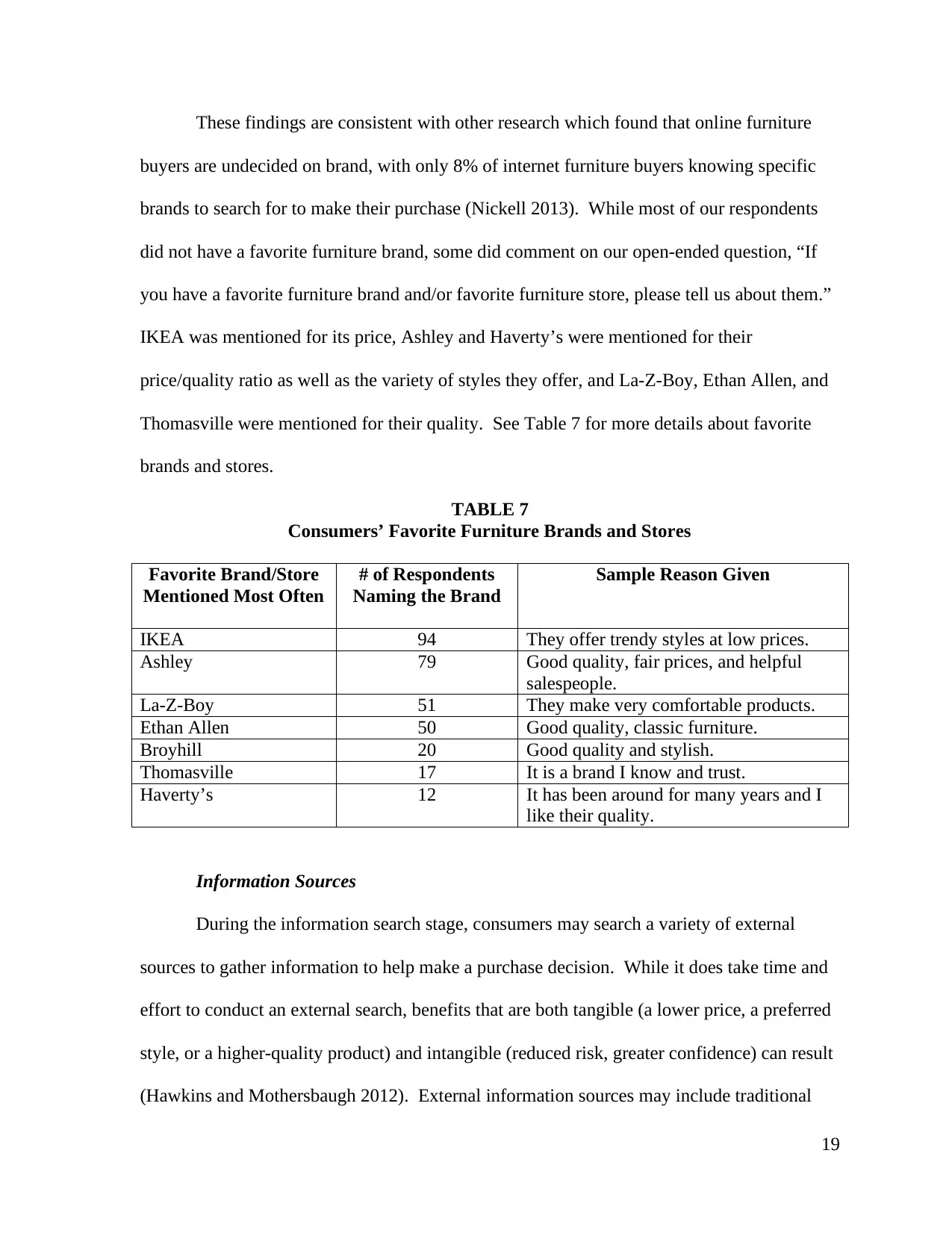
19
These findings are consistent with other research which found that online furniture
buyers are undecided on brand, with only 8% of internet furniture buyers knowing specific
brands to search for to make their purchase (Nickell 2013). While most of our respondents
did not have a favorite furniture brand, some did comment on our open-ended question, “If
you have a favorite furniture brand and/or favorite furniture store, please tell us about them.”
IKEA was mentioned for its price, Ashley and Haverty’s were mentioned for their
price/quality ratio as well as the variety of styles they offer, and La-Z-Boy, Ethan Allen, and
Thomasville were mentioned for their quality. See Table 7 for more details about favorite
brands and stores.
TABLE 7
Consumers’ Favorite Furniture Brands and Stores
Favorite Brand/Store
Mentioned Most Often
# of Respondents
Naming the Brand
Sample Reason Given
IKEA 94 They offer trendy styles at low prices.
Ashley 79 Good quality, fair prices, and helpful
salespeople.
La-Z-Boy 51 They make very comfortable products.
Ethan Allen 50 Good quality, classic furniture.
Broyhill 20 Good quality and stylish.
Thomasville 17 It is a brand I know and trust.
Haverty’s 12 It has been around for many years and I
like their quality.
Information Sources
During the information search stage, consumers may search a variety of external
sources to gather information to help make a purchase decision. While it does take time and
effort to conduct an external search, benefits that are both tangible (a lower price, a preferred
style, or a higher-quality product) and intangible (reduced risk, greater confidence) can result
(Hawkins and Mothersbaugh 2012). External information sources may include traditional
These findings are consistent with other research which found that online furniture
buyers are undecided on brand, with only 8% of internet furniture buyers knowing specific
brands to search for to make their purchase (Nickell 2013). While most of our respondents
did not have a favorite furniture brand, some did comment on our open-ended question, “If
you have a favorite furniture brand and/or favorite furniture store, please tell us about them.”
IKEA was mentioned for its price, Ashley and Haverty’s were mentioned for their
price/quality ratio as well as the variety of styles they offer, and La-Z-Boy, Ethan Allen, and
Thomasville were mentioned for their quality. See Table 7 for more details about favorite
brands and stores.
TABLE 7
Consumers’ Favorite Furniture Brands and Stores
Favorite Brand/Store
Mentioned Most Often
# of Respondents
Naming the Brand
Sample Reason Given
IKEA 94 They offer trendy styles at low prices.
Ashley 79 Good quality, fair prices, and helpful
salespeople.
La-Z-Boy 51 They make very comfortable products.
Ethan Allen 50 Good quality, classic furniture.
Broyhill 20 Good quality and stylish.
Thomasville 17 It is a brand I know and trust.
Haverty’s 12 It has been around for many years and I
like their quality.
Information Sources
During the information search stage, consumers may search a variety of external
sources to gather information to help make a purchase decision. While it does take time and
effort to conduct an external search, benefits that are both tangible (a lower price, a preferred
style, or a higher-quality product) and intangible (reduced risk, greater confidence) can result
(Hawkins and Mothersbaugh 2012). External information sources may include traditional

20
media, the internet, social media, and interpersonal sources, such as consulting family
members or friends. Traditional media sources include advertisements on television and in
magazines, sales catalogs or brochures, as well as home decorating-themed magazines and
television programming. Table 8 shows the percentage of respondents who engage in search
via each of these traditional media sources. Also provided in this table are results from the
2008 furniture study. While the traditional media sources of television and magazine
advertising did not fare very well five years ago, it seems that people are more likely to pay
attention to these sources now. Watching home decorating themed shows and reading home
magazines also rose compared to five years ago.
TABLE 8
The Role of Traditional Media in Information Search
Survey Item
When I gather information on furniture
before making a purchase decision…
% of
sample
who
agree
(2013)1
% of
sample
who
agree
(2008)2
Mean
(2013)3
Mean
(2008)3
I pay attention to television ads. 50.7% 34.9% 4.16 3.78
I watch home decorating themed programs
on television (such as HGTV).
48.7% 41.8% 4.00 3.93
I pay attention to magazine ads. 42.7% 37.1% 3.87 3.81
I read lifestyle and home magazines. 41.2% 30.2% 3.71 3.50
I gather information from catalogs and/or
sales brochures.
47.0% 45.2% 4.05 4.10
1 n=2,007
2 n=2,012
3 seven point scale ranging from 1 (strongly disagree) to 7 (strongly agree)
Not surprisingly, gender differences exist for watching home decorating themed
television programming and reading home magazines, with women enjoying these activities
more than men. Generational differences are also found for these two activities, along with
media, the internet, social media, and interpersonal sources, such as consulting family
members or friends. Traditional media sources include advertisements on television and in
magazines, sales catalogs or brochures, as well as home decorating-themed magazines and
television programming. Table 8 shows the percentage of respondents who engage in search
via each of these traditional media sources. Also provided in this table are results from the
2008 furniture study. While the traditional media sources of television and magazine
advertising did not fare very well five years ago, it seems that people are more likely to pay
attention to these sources now. Watching home decorating themed shows and reading home
magazines also rose compared to five years ago.
TABLE 8
The Role of Traditional Media in Information Search
Survey Item
When I gather information on furniture
before making a purchase decision…
% of
sample
who
agree
(2013)1
% of
sample
who
agree
(2008)2
Mean
(2013)3
Mean
(2008)3
I pay attention to television ads. 50.7% 34.9% 4.16 3.78
I watch home decorating themed programs
on television (such as HGTV).
48.7% 41.8% 4.00 3.93
I pay attention to magazine ads. 42.7% 37.1% 3.87 3.81
I read lifestyle and home magazines. 41.2% 30.2% 3.71 3.50
I gather information from catalogs and/or
sales brochures.
47.0% 45.2% 4.05 4.10
1 n=2,007
2 n=2,012
3 seven point scale ranging from 1 (strongly disagree) to 7 (strongly agree)
Not surprisingly, gender differences exist for watching home decorating themed
television programming and reading home magazines, with women enjoying these activities
more than men. Generational differences are also found for these two activities, along with
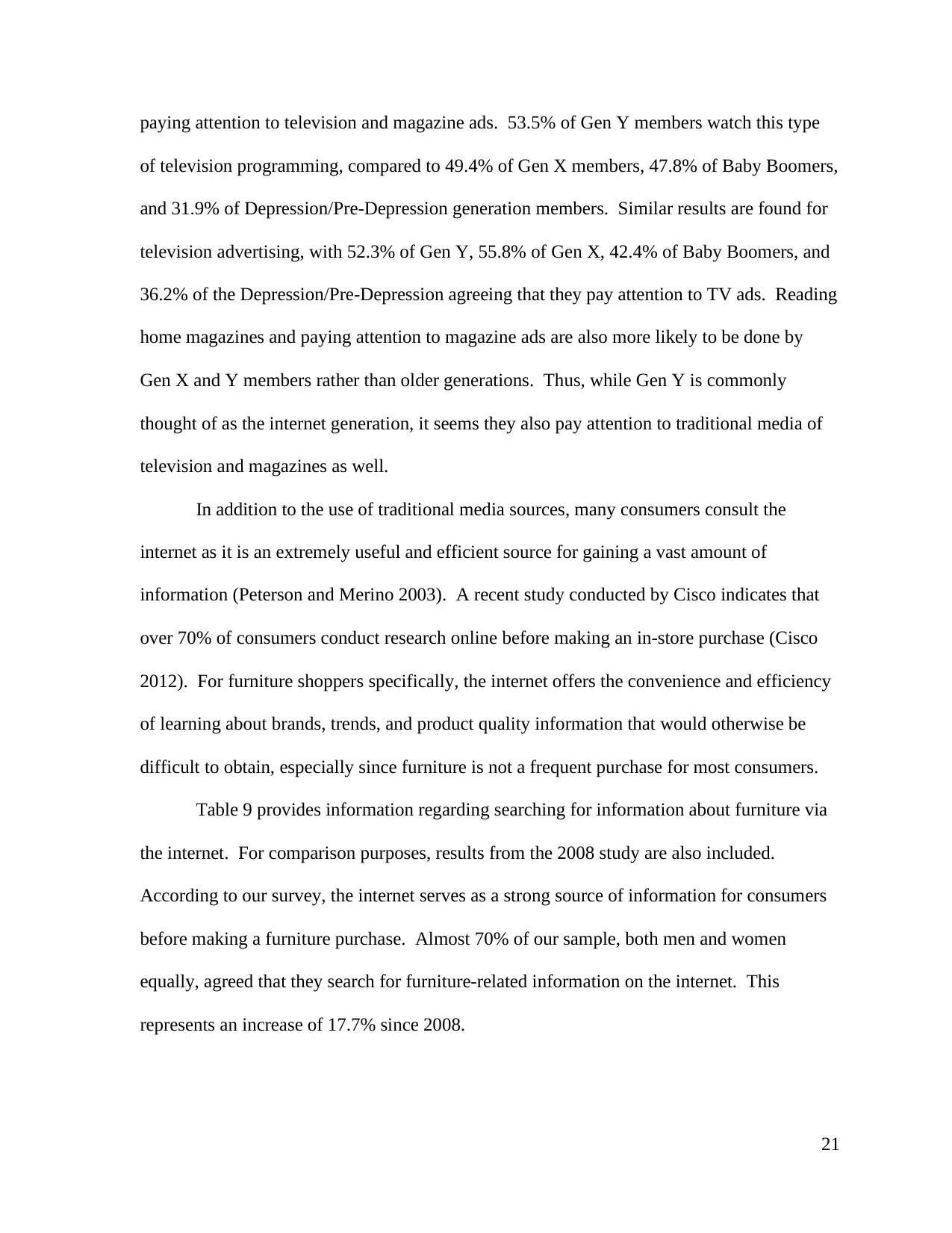
21
paying attention to television and magazine ads. 53.5% of Gen Y members watch this type
of television programming, compared to 49.4% of Gen X members, 47.8% of Baby Boomers,
and 31.9% of Depression/Pre-Depression generation members. Similar results are found for
television advertising, with 52.3% of Gen Y, 55.8% of Gen X, 42.4% of Baby Boomers, and
36.2% of the Depression/Pre-Depression agreeing that they pay attention to TV ads. Reading
home magazines and paying attention to magazine ads are also more likely to be done by
Gen X and Y members rather than older generations. Thus, while Gen Y is commonly
thought of as the internet generation, it seems they also pay attention to traditional media of
television and magazines as well.
In addition to the use of traditional media sources, many consumers consult the
internet as it is an extremely useful and efficient source for gaining a vast amount of
information (Peterson and Merino 2003). A recent study conducted by Cisco indicates that
over 70% of consumers conduct research online before making an in-store purchase (Cisco
2012). For furniture shoppers specifically, the internet offers the convenience and efficiency
of learning about brands, trends, and product quality information that would otherwise be
difficult to obtain, especially since furniture is not a frequent purchase for most consumers.
Table 9 provides information regarding searching for information about furniture via
the internet. For comparison purposes, results from the 2008 study are also included.
According to our survey, the internet serves as a strong source of information for consumers
before making a furniture purchase. Almost 70% of our sample, both men and women
equally, agreed that they search for furniture-related information on the internet. This
represents an increase of 17.7% since 2008.
paying attention to television and magazine ads. 53.5% of Gen Y members watch this type
of television programming, compared to 49.4% of Gen X members, 47.8% of Baby Boomers,
and 31.9% of Depression/Pre-Depression generation members. Similar results are found for
television advertising, with 52.3% of Gen Y, 55.8% of Gen X, 42.4% of Baby Boomers, and
36.2% of the Depression/Pre-Depression agreeing that they pay attention to TV ads. Reading
home magazines and paying attention to magazine ads are also more likely to be done by
Gen X and Y members rather than older generations. Thus, while Gen Y is commonly
thought of as the internet generation, it seems they also pay attention to traditional media of
television and magazines as well.
In addition to the use of traditional media sources, many consumers consult the
internet as it is an extremely useful and efficient source for gaining a vast amount of
information (Peterson and Merino 2003). A recent study conducted by Cisco indicates that
over 70% of consumers conduct research online before making an in-store purchase (Cisco
2012). For furniture shoppers specifically, the internet offers the convenience and efficiency
of learning about brands, trends, and product quality information that would otherwise be
difficult to obtain, especially since furniture is not a frequent purchase for most consumers.
Table 9 provides information regarding searching for information about furniture via
the internet. For comparison purposes, results from the 2008 study are also included.
According to our survey, the internet serves as a strong source of information for consumers
before making a furniture purchase. Almost 70% of our sample, both men and women
equally, agreed that they search for furniture-related information on the internet. This
represents an increase of 17.7% since 2008.
Paraphrase This Document
Need a fresh take? Get an instant paraphrase of this document with our AI Paraphraser
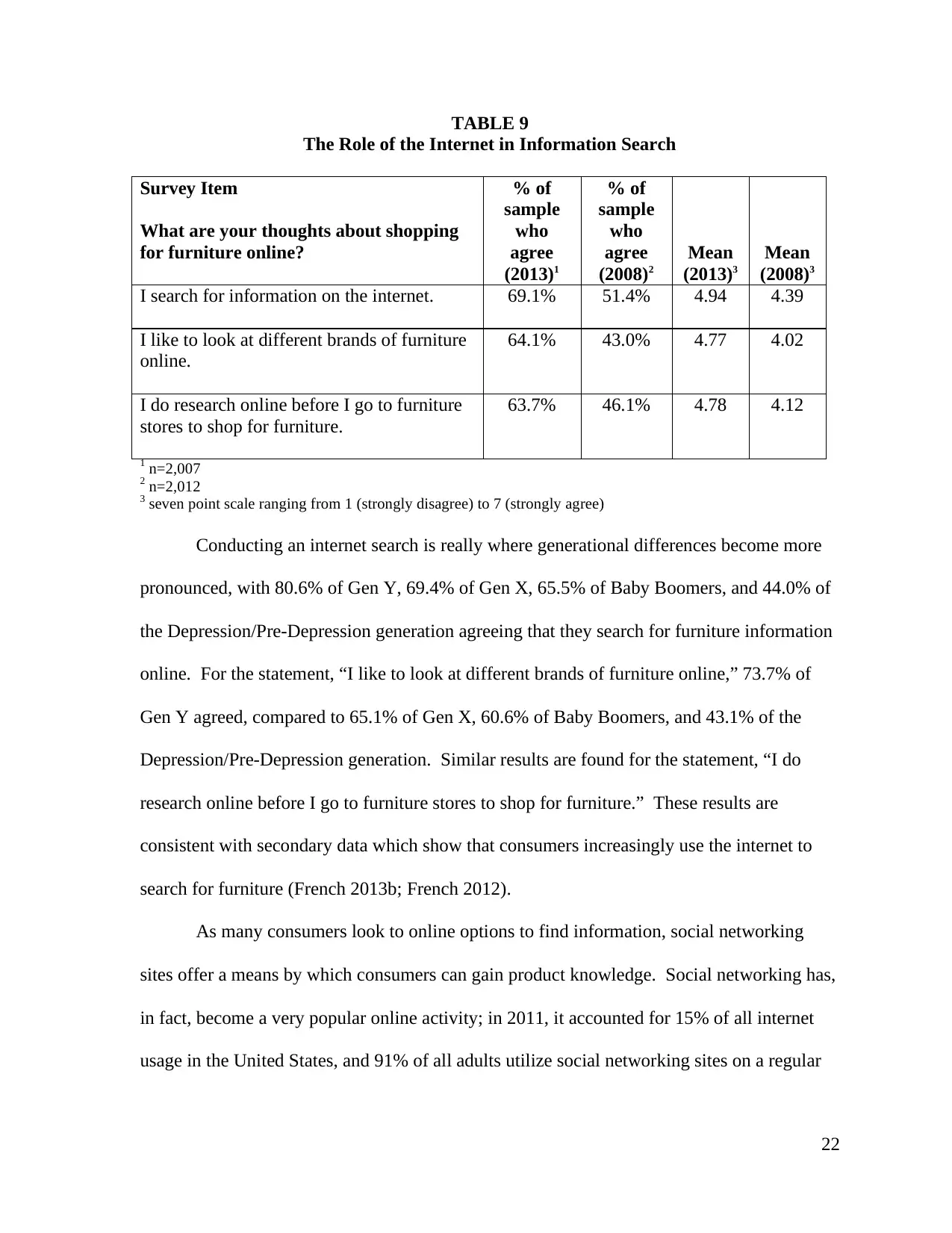
22
TABLE 9
The Role of the Internet in Information Search
Survey Item
What are your thoughts about shopping
for furniture online?
% of
sample
who
agree
(2013)1
% of
sample
who
agree
(2008)2
Mean
(2013)3
Mean
(2008)3
I search for information on the internet. 69.1% 51.4% 4.94 4.39
I like to look at different brands of furniture
online.
64.1% 43.0% 4.77 4.02
I do research online before I go to furniture
stores to shop for furniture.
63.7% 46.1% 4.78 4.12
1 n=2,007
2 n=2,012
3 seven point scale ranging from 1 (strongly disagree) to 7 (strongly agree)
Conducting an internet search is really where generational differences become more
pronounced, with 80.6% of Gen Y, 69.4% of Gen X, 65.5% of Baby Boomers, and 44.0% of
the Depression/Pre-Depression generation agreeing that they search for furniture information
online. For the statement, “I like to look at different brands of furniture online,” 73.7% of
Gen Y agreed, compared to 65.1% of Gen X, 60.6% of Baby Boomers, and 43.1% of the
Depression/Pre-Depression generation. Similar results are found for the statement, “I do
research online before I go to furniture stores to shop for furniture.” These results are
consistent with secondary data which show that consumers increasingly use the internet to
search for furniture (French 2013b; French 2012).
As many consumers look to online options to find information, social networking
sites offer a means by which consumers can gain product knowledge. Social networking has,
in fact, become a very popular online activity; in 2011, it accounted for 15% of all internet
usage in the United States, and 91% of all adults utilize social networking sites on a regular
TABLE 9
The Role of the Internet in Information Search
Survey Item
What are your thoughts about shopping
for furniture online?
% of
sample
who
agree
(2013)1
% of
sample
who
agree
(2008)2
Mean
(2013)3
Mean
(2008)3
I search for information on the internet. 69.1% 51.4% 4.94 4.39
I like to look at different brands of furniture
online.
64.1% 43.0% 4.77 4.02
I do research online before I go to furniture
stores to shop for furniture.
63.7% 46.1% 4.78 4.12
1 n=2,007
2 n=2,012
3 seven point scale ranging from 1 (strongly disagree) to 7 (strongly agree)
Conducting an internet search is really where generational differences become more
pronounced, with 80.6% of Gen Y, 69.4% of Gen X, 65.5% of Baby Boomers, and 44.0% of
the Depression/Pre-Depression generation agreeing that they search for furniture information
online. For the statement, “I like to look at different brands of furniture online,” 73.7% of
Gen Y agreed, compared to 65.1% of Gen X, 60.6% of Baby Boomers, and 43.1% of the
Depression/Pre-Depression generation. Similar results are found for the statement, “I do
research online before I go to furniture stores to shop for furniture.” These results are
consistent with secondary data which show that consumers increasingly use the internet to
search for furniture (French 2013b; French 2012).
As many consumers look to online options to find information, social networking
sites offer a means by which consumers can gain product knowledge. Social networking has,
in fact, become a very popular online activity; in 2011, it accounted for 15% of all internet
usage in the United States, and 91% of all adults utilize social networking sites on a regular

23
basis (Moscaritolo 2012). Popular sites include Tumblr, Twitter, Pinterest, LinkedIn and
Facebook (Notess 2012).
Social networks allow people to connect with others who share similar tastes and
interests (Heinrichs, Lim, and Lim 2011; York 2011). Not only do people connect with
strangers with whom they share commonalities, but also have access to information shared
by friends, family members and acquaintances via social networking. For the purposes of
this study, respondents were asked specifically about searching Pinterest for information. In
the United States, Pinterest is now ranked third in popularity amongst social networking sites
(following only Facebook and Twitter) (Moscaritolo 2012). The site is also noted as the
social network that retailers should be most aware of and attentive to (Moscaritolo 2012).
Pinterest allows users to share pictures, links and web-content via online pinboards. For a
new account, default boards include “For the Home” and “Products I Love” (Notess 2012).
Based on this format that allows for sharing and ‘pinning,’ consumers who are in the market
for furniture can browse the site for ideas, get feedback from other users, and view boards
like “For the Home” on others’ accounts in order increase their knowledge of furniture styles
and brands.
Table 10 shows results related to the use of Pinterest as a source of information about
furniture before making a purchase decision. Only a small portion of respondents, just under
15%, use Pinterest for this type of information. No gender differences were found, but, as
expected, the use of Pinterest is by far an activity for younger generations. Pinterest is used
for furniture ideas by about 27% of Gen Y, 16% of Gen X, 8% of Baby Boomers, and only
3% of the Depression/Pre-Depression generation.
basis (Moscaritolo 2012). Popular sites include Tumblr, Twitter, Pinterest, LinkedIn and
Facebook (Notess 2012).
Social networks allow people to connect with others who share similar tastes and
interests (Heinrichs, Lim, and Lim 2011; York 2011). Not only do people connect with
strangers with whom they share commonalities, but also have access to information shared
by friends, family members and acquaintances via social networking. For the purposes of
this study, respondents were asked specifically about searching Pinterest for information. In
the United States, Pinterest is now ranked third in popularity amongst social networking sites
(following only Facebook and Twitter) (Moscaritolo 2012). The site is also noted as the
social network that retailers should be most aware of and attentive to (Moscaritolo 2012).
Pinterest allows users to share pictures, links and web-content via online pinboards. For a
new account, default boards include “For the Home” and “Products I Love” (Notess 2012).
Based on this format that allows for sharing and ‘pinning,’ consumers who are in the market
for furniture can browse the site for ideas, get feedback from other users, and view boards
like “For the Home” on others’ accounts in order increase their knowledge of furniture styles
and brands.
Table 10 shows results related to the use of Pinterest as a source of information about
furniture before making a purchase decision. Only a small portion of respondents, just under
15%, use Pinterest for this type of information. No gender differences were found, but, as
expected, the use of Pinterest is by far an activity for younger generations. Pinterest is used
for furniture ideas by about 27% of Gen Y, 16% of Gen X, 8% of Baby Boomers, and only
3% of the Depression/Pre-Depression generation.

24
TABLE 10
Social Media as an Information Source
Survey Item
When I gather information on furniture before making a
purchase decision…
% of
sample
who
agree
Mean*
I use Pinterest to pin furniture or decorating ideas to my page. 14.9% 2.38
I use Pinterest to look at furniture or decorating ideas on other
people’s pinboards.
14.8% 2.38
I use Pinterest to follow other users who pin furniture or decorating
ideas to their pinboard.
13.4% 2.33
*Based on a seven point scale ranging from 1 (strongly disagree) to 7 (strongly agree)
Finally, regarding interpersonal sources of information, consumers either have
confidence in their ability to decorate a home, or they have confidence in their ability to find
the appropriate sources without asking the opinions of others such as friends and family.
Only 3.3% of our sample strongly agreed with the statement, “I ask others about the furniture
in their homes,” and only 2.5% strongly agreed that they mainly rely on family or friends to
give them advice on what to buy. Gen Y members are the group most likely to get other
peoples’ opinions before they buy a piece of furniture. This is likely due to the fact that since
they are younger, they do not have as much experience with selecting furniture as older
generations (Hawkins and Mothersbaugh 2012).
Alternative Evaluation
Once consumers gather information about their evaluative criteria and brands in their
consideration set, alternative evaluation occurs when the consumer makes comparisons and
judges the abilities of each selected brand to perform according to the consumer’s most
TABLE 10
Social Media as an Information Source
Survey Item
When I gather information on furniture before making a
purchase decision…
% of
sample
who
agree
Mean*
I use Pinterest to pin furniture or decorating ideas to my page. 14.9% 2.38
I use Pinterest to look at furniture or decorating ideas on other
people’s pinboards.
14.8% 2.38
I use Pinterest to follow other users who pin furniture or decorating
ideas to their pinboard.
13.4% 2.33
*Based on a seven point scale ranging from 1 (strongly disagree) to 7 (strongly agree)
Finally, regarding interpersonal sources of information, consumers either have
confidence in their ability to decorate a home, or they have confidence in their ability to find
the appropriate sources without asking the opinions of others such as friends and family.
Only 3.3% of our sample strongly agreed with the statement, “I ask others about the furniture
in their homes,” and only 2.5% strongly agreed that they mainly rely on family or friends to
give them advice on what to buy. Gen Y members are the group most likely to get other
peoples’ opinions before they buy a piece of furniture. This is likely due to the fact that since
they are younger, they do not have as much experience with selecting furniture as older
generations (Hawkins and Mothersbaugh 2012).
Alternative Evaluation
Once consumers gather information about their evaluative criteria and brands in their
consideration set, alternative evaluation occurs when the consumer makes comparisons and
judges the abilities of each selected brand to perform according to the consumer’s most
Secure Best Marks with AI Grader
Need help grading? Try our AI Grader for instant feedback on your assignments.
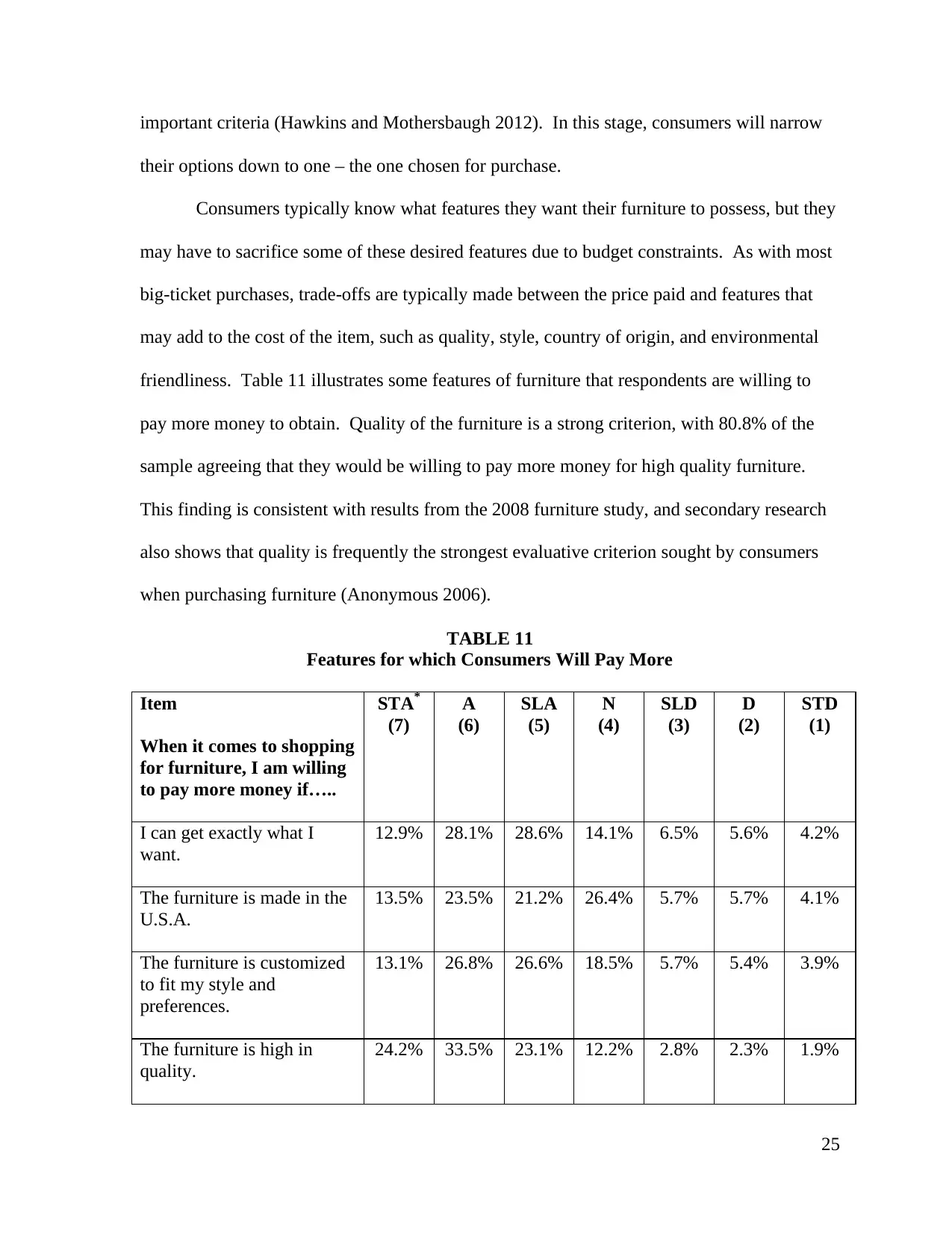
25
important criteria (Hawkins and Mothersbaugh 2012). In this stage, consumers will narrow
their options down to one – the one chosen for purchase.
Consumers typically know what features they want their furniture to possess, but they
may have to sacrifice some of these desired features due to budget constraints. As with most
big-ticket purchases, trade-offs are typically made between the price paid and features that
may add to the cost of the item, such as quality, style, country of origin, and environmental
friendliness. Table 11 illustrates some features of furniture that respondents are willing to
pay more money to obtain. Quality of the furniture is a strong criterion, with 80.8% of the
sample agreeing that they would be willing to pay more money for high quality furniture.
This finding is consistent with results from the 2008 furniture study, and secondary research
also shows that quality is frequently the strongest evaluative criterion sought by consumers
when purchasing furniture (Anonymous 2006).
TABLE 11
Features for which Consumers Will Pay More
Item
When it comes to shopping
for furniture, I am willing
to pay more money if…..
STA*
(7)
A
(6)
SLA
(5)
N
(4)
SLD
(3)
D
(2)
STD
(1)
I can get exactly what I
want.
12.9% 28.1% 28.6% 14.1% 6.5% 5.6% 4.2%
The furniture is made in the
U.S.A.
13.5% 23.5% 21.2% 26.4% 5.7% 5.7% 4.1%
The furniture is customized
to fit my style and
preferences.
13.1% 26.8% 26.6% 18.5% 5.7% 5.4% 3.9%
The furniture is high in
quality.
24.2% 33.5% 23.1% 12.2% 2.8% 2.3% 1.9%
important criteria (Hawkins and Mothersbaugh 2012). In this stage, consumers will narrow
their options down to one – the one chosen for purchase.
Consumers typically know what features they want their furniture to possess, but they
may have to sacrifice some of these desired features due to budget constraints. As with most
big-ticket purchases, trade-offs are typically made between the price paid and features that
may add to the cost of the item, such as quality, style, country of origin, and environmental
friendliness. Table 11 illustrates some features of furniture that respondents are willing to
pay more money to obtain. Quality of the furniture is a strong criterion, with 80.8% of the
sample agreeing that they would be willing to pay more money for high quality furniture.
This finding is consistent with results from the 2008 furniture study, and secondary research
also shows that quality is frequently the strongest evaluative criterion sought by consumers
when purchasing furniture (Anonymous 2006).
TABLE 11
Features for which Consumers Will Pay More
Item
When it comes to shopping
for furniture, I am willing
to pay more money if…..
STA*
(7)
A
(6)
SLA
(5)
N
(4)
SLD
(3)
D
(2)
STD
(1)
I can get exactly what I
want.
12.9% 28.1% 28.6% 14.1% 6.5% 5.6% 4.2%
The furniture is made in the
U.S.A.
13.5% 23.5% 21.2% 26.4% 5.7% 5.7% 4.1%
The furniture is customized
to fit my style and
preferences.
13.1% 26.8% 26.6% 18.5% 5.7% 5.4% 3.9%
The furniture is high in
quality.
24.2% 33.5% 23.1% 12.2% 2.8% 2.3% 1.9%

26
The furniture is made with
environmentally-friendly
materials.
9.8% 19.8% 20.8% 31.4% 6.7% 6.2% 5.3%
* STA=strongly agree, A=agree, SLA=slightly agree, N=neither agree nor disagree, SLD=slightly disagree,
D=disagree, STD=strongly disagree
n=2,007
As another illustration of the importance of furniture quality to respondents, when
asked to rank four features in order of importance (quality, price, made in the U.S.A., and
environmental friendliness), quality was selected as most important by 53.2% of the sample
(up from 46.1% in 2008), while price was ranked as most important by 31.2% of
respondents. The ranking of quality as the number one feature did not vary by gender or
generational group.
Over half of the sample ranked “furniture made with environmentally-friendly
materials” as last among the four features, but there were some differences in this across
generations. Gen Y was more likely to rank “made in the U.S.A.” as last and
“environmentally-friendly” as third behind quality and then price. The fact that Gen Y seems
to value environmentally-friendly furniture more than furniture made in the U.S.A. represents
a shift in sentiment that manufacturers and retailers need to be aware of.
In a separate rank-order question, respondents were asked to consider the four
features of furniture style, price, the brand name of the furniture, and made in the U.S.A.
This time, more respondents chose style of the furniture over its price, with 45% ranking
style as most important and 35.4% ranking price as most important. This does not hold true
when comparing Gen Y to the other generations, however. For Gen Y members, price just
edged out style, with 44.7% of Gen Y ranking price as number one and 43.3% ranking style
as number one.
The furniture is made with
environmentally-friendly
materials.
9.8% 19.8% 20.8% 31.4% 6.7% 6.2% 5.3%
* STA=strongly agree, A=agree, SLA=slightly agree, N=neither agree nor disagree, SLD=slightly disagree,
D=disagree, STD=strongly disagree
n=2,007
As another illustration of the importance of furniture quality to respondents, when
asked to rank four features in order of importance (quality, price, made in the U.S.A., and
environmental friendliness), quality was selected as most important by 53.2% of the sample
(up from 46.1% in 2008), while price was ranked as most important by 31.2% of
respondents. The ranking of quality as the number one feature did not vary by gender or
generational group.
Over half of the sample ranked “furniture made with environmentally-friendly
materials” as last among the four features, but there were some differences in this across
generations. Gen Y was more likely to rank “made in the U.S.A.” as last and
“environmentally-friendly” as third behind quality and then price. The fact that Gen Y seems
to value environmentally-friendly furniture more than furniture made in the U.S.A. represents
a shift in sentiment that manufacturers and retailers need to be aware of.
In a separate rank-order question, respondents were asked to consider the four
features of furniture style, price, the brand name of the furniture, and made in the U.S.A.
This time, more respondents chose style of the furniture over its price, with 45% ranking
style as most important and 35.4% ranking price as most important. This does not hold true
when comparing Gen Y to the other generations, however. For Gen Y members, price just
edged out style, with 44.7% of Gen Y ranking price as number one and 43.3% ranking style
as number one.
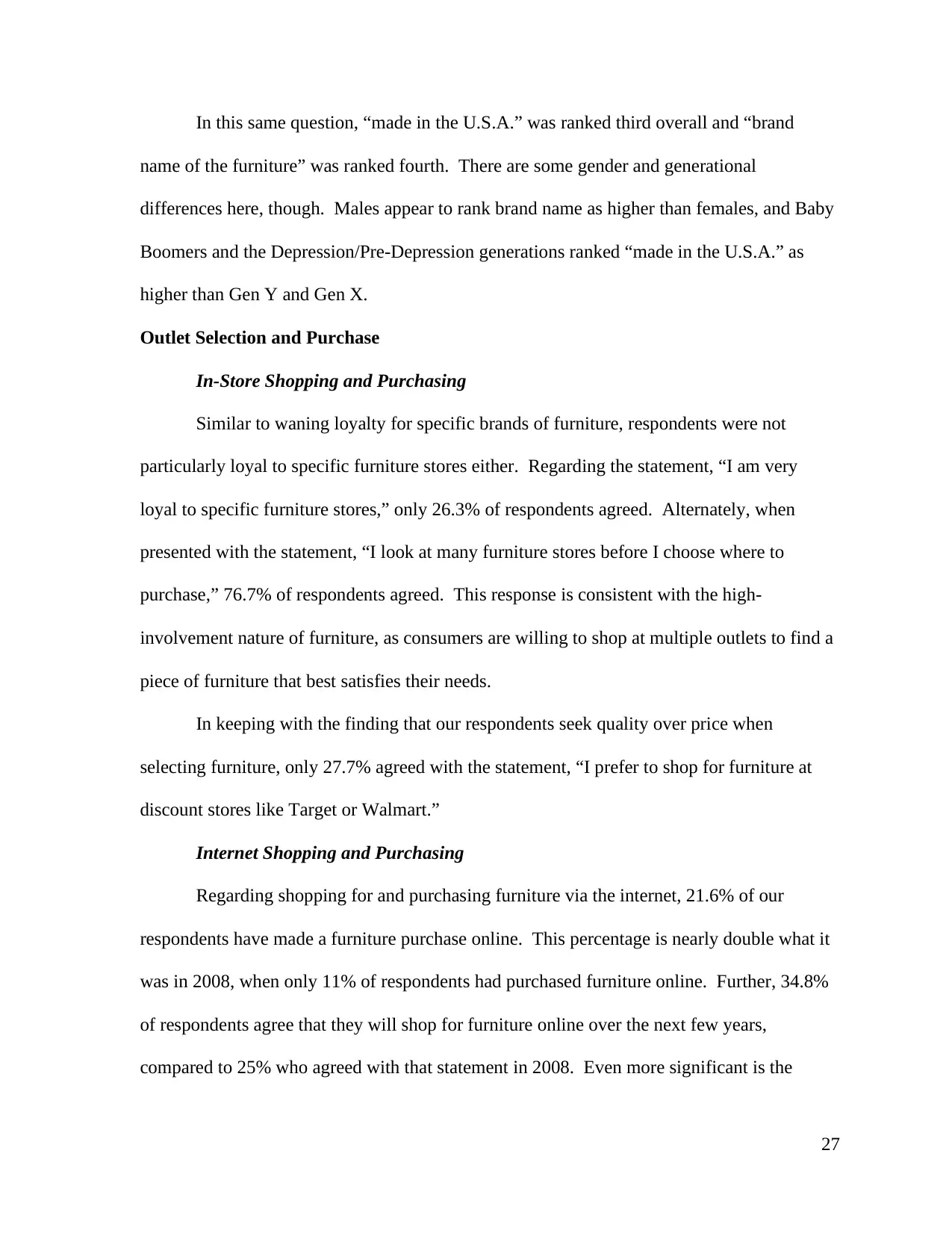
27
In this same question, “made in the U.S.A.” was ranked third overall and “brand
name of the furniture” was ranked fourth. There are some gender and generational
differences here, though. Males appear to rank brand name as higher than females, and Baby
Boomers and the Depression/Pre-Depression generations ranked “made in the U.S.A.” as
higher than Gen Y and Gen X.
Outlet Selection and Purchase
In-Store Shopping and Purchasing
Similar to waning loyalty for specific brands of furniture, respondents were not
particularly loyal to specific furniture stores either. Regarding the statement, “I am very
loyal to specific furniture stores,” only 26.3% of respondents agreed. Alternately, when
presented with the statement, “I look at many furniture stores before I choose where to
purchase,” 76.7% of respondents agreed. This response is consistent with the high-
involvement nature of furniture, as consumers are willing to shop at multiple outlets to find a
piece of furniture that best satisfies their needs.
In keeping with the finding that our respondents seek quality over price when
selecting furniture, only 27.7% agreed with the statement, “I prefer to shop for furniture at
discount stores like Target or Walmart.”
Internet Shopping and Purchasing
Regarding shopping for and purchasing furniture via the internet, 21.6% of our
respondents have made a furniture purchase online. This percentage is nearly double what it
was in 2008, when only 11% of respondents had purchased furniture online. Further, 34.8%
of respondents agree that they will shop for furniture online over the next few years,
compared to 25% who agreed with that statement in 2008. Even more significant is the
In this same question, “made in the U.S.A.” was ranked third overall and “brand
name of the furniture” was ranked fourth. There are some gender and generational
differences here, though. Males appear to rank brand name as higher than females, and Baby
Boomers and the Depression/Pre-Depression generations ranked “made in the U.S.A.” as
higher than Gen Y and Gen X.
Outlet Selection and Purchase
In-Store Shopping and Purchasing
Similar to waning loyalty for specific brands of furniture, respondents were not
particularly loyal to specific furniture stores either. Regarding the statement, “I am very
loyal to specific furniture stores,” only 26.3% of respondents agreed. Alternately, when
presented with the statement, “I look at many furniture stores before I choose where to
purchase,” 76.7% of respondents agreed. This response is consistent with the high-
involvement nature of furniture, as consumers are willing to shop at multiple outlets to find a
piece of furniture that best satisfies their needs.
In keeping with the finding that our respondents seek quality over price when
selecting furniture, only 27.7% agreed with the statement, “I prefer to shop for furniture at
discount stores like Target or Walmart.”
Internet Shopping and Purchasing
Regarding shopping for and purchasing furniture via the internet, 21.6% of our
respondents have made a furniture purchase online. This percentage is nearly double what it
was in 2008, when only 11% of respondents had purchased furniture online. Further, 34.8%
of respondents agree that they will shop for furniture online over the next few years,
compared to 25% who agreed with that statement in 2008. Even more significant is the
Paraphrase This Document
Need a fresh take? Get an instant paraphrase of this document with our AI Paraphraser

28
number of respondents who stated that they are willing to purchase furniture online – 1,044,
or 52.0% of respondents. This represents a major shift in attitudes towards shopping for and
purchasing furniture via the internet. Secondary research supports this finding, as
consumers are becoming more comfortable with making a furniture purchase online (York
2010).
Regarding intentions to shop for furniture online over the next few years, generational
differences are especially pronounced, with 46.9% of Gen Y, 36.7% of Gen X, 28.8% of
Baby Boomers, and 17.2% of the Depression/Pre-Depression generation agreeing with this
statement. Of those who have already made a furniture purchase online, 34% are Gen Y
members, 29.6% are Gen X members, 32.4% are Baby Boomers, and 3.9% come from the
Depression/Pre-Depression generation. These percentages are nearly the same of those who
say they are willing to purchase furniture online.
Post-Purchase Evaluation
Post-purchase evaluation occurs when the consumer has had a chance to use the
product and make some evaluations in comparison to initial expectations. Cognitive
dissonance, defined as a feeling of self-doubt, remorse, and uneasiness after a purchase, may
occur in this stage of the decision process, and it is more likely to occur for products that are
considered important to the consumer, given their costs, and the fact that the decision is
relatively irreversible (Oliver 1997). Oftentimes, this anxiety is induced as a result of having
to choose one alternative over all others (Festinger 1957). While choosing furniture is an
important and emotional decision, respondents do not really feel this “buyer’s remorse” after
a furniture purchase; only 13% of our sample indicated that they get this feeling (down from
17.7% in the 2008 study). This low number may be attributed to the considerable time and
number of respondents who stated that they are willing to purchase furniture online – 1,044,
or 52.0% of respondents. This represents a major shift in attitudes towards shopping for and
purchasing furniture via the internet. Secondary research supports this finding, as
consumers are becoming more comfortable with making a furniture purchase online (York
2010).
Regarding intentions to shop for furniture online over the next few years, generational
differences are especially pronounced, with 46.9% of Gen Y, 36.7% of Gen X, 28.8% of
Baby Boomers, and 17.2% of the Depression/Pre-Depression generation agreeing with this
statement. Of those who have already made a furniture purchase online, 34% are Gen Y
members, 29.6% are Gen X members, 32.4% are Baby Boomers, and 3.9% come from the
Depression/Pre-Depression generation. These percentages are nearly the same of those who
say they are willing to purchase furniture online.
Post-Purchase Evaluation
Post-purchase evaluation occurs when the consumer has had a chance to use the
product and make some evaluations in comparison to initial expectations. Cognitive
dissonance, defined as a feeling of self-doubt, remorse, and uneasiness after a purchase, may
occur in this stage of the decision process, and it is more likely to occur for products that are
considered important to the consumer, given their costs, and the fact that the decision is
relatively irreversible (Oliver 1997). Oftentimes, this anxiety is induced as a result of having
to choose one alternative over all others (Festinger 1957). While choosing furniture is an
important and emotional decision, respondents do not really feel this “buyer’s remorse” after
a furniture purchase; only 13% of our sample indicated that they get this feeling (down from
17.7% in the 2008 study). This low number may be attributed to the considerable time and
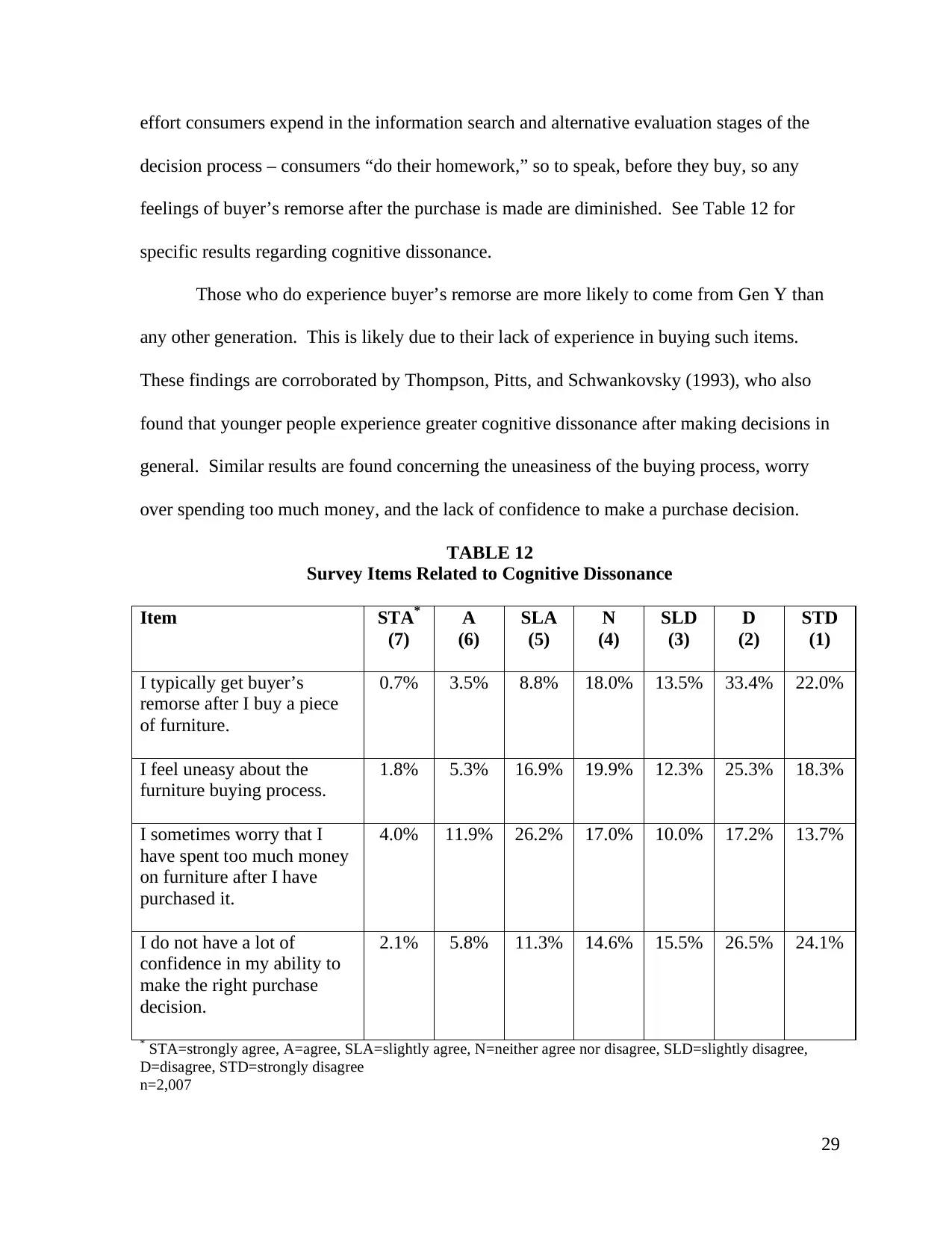
29
effort consumers expend in the information search and alternative evaluation stages of the
decision process – consumers “do their homework,” so to speak, before they buy, so any
feelings of buyer’s remorse after the purchase is made are diminished. See Table 12 for
specific results regarding cognitive dissonance.
Those who do experience buyer’s remorse are more likely to come from Gen Y than
any other generation. This is likely due to their lack of experience in buying such items.
These findings are corroborated by Thompson, Pitts, and Schwankovsky (1993), who also
found that younger people experience greater cognitive dissonance after making decisions in
general. Similar results are found concerning the uneasiness of the buying process, worry
over spending too much money, and the lack of confidence to make a purchase decision.
TABLE 12
Survey Items Related to Cognitive Dissonance
Item STA*
(7)
A
(6)
SLA
(5)
N
(4)
SLD
(3)
D
(2)
STD
(1)
I typically get buyer’s
remorse after I buy a piece
of furniture.
0.7% 3.5% 8.8% 18.0% 13.5% 33.4% 22.0%
I feel uneasy about the
furniture buying process.
1.8% 5.3% 16.9% 19.9% 12.3% 25.3% 18.3%
I sometimes worry that I
have spent too much money
on furniture after I have
purchased it.
4.0% 11.9% 26.2% 17.0% 10.0% 17.2% 13.7%
I do not have a lot of
confidence in my ability to
make the right purchase
decision.
2.1% 5.8% 11.3% 14.6% 15.5% 26.5% 24.1%
* STA=strongly agree, A=agree, SLA=slightly agree, N=neither agree nor disagree, SLD=slightly disagree,
D=disagree, STD=strongly disagree
n=2,007
effort consumers expend in the information search and alternative evaluation stages of the
decision process – consumers “do their homework,” so to speak, before they buy, so any
feelings of buyer’s remorse after the purchase is made are diminished. See Table 12 for
specific results regarding cognitive dissonance.
Those who do experience buyer’s remorse are more likely to come from Gen Y than
any other generation. This is likely due to their lack of experience in buying such items.
These findings are corroborated by Thompson, Pitts, and Schwankovsky (1993), who also
found that younger people experience greater cognitive dissonance after making decisions in
general. Similar results are found concerning the uneasiness of the buying process, worry
over spending too much money, and the lack of confidence to make a purchase decision.
TABLE 12
Survey Items Related to Cognitive Dissonance
Item STA*
(7)
A
(6)
SLA
(5)
N
(4)
SLD
(3)
D
(2)
STD
(1)
I typically get buyer’s
remorse after I buy a piece
of furniture.
0.7% 3.5% 8.8% 18.0% 13.5% 33.4% 22.0%
I feel uneasy about the
furniture buying process.
1.8% 5.3% 16.9% 19.9% 12.3% 25.3% 18.3%
I sometimes worry that I
have spent too much money
on furniture after I have
purchased it.
4.0% 11.9% 26.2% 17.0% 10.0% 17.2% 13.7%
I do not have a lot of
confidence in my ability to
make the right purchase
decision.
2.1% 5.8% 11.3% 14.6% 15.5% 26.5% 24.1%
* STA=strongly agree, A=agree, SLA=slightly agree, N=neither agree nor disagree, SLD=slightly disagree,
D=disagree, STD=strongly disagree
n=2,007
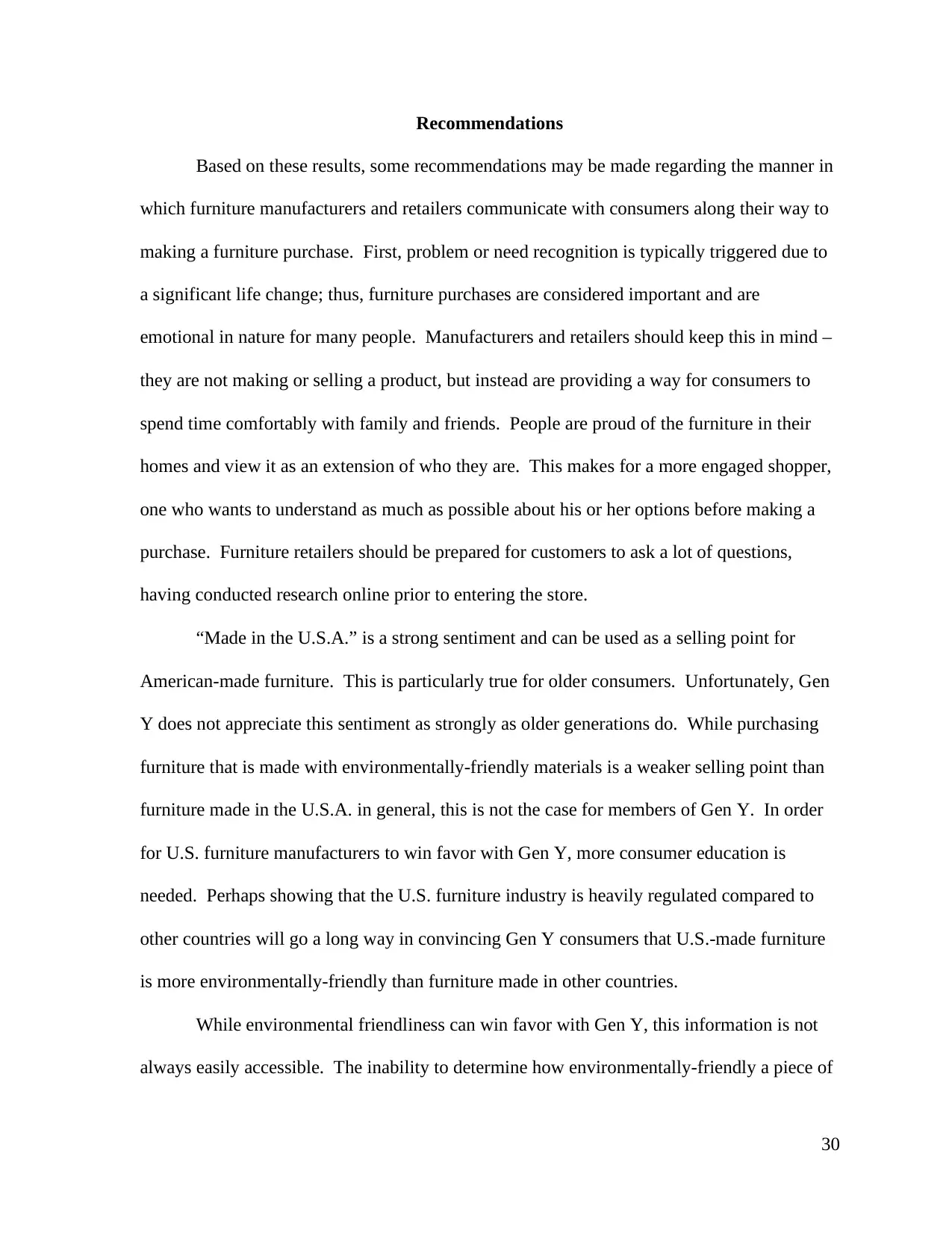
30
Recommendations
Based on these results, some recommendations may be made regarding the manner in
which furniture manufacturers and retailers communicate with consumers along their way to
making a furniture purchase. First, problem or need recognition is typically triggered due to
a significant life change; thus, furniture purchases are considered important and are
emotional in nature for many people. Manufacturers and retailers should keep this in mind –
they are not making or selling a product, but instead are providing a way for consumers to
spend time comfortably with family and friends. People are proud of the furniture in their
homes and view it as an extension of who they are. This makes for a more engaged shopper,
one who wants to understand as much as possible about his or her options before making a
purchase. Furniture retailers should be prepared for customers to ask a lot of questions,
having conducted research online prior to entering the store.
“Made in the U.S.A.” is a strong sentiment and can be used as a selling point for
American-made furniture. This is particularly true for older consumers. Unfortunately, Gen
Y does not appreciate this sentiment as strongly as older generations do. While purchasing
furniture that is made with environmentally-friendly materials is a weaker selling point than
furniture made in the U.S.A. in general, this is not the case for members of Gen Y. In order
for U.S. furniture manufacturers to win favor with Gen Y, more consumer education is
needed. Perhaps showing that the U.S. furniture industry is heavily regulated compared to
other countries will go a long way in convincing Gen Y consumers that U.S.-made furniture
is more environmentally-friendly than furniture made in other countries.
While environmental friendliness can win favor with Gen Y, this information is not
always easily accessible. The inability to determine how environmentally-friendly a piece of
Recommendations
Based on these results, some recommendations may be made regarding the manner in
which furniture manufacturers and retailers communicate with consumers along their way to
making a furniture purchase. First, problem or need recognition is typically triggered due to
a significant life change; thus, furniture purchases are considered important and are
emotional in nature for many people. Manufacturers and retailers should keep this in mind –
they are not making or selling a product, but instead are providing a way for consumers to
spend time comfortably with family and friends. People are proud of the furniture in their
homes and view it as an extension of who they are. This makes for a more engaged shopper,
one who wants to understand as much as possible about his or her options before making a
purchase. Furniture retailers should be prepared for customers to ask a lot of questions,
having conducted research online prior to entering the store.
“Made in the U.S.A.” is a strong sentiment and can be used as a selling point for
American-made furniture. This is particularly true for older consumers. Unfortunately, Gen
Y does not appreciate this sentiment as strongly as older generations do. While purchasing
furniture that is made with environmentally-friendly materials is a weaker selling point than
furniture made in the U.S.A. in general, this is not the case for members of Gen Y. In order
for U.S. furniture manufacturers to win favor with Gen Y, more consumer education is
needed. Perhaps showing that the U.S. furniture industry is heavily regulated compared to
other countries will go a long way in convincing Gen Y consumers that U.S.-made furniture
is more environmentally-friendly than furniture made in other countries.
While environmental friendliness can win favor with Gen Y, this information is not
always easily accessible. The inability to determine how environmentally-friendly a piece of
Secure Best Marks with AI Grader
Need help grading? Try our AI Grader for instant feedback on your assignments.

31
furniture is could lead to frustration among consumers. One 34 year old multicultural female
made this comment at the end of her survey:
“It is sometimes difficult to find environmentally friendly items – or know if they are.
It would be nice if more companies clearly labeled how/what something is made out
of and where it is made. It is not easy lifting a bookshelf or chair to read a tiny
sticker underneath!”
The obvious recommendation here again comes back to education. Manufacturers
should provide clear and detailed information regarding the materials used to create the
furniture, and not require the consumer to work hard to obtain it.
Furniture quality continues to reign supreme as an important evaluative criterion.
Educating consumers on how to specifically evaluate quality in furniture will help to ensure
them that the piece of furniture they choose will last a long time. The fact that 43.2% of
respondents indicated that they would not be willing to pay any more money for a sofa made
in the U.S.A. versus a sofa made in China is evidence that consumers need to be more
educated in evaluating quality, if that is indeed the most important criterion when making a
furniture purchase.
Fortunately, furniture manufacturers and retailers have a variety of information
sources at their disposal to communicate with and educate consumers. Television advertising
as well as networks such as HGTV can target women of all ages. Home magazines and
magazine ads will also do well to reach members of Gen Y and Gen X, as will social media.
Regarding content of promotional messages, furniture manufacturers and retailers
should consider the integral role that furniture plays in the consumer’s self-concept. The
open-ended comments provided in Table 4 as well as the descriptions given of favorite
furniture demonstrate how furniture can create happy memories with family and friends in
furniture is could lead to frustration among consumers. One 34 year old multicultural female
made this comment at the end of her survey:
“It is sometimes difficult to find environmentally friendly items – or know if they are.
It would be nice if more companies clearly labeled how/what something is made out
of and where it is made. It is not easy lifting a bookshelf or chair to read a tiny
sticker underneath!”
The obvious recommendation here again comes back to education. Manufacturers
should provide clear and detailed information regarding the materials used to create the
furniture, and not require the consumer to work hard to obtain it.
Furniture quality continues to reign supreme as an important evaluative criterion.
Educating consumers on how to specifically evaluate quality in furniture will help to ensure
them that the piece of furniture they choose will last a long time. The fact that 43.2% of
respondents indicated that they would not be willing to pay any more money for a sofa made
in the U.S.A. versus a sofa made in China is evidence that consumers need to be more
educated in evaluating quality, if that is indeed the most important criterion when making a
furniture purchase.
Fortunately, furniture manufacturers and retailers have a variety of information
sources at their disposal to communicate with and educate consumers. Television advertising
as well as networks such as HGTV can target women of all ages. Home magazines and
magazine ads will also do well to reach members of Gen Y and Gen X, as will social media.
Regarding content of promotional messages, furniture manufacturers and retailers
should consider the integral role that furniture plays in the consumer’s self-concept. The
open-ended comments provided in Table 4 as well as the descriptions given of favorite
furniture demonstrate how furniture can create happy memories with family and friends in
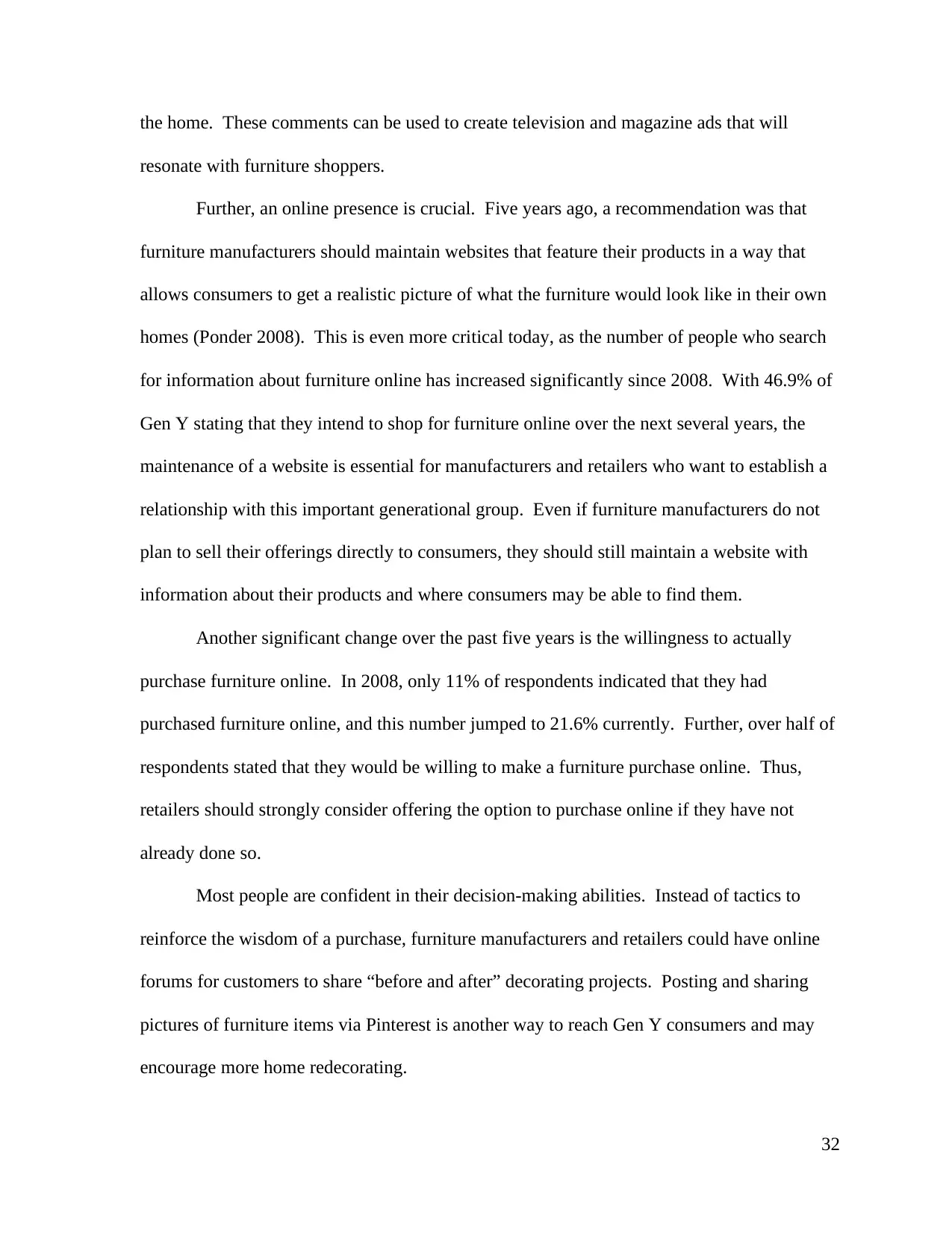
32
the home. These comments can be used to create television and magazine ads that will
resonate with furniture shoppers.
Further, an online presence is crucial. Five years ago, a recommendation was that
furniture manufacturers should maintain websites that feature their products in a way that
allows consumers to get a realistic picture of what the furniture would look like in their own
homes (Ponder 2008). This is even more critical today, as the number of people who search
for information about furniture online has increased significantly since 2008. With 46.9% of
Gen Y stating that they intend to shop for furniture online over the next several years, the
maintenance of a website is essential for manufacturers and retailers who want to establish a
relationship with this important generational group. Even if furniture manufacturers do not
plan to sell their offerings directly to consumers, they should still maintain a website with
information about their products and where consumers may be able to find them.
Another significant change over the past five years is the willingness to actually
purchase furniture online. In 2008, only 11% of respondents indicated that they had
purchased furniture online, and this number jumped to 21.6% currently. Further, over half of
respondents stated that they would be willing to make a furniture purchase online. Thus,
retailers should strongly consider offering the option to purchase online if they have not
already done so.
Most people are confident in their decision-making abilities. Instead of tactics to
reinforce the wisdom of a purchase, furniture manufacturers and retailers could have online
forums for customers to share “before and after” decorating projects. Posting and sharing
pictures of furniture items via Pinterest is another way to reach Gen Y consumers and may
encourage more home redecorating.
the home. These comments can be used to create television and magazine ads that will
resonate with furniture shoppers.
Further, an online presence is crucial. Five years ago, a recommendation was that
furniture manufacturers should maintain websites that feature their products in a way that
allows consumers to get a realistic picture of what the furniture would look like in their own
homes (Ponder 2008). This is even more critical today, as the number of people who search
for information about furniture online has increased significantly since 2008. With 46.9% of
Gen Y stating that they intend to shop for furniture online over the next several years, the
maintenance of a website is essential for manufacturers and retailers who want to establish a
relationship with this important generational group. Even if furniture manufacturers do not
plan to sell their offerings directly to consumers, they should still maintain a website with
information about their products and where consumers may be able to find them.
Another significant change over the past five years is the willingness to actually
purchase furniture online. In 2008, only 11% of respondents indicated that they had
purchased furniture online, and this number jumped to 21.6% currently. Further, over half of
respondents stated that they would be willing to make a furniture purchase online. Thus,
retailers should strongly consider offering the option to purchase online if they have not
already done so.
Most people are confident in their decision-making abilities. Instead of tactics to
reinforce the wisdom of a purchase, furniture manufacturers and retailers could have online
forums for customers to share “before and after” decorating projects. Posting and sharing
pictures of furniture items via Pinterest is another way to reach Gen Y consumers and may
encourage more home redecorating.
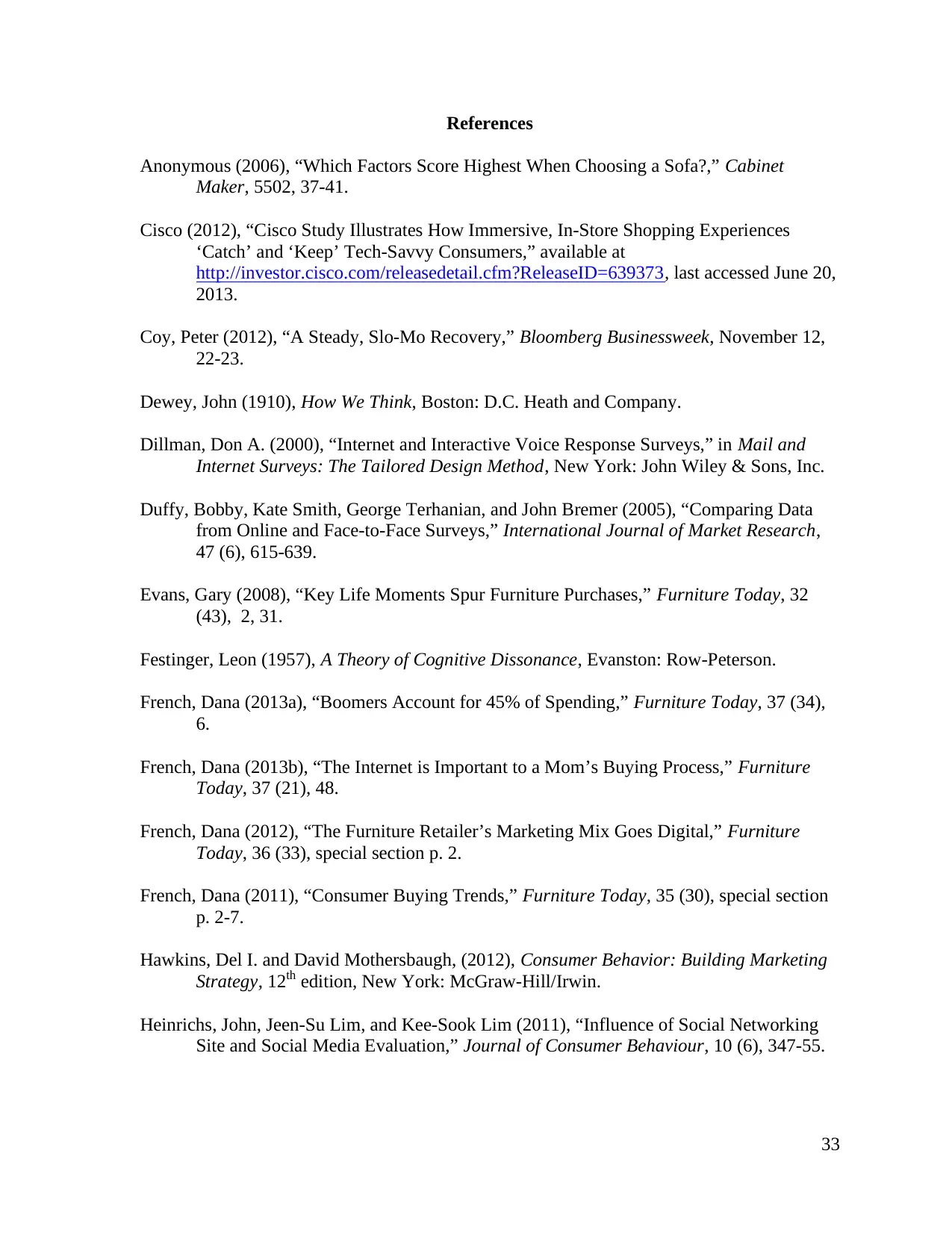
33
References
Anonymous (2006), “Which Factors Score Highest When Choosing a Sofa?,” Cabinet
Maker, 5502, 37-41.
Cisco (2012), “Cisco Study Illustrates How Immersive, In-Store Shopping Experiences
‘Catch’ and ‘Keep’ Tech-Savvy Consumers,” available at
http://investor.cisco.com/releasedetail.cfm?ReleaseID=639373, last accessed June 20,
2013.
Coy, Peter (2012), “A Steady, Slo-Mo Recovery,” Bloomberg Businessweek, November 12,
22-23.
Dewey, John (1910), How We Think, Boston: D.C. Heath and Company.
Dillman, Don A. (2000), “Internet and Interactive Voice Response Surveys,” in Mail and
Internet Surveys: The Tailored Design Method, New York: John Wiley & Sons, Inc.
Duffy, Bobby, Kate Smith, George Terhanian, and John Bremer (2005), “Comparing Data
from Online and Face-to-Face Surveys,” International Journal of Market Research,
47 (6), 615-639.
Evans, Gary (2008), “Key Life Moments Spur Furniture Purchases,” Furniture Today, 32
(43), 2, 31.
Festinger, Leon (1957), A Theory of Cognitive Dissonance, Evanston: Row-Peterson.
French, Dana (2013a), “Boomers Account for 45% of Spending,” Furniture Today, 37 (34),
6.
French, Dana (2013b), “The Internet is Important to a Mom’s Buying Process,” Furniture
Today, 37 (21), 48.
French, Dana (2012), “The Furniture Retailer’s Marketing Mix Goes Digital,” Furniture
Today, 36 (33), special section p. 2.
French, Dana (2011), “Consumer Buying Trends,” Furniture Today, 35 (30), special section
p. 2-7.
Hawkins, Del I. and David Mothersbaugh, (2012), Consumer Behavior: Building Marketing
Strategy, 12th edition, New York: McGraw-Hill/Irwin.
Heinrichs, John, Jeen-Su Lim, and Kee-Sook Lim (2011), “Influence of Social Networking
Site and Social Media Evaluation,” Journal of Consumer Behaviour, 10 (6), 347-55.
References
Anonymous (2006), “Which Factors Score Highest When Choosing a Sofa?,” Cabinet
Maker, 5502, 37-41.
Cisco (2012), “Cisco Study Illustrates How Immersive, In-Store Shopping Experiences
‘Catch’ and ‘Keep’ Tech-Savvy Consumers,” available at
http://investor.cisco.com/releasedetail.cfm?ReleaseID=639373, last accessed June 20,
2013.
Coy, Peter (2012), “A Steady, Slo-Mo Recovery,” Bloomberg Businessweek, November 12,
22-23.
Dewey, John (1910), How We Think, Boston: D.C. Heath and Company.
Dillman, Don A. (2000), “Internet and Interactive Voice Response Surveys,” in Mail and
Internet Surveys: The Tailored Design Method, New York: John Wiley & Sons, Inc.
Duffy, Bobby, Kate Smith, George Terhanian, and John Bremer (2005), “Comparing Data
from Online and Face-to-Face Surveys,” International Journal of Market Research,
47 (6), 615-639.
Evans, Gary (2008), “Key Life Moments Spur Furniture Purchases,” Furniture Today, 32
(43), 2, 31.
Festinger, Leon (1957), A Theory of Cognitive Dissonance, Evanston: Row-Peterson.
French, Dana (2013a), “Boomers Account for 45% of Spending,” Furniture Today, 37 (34),
6.
French, Dana (2013b), “The Internet is Important to a Mom’s Buying Process,” Furniture
Today, 37 (21), 48.
French, Dana (2012), “The Furniture Retailer’s Marketing Mix Goes Digital,” Furniture
Today, 36 (33), special section p. 2.
French, Dana (2011), “Consumer Buying Trends,” Furniture Today, 35 (30), special section
p. 2-7.
Hawkins, Del I. and David Mothersbaugh, (2012), Consumer Behavior: Building Marketing
Strategy, 12th edition, New York: McGraw-Hill/Irwin.
Heinrichs, John, Jeen-Su Lim, and Kee-Sook Lim (2011), “Influence of Social Networking
Site and Social Media Evaluation,” Journal of Consumer Behaviour, 10 (6), 347-55.
Paraphrase This Document
Need a fresh take? Get an instant paraphrase of this document with our AI Paraphraser

34
Hudson, Kris (2013), “Is Generation Y a ‘Game Changer’ for Housing?,” Wall Street Journal
online, available at http://blogs.wsj.com/developments/2013/05/15/is-generation-y-a-
game-changer-for-housing/, last accessed June 20, 2013.
Miller, Rich and Steve Matthews (2013), “The Long, Slow, but Still-Going Recovery,”
Bloomberg Businessweek, June 10, 49-51.
Moscaritolo, Angela (2012), “Top Social Networks: Facebook, Twitter, and ... Pinterest?,”
PC Magazine, April, 1.
Nickell, Stephanie (2013), “Online Furniture Consumers Unsure about Brands,” Furniture
Today, 37 (21), 48.
Nielsen (2008), “An Overview of Home Internet Access in the U.S.,” available at
www.nielsen.com/content/dam/corporate/us/en/newswire/uploads/2009/03/overview-
of-home-internet-access-in-the-us-jan-6.pdf, last accessed June 10, 2013.
Notess, Greg (2012), “Next Generation Social Networks and Search,” Online, 36 (3), 44-46.
Oliver, Richard L. (1997), Satisfaction: A Behavioral Perspective on the Consumer,
McGraw-Hill Book Company, New York.
Perry, David (2007), “Stir Your Consumers’ Emotions,” Furniture Today, 32 (14), 22.
Peterson, Robert A. and Maria C. Merino (2003), “Consumer Information Search Behavior
and the Internet,” Psychology & Marketing, 20 (2), 99-121.
Ponder, Nicole (2008), “An Examination of the Consumer Decision Process for Purchasing
Household Furniture,” Franklin Institute for Furniture Manufacturing, Mississippi
State University.
Thompson, S.C., J.S. Pitts, and L. Schwankowsky (1993), “Preferences for Involvement in
Medical Decision Making: Situational and Demographic Differences,” Patient
Education and Counseling, 22 (1), 133–40.
www.census.gov, accessed June 5, 2013.
York, Jenny Heinzen (2013), “The Future is Now,” Home Accents Today, 28 (6), 1.
York, Jenny Heinzen (2011), “Social Media’s Draw too Powerful to Ignore,” Furniture
Today, 35 (41), 37-38.
York, Jenny Heinzen (2010), “Consumers More Comfortable with Online Buying,”
Furniture Today, 35 (12), 16.
Hudson, Kris (2013), “Is Generation Y a ‘Game Changer’ for Housing?,” Wall Street Journal
online, available at http://blogs.wsj.com/developments/2013/05/15/is-generation-y-a-
game-changer-for-housing/, last accessed June 20, 2013.
Miller, Rich and Steve Matthews (2013), “The Long, Slow, but Still-Going Recovery,”
Bloomberg Businessweek, June 10, 49-51.
Moscaritolo, Angela (2012), “Top Social Networks: Facebook, Twitter, and ... Pinterest?,”
PC Magazine, April, 1.
Nickell, Stephanie (2013), “Online Furniture Consumers Unsure about Brands,” Furniture
Today, 37 (21), 48.
Nielsen (2008), “An Overview of Home Internet Access in the U.S.,” available at
www.nielsen.com/content/dam/corporate/us/en/newswire/uploads/2009/03/overview-
of-home-internet-access-in-the-us-jan-6.pdf, last accessed June 10, 2013.
Notess, Greg (2012), “Next Generation Social Networks and Search,” Online, 36 (3), 44-46.
Oliver, Richard L. (1997), Satisfaction: A Behavioral Perspective on the Consumer,
McGraw-Hill Book Company, New York.
Perry, David (2007), “Stir Your Consumers’ Emotions,” Furniture Today, 32 (14), 22.
Peterson, Robert A. and Maria C. Merino (2003), “Consumer Information Search Behavior
and the Internet,” Psychology & Marketing, 20 (2), 99-121.
Ponder, Nicole (2008), “An Examination of the Consumer Decision Process for Purchasing
Household Furniture,” Franklin Institute for Furniture Manufacturing, Mississippi
State University.
Thompson, S.C., J.S. Pitts, and L. Schwankowsky (1993), “Preferences for Involvement in
Medical Decision Making: Situational and Demographic Differences,” Patient
Education and Counseling, 22 (1), 133–40.
www.census.gov, accessed June 5, 2013.
York, Jenny Heinzen (2013), “The Future is Now,” Home Accents Today, 28 (6), 1.
York, Jenny Heinzen (2011), “Social Media’s Draw too Powerful to Ignore,” Furniture
Today, 35 (41), 37-38.
York, Jenny Heinzen (2010), “Consumers More Comfortable with Online Buying,”
Furniture Today, 35 (12), 16.

35
Appendix
Survey Instrument
Welcome!
You have been invited to participate in an online research project about household furniture.
The survey is going to ask you about your thoughts and feelings towards the furniture in your
home and answer some questions about your experiences with shopping for and purchasing
furniture.
Participation in this survey is voluntary, and you are free to answer or not answer any
questions at no penalty. There are no reasonably foreseeable risks or discomforts that might
occur as a result of your participation in the study. To participate in this survey you must be
18 years old or older.
The time needed to participate in the entire study is approximately 15-20 minutes. Thank you
for your participation and if you have any questions please contact:
Dr. Nicole Ponder
Mississippi State University
E-mail: nponder@cobilan.msstate.edu
or
Institutional Review Board
Mississippi State University
Email: irb@research.msstate.edu
Appendix
Survey Instrument
Welcome!
You have been invited to participate in an online research project about household furniture.
The survey is going to ask you about your thoughts and feelings towards the furniture in your
home and answer some questions about your experiences with shopping for and purchasing
furniture.
Participation in this survey is voluntary, and you are free to answer or not answer any
questions at no penalty. There are no reasonably foreseeable risks or discomforts that might
occur as a result of your participation in the study. To participate in this survey you must be
18 years old or older.
The time needed to participate in the entire study is approximately 15-20 minutes. Thank you
for your participation and if you have any questions please contact:
Dr. Nicole Ponder
Mississippi State University
E-mail: nponder@cobilan.msstate.edu
or
Institutional Review Board
Mississippi State University
Email: irb@research.msstate.edu
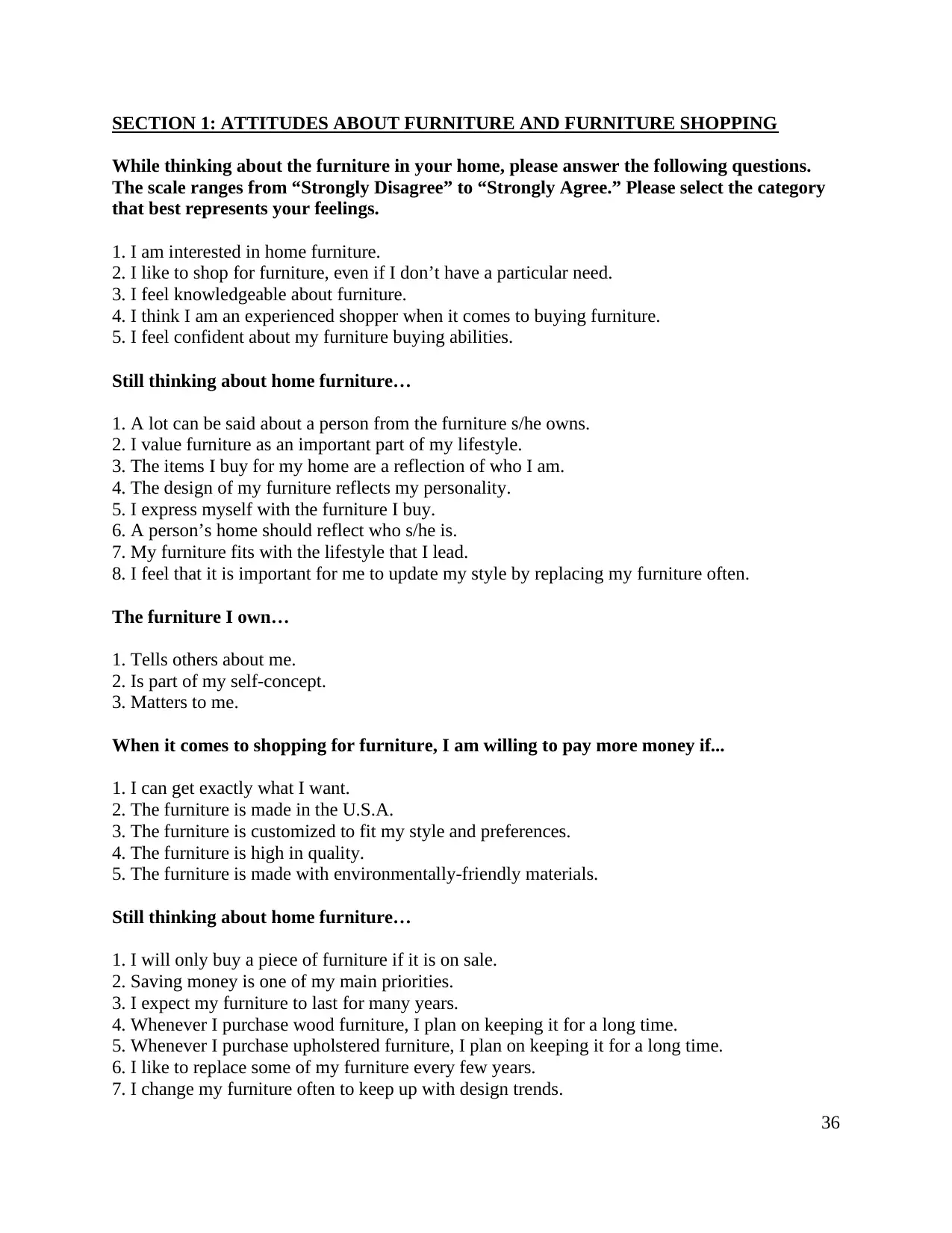
36
SECTION 1: ATTITUDES ABOUT FURNITURE AND FURNITURE SHOPPING
While thinking about the furniture in your home, please answer the following questions.
The scale ranges from “Strongly Disagree” to “Strongly Agree.” Please select the category
that best represents your feelings.
1. I am interested in home furniture.
2. I like to shop for furniture, even if I don’t have a particular need.
3. I feel knowledgeable about furniture.
4. I think I am an experienced shopper when it comes to buying furniture.
5. I feel confident about my furniture buying abilities.
Still thinking about home furniture…
1. A lot can be said about a person from the furniture s/he owns.
2. I value furniture as an important part of my lifestyle.
3. The items I buy for my home are a reflection of who I am.
4. The design of my furniture reflects my personality.
5. I express myself with the furniture I buy.
6. A person’s home should reflect who s/he is.
7. My furniture fits with the lifestyle that I lead.
8. I feel that it is important for me to update my style by replacing my furniture often.
The furniture I own…
1. Tells others about me.
2. Is part of my self-concept.
3. Matters to me.
When it comes to shopping for furniture, I am willing to pay more money if...
1. I can get exactly what I want.
2. The furniture is made in the U.S.A.
3. The furniture is customized to fit my style and preferences.
4. The furniture is high in quality.
5. The furniture is made with environmentally-friendly materials.
Still thinking about home furniture…
1. I will only buy a piece of furniture if it is on sale.
2. Saving money is one of my main priorities.
3. I expect my furniture to last for many years.
4. Whenever I purchase wood furniture, I plan on keeping it for a long time.
5. Whenever I purchase upholstered furniture, I plan on keeping it for a long time.
6. I like to replace some of my furniture every few years.
7. I change my furniture often to keep up with design trends.
SECTION 1: ATTITUDES ABOUT FURNITURE AND FURNITURE SHOPPING
While thinking about the furniture in your home, please answer the following questions.
The scale ranges from “Strongly Disagree” to “Strongly Agree.” Please select the category
that best represents your feelings.
1. I am interested in home furniture.
2. I like to shop for furniture, even if I don’t have a particular need.
3. I feel knowledgeable about furniture.
4. I think I am an experienced shopper when it comes to buying furniture.
5. I feel confident about my furniture buying abilities.
Still thinking about home furniture…
1. A lot can be said about a person from the furniture s/he owns.
2. I value furniture as an important part of my lifestyle.
3. The items I buy for my home are a reflection of who I am.
4. The design of my furniture reflects my personality.
5. I express myself with the furniture I buy.
6. A person’s home should reflect who s/he is.
7. My furniture fits with the lifestyle that I lead.
8. I feel that it is important for me to update my style by replacing my furniture often.
The furniture I own…
1. Tells others about me.
2. Is part of my self-concept.
3. Matters to me.
When it comes to shopping for furniture, I am willing to pay more money if...
1. I can get exactly what I want.
2. The furniture is made in the U.S.A.
3. The furniture is customized to fit my style and preferences.
4. The furniture is high in quality.
5. The furniture is made with environmentally-friendly materials.
Still thinking about home furniture…
1. I will only buy a piece of furniture if it is on sale.
2. Saving money is one of my main priorities.
3. I expect my furniture to last for many years.
4. Whenever I purchase wood furniture, I plan on keeping it for a long time.
5. Whenever I purchase upholstered furniture, I plan on keeping it for a long time.
6. I like to replace some of my furniture every few years.
7. I change my furniture often to keep up with design trends.
Secure Best Marks with AI Grader
Need help grading? Try our AI Grader for instant feedback on your assignments.

37
8. I believe that wood furniture should be kept for:
Less than 1 year
1-3 years
3-5 years
5-7 years
7-10 years
10-15 years
More than 15 years
9. I believe that upholstered furniture should be kept for:
Less than 1 year
1-3 years
3-5 years
5-7 years
7-10 years
10-15 years
More than 15 years
10. Now think specifically about your home and the furniture in it. What is your most favorite
room in your home, and why do you say that? Please share anything you'd like about your
favorite room.
11. Please tell us about the furniture you have in your favorite room. Does your furniture help to
make it your favorite?
How do you feel about furniture and the environment? Please answer the following.
1. I want my furniture to be environmentally-friendly.
2. I feel a moral obligation to buy environmentally-friendly furniture for my home.
3. I will not buy furniture from a company that is ecologically irresponsible.
4. I would be willing to stop buying furniture from companies who pollute the environment even
though it might be inconvenient for me.
5. Suppose a sofa that you really like cost $800 and is made with materials that have a negative
impact on the environment. How much more are you willing to pay for the sofa if it is made
with environmentally-friendly materials?
I am not willing to pay any more than $800 for the sofa.
I'd be willing to pay $850 for the sofa.
I'd be willing to pay $900 for the sofa.
I'd be willing to pay $950 for the sofa.
I'd be willing to pay $1,000 for the sofa.
I'd be willing to pay more than $1,000 for the sofa.
8. I believe that wood furniture should be kept for:
Less than 1 year
1-3 years
3-5 years
5-7 years
7-10 years
10-15 years
More than 15 years
9. I believe that upholstered furniture should be kept for:
Less than 1 year
1-3 years
3-5 years
5-7 years
7-10 years
10-15 years
More than 15 years
10. Now think specifically about your home and the furniture in it. What is your most favorite
room in your home, and why do you say that? Please share anything you'd like about your
favorite room.
11. Please tell us about the furniture you have in your favorite room. Does your furniture help to
make it your favorite?
How do you feel about furniture and the environment? Please answer the following.
1. I want my furniture to be environmentally-friendly.
2. I feel a moral obligation to buy environmentally-friendly furniture for my home.
3. I will not buy furniture from a company that is ecologically irresponsible.
4. I would be willing to stop buying furniture from companies who pollute the environment even
though it might be inconvenient for me.
5. Suppose a sofa that you really like cost $800 and is made with materials that have a negative
impact on the environment. How much more are you willing to pay for the sofa if it is made
with environmentally-friendly materials?
I am not willing to pay any more than $800 for the sofa.
I'd be willing to pay $850 for the sofa.
I'd be willing to pay $900 for the sofa.
I'd be willing to pay $950 for the sofa.
I'd be willing to pay $1,000 for the sofa.
I'd be willing to pay more than $1,000 for the sofa.

38
Thinking about where your furniture is made...
1. I try to buy furniture only if it is made in the United States.
2. It may cost more in the long-run, but I prefer to support American-made furniture.
3. It is always best to support American furniture manufacturers.
4. We should purchase furniture made in the U.S.A. instead of furniture made in other countries.
5. Suppose a sofa that you really like costs $800 and is made in China. How much more are you
willing to pay for the sofa if it is made in the U.S.A.?
I am not willing to pay any more than $800 for the sofa.
I'd be willing to pay $850 for the sofa.
I'd be willing to pay $900 for the sofa.
I'd be willing to pay $950 for the sofa.
I'd be willing to pay $1,000 for the sofa.
I'd be willing to pay more than $1,000 for the sofa.
When selecting and purchasing furniture…
1. I often influence other people’s opinions about furniture.
2. I feel more comfortable buying a piece of furniture when I have gotten other people’s opinions
on it.
3. I like to get other people’s opinions before I buy a piece of furniture.
4. When choosing furniture, other people’s opinions are important to me.
5. Other people usually come to me for advice about choosing furniture.
6. People that I know pick their furniture based on what I have told them.
The following are some characteristics of furniture, all of which may be important to you.
Please RANK each characteristic from 1 to 4, with 1 being the most important feature you
look for, and 4 being the least important. Click on and hold the attribute to move it up or
down to finalize your rankings.
______ Quality of the furniture
______ Furniture is made with environmentally-friendly materials
______ Price of the furniture
______ Furniture is made in the U.S.A.
Again, the following are some characteristics of furniture. Please RANK each
characteristic from 1 to 4, with 1 being the most important feature you look for, and 4
being the least important. Click on and hold the attribute to move it up or down to finalize
your rankings.
______ Style of the furniture
______ Brand name of the furniture
______ Furniture is made in the U.S.A.
______ Price of the furniture
Thinking about where your furniture is made...
1. I try to buy furniture only if it is made in the United States.
2. It may cost more in the long-run, but I prefer to support American-made furniture.
3. It is always best to support American furniture manufacturers.
4. We should purchase furniture made in the U.S.A. instead of furniture made in other countries.
5. Suppose a sofa that you really like costs $800 and is made in China. How much more are you
willing to pay for the sofa if it is made in the U.S.A.?
I am not willing to pay any more than $800 for the sofa.
I'd be willing to pay $850 for the sofa.
I'd be willing to pay $900 for the sofa.
I'd be willing to pay $950 for the sofa.
I'd be willing to pay $1,000 for the sofa.
I'd be willing to pay more than $1,000 for the sofa.
When selecting and purchasing furniture…
1. I often influence other people’s opinions about furniture.
2. I feel more comfortable buying a piece of furniture when I have gotten other people’s opinions
on it.
3. I like to get other people’s opinions before I buy a piece of furniture.
4. When choosing furniture, other people’s opinions are important to me.
5. Other people usually come to me for advice about choosing furniture.
6. People that I know pick their furniture based on what I have told them.
The following are some characteristics of furniture, all of which may be important to you.
Please RANK each characteristic from 1 to 4, with 1 being the most important feature you
look for, and 4 being the least important. Click on and hold the attribute to move it up or
down to finalize your rankings.
______ Quality of the furniture
______ Furniture is made with environmentally-friendly materials
______ Price of the furniture
______ Furniture is made in the U.S.A.
Again, the following are some characteristics of furniture. Please RANK each
characteristic from 1 to 4, with 1 being the most important feature you look for, and 4
being the least important. Click on and hold the attribute to move it up or down to finalize
your rankings.
______ Style of the furniture
______ Brand name of the furniture
______ Furniture is made in the U.S.A.
______ Price of the furniture
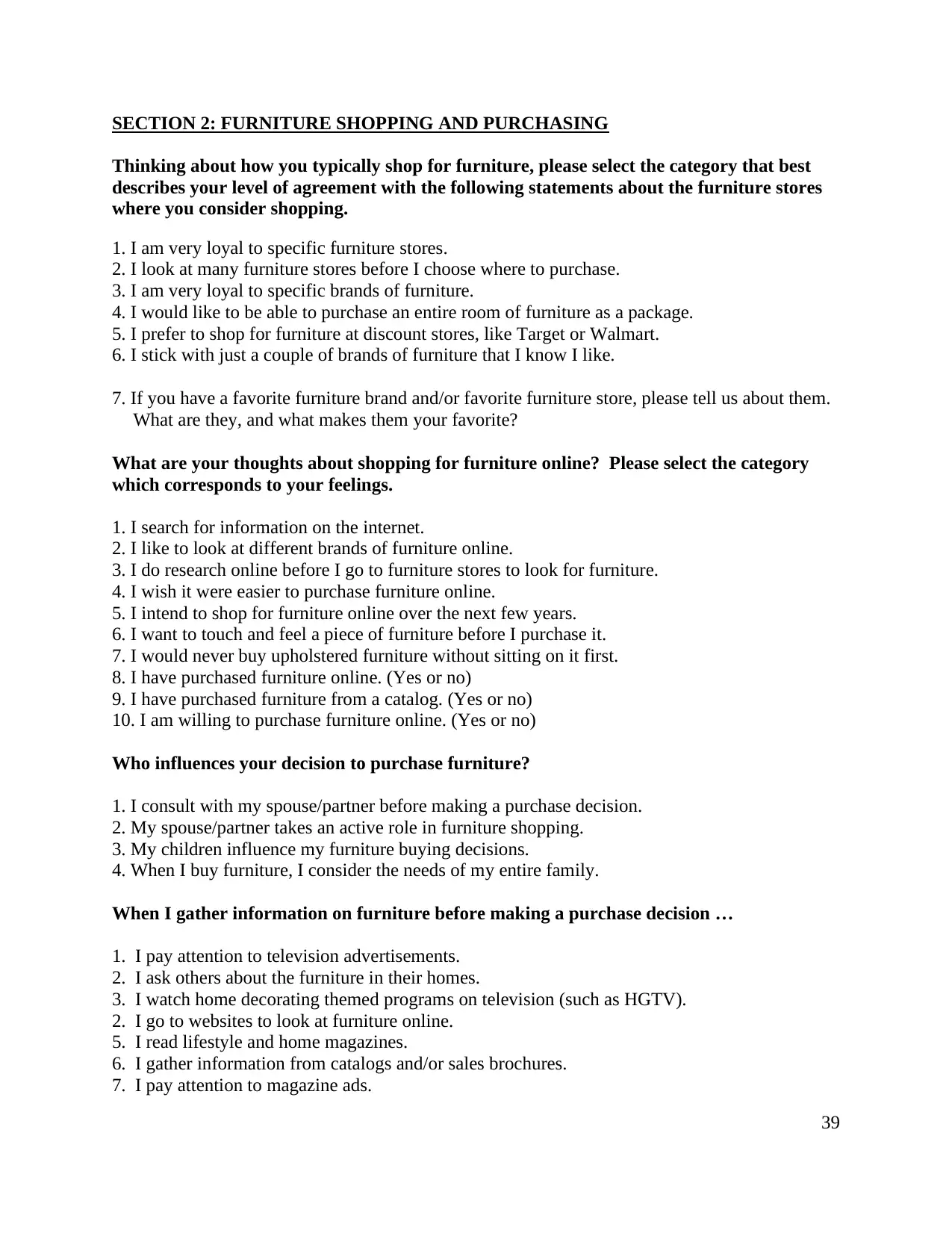
39
SECTION 2: FURNITURE SHOPPING AND PURCHASING
Thinking about how you typically shop for furniture, please select the category that best
describes your level of agreement with the following statements about the furniture stores
where you consider shopping.
1. I am very loyal to specific furniture stores.
2. I look at many furniture stores before I choose where to purchase.
3. I am very loyal to specific brands of furniture.
4. I would like to be able to purchase an entire room of furniture as a package.
5. I prefer to shop for furniture at discount stores, like Target or Walmart.
6. I stick with just a couple of brands of furniture that I know I like.
7. If you have a favorite furniture brand and/or favorite furniture store, please tell us about them.
What are they, and what makes them your favorite?
What are your thoughts about shopping for furniture online? Please select the category
which corresponds to your feelings.
1. I search for information on the internet.
2. I like to look at different brands of furniture online.
3. I do research online before I go to furniture stores to look for furniture.
4. I wish it were easier to purchase furniture online.
5. I intend to shop for furniture online over the next few years.
6. I want to touch and feel a piece of furniture before I purchase it.
7. I would never buy upholstered furniture without sitting on it first.
8. I have purchased furniture online. (Yes or no)
9. I have purchased furniture from a catalog. (Yes or no)
10. I am willing to purchase furniture online. (Yes or no)
Who influences your decision to purchase furniture?
1. I consult with my spouse/partner before making a purchase decision.
2. My spouse/partner takes an active role in furniture shopping.
3. My children influence my furniture buying decisions.
4. When I buy furniture, I consider the needs of my entire family.
When I gather information on furniture before making a purchase decision …
1. I pay attention to television advertisements.
2. I ask others about the furniture in their homes.
3. I watch home decorating themed programs on television (such as HGTV).
2. I go to websites to look at furniture online.
5. I read lifestyle and home magazines.
6. I gather information from catalogs and/or sales brochures.
7. I pay attention to magazine ads.
SECTION 2: FURNITURE SHOPPING AND PURCHASING
Thinking about how you typically shop for furniture, please select the category that best
describes your level of agreement with the following statements about the furniture stores
where you consider shopping.
1. I am very loyal to specific furniture stores.
2. I look at many furniture stores before I choose where to purchase.
3. I am very loyal to specific brands of furniture.
4. I would like to be able to purchase an entire room of furniture as a package.
5. I prefer to shop for furniture at discount stores, like Target or Walmart.
6. I stick with just a couple of brands of furniture that I know I like.
7. If you have a favorite furniture brand and/or favorite furniture store, please tell us about them.
What are they, and what makes them your favorite?
What are your thoughts about shopping for furniture online? Please select the category
which corresponds to your feelings.
1. I search for information on the internet.
2. I like to look at different brands of furniture online.
3. I do research online before I go to furniture stores to look for furniture.
4. I wish it were easier to purchase furniture online.
5. I intend to shop for furniture online over the next few years.
6. I want to touch and feel a piece of furniture before I purchase it.
7. I would never buy upholstered furniture without sitting on it first.
8. I have purchased furniture online. (Yes or no)
9. I have purchased furniture from a catalog. (Yes or no)
10. I am willing to purchase furniture online. (Yes or no)
Who influences your decision to purchase furniture?
1. I consult with my spouse/partner before making a purchase decision.
2. My spouse/partner takes an active role in furniture shopping.
3. My children influence my furniture buying decisions.
4. When I buy furniture, I consider the needs of my entire family.
When I gather information on furniture before making a purchase decision …
1. I pay attention to television advertisements.
2. I ask others about the furniture in their homes.
3. I watch home decorating themed programs on television (such as HGTV).
2. I go to websites to look at furniture online.
5. I read lifestyle and home magazines.
6. I gather information from catalogs and/or sales brochures.
7. I pay attention to magazine ads.
Paraphrase This Document
Need a fresh take? Get an instant paraphrase of this document with our AI Paraphraser
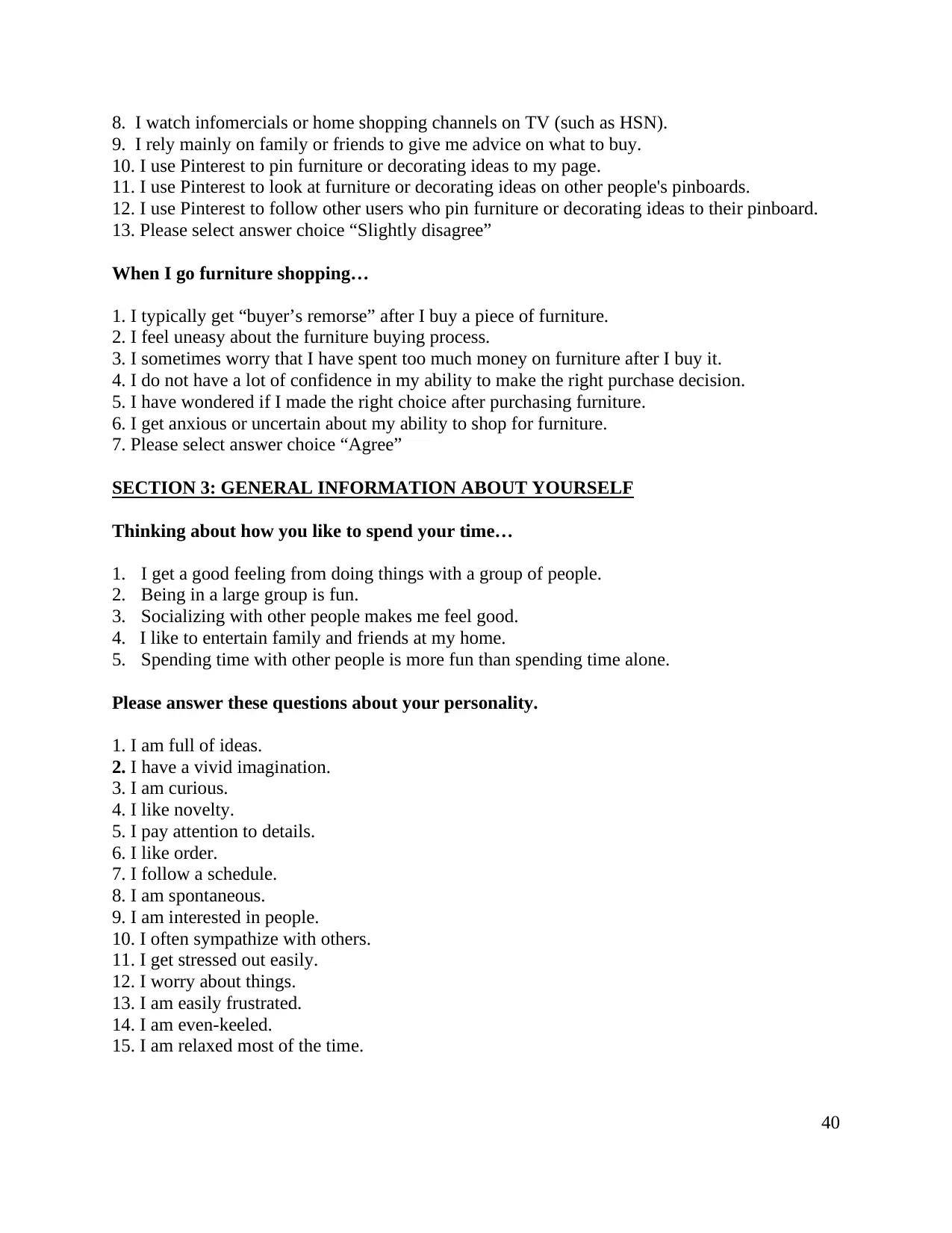
40
8. I watch infomercials or home shopping channels on TV (such as HSN).
9. I rely mainly on family or friends to give me advice on what to buy.
10. I use Pinterest to pin furniture or decorating ideas to my page.
11. I use Pinterest to look at furniture or decorating ideas on other people's pinboards.
12. I use Pinterest to follow other users who pin furniture or decorating ideas to their pinboard.
13. Please select answer choice “Slightly disagree”
When I go furniture shopping…
1. I typically get “buyer’s remorse” after I buy a piece of furniture.
2. I feel uneasy about the furniture buying process.
3. I sometimes worry that I have spent too much money on furniture after I buy it.
4. I do not have a lot of confidence in my ability to make the right purchase decision.
5. I have wondered if I made the right choice after purchasing furniture.
6. I get anxious or uncertain about my ability to shop for furniture.
7. Please select answer choice “Agree”
SECTION 3: GENERAL INFORMATION ABOUT YOURSELF
Thinking about how you like to spend your time…
1. I get a good feeling from doing things with a group of people.
2. Being in a large group is fun.
3. Socializing with other people makes me feel good.
4. I like to entertain family and friends at my home.
5. Spending time with other people is more fun than spending time alone.
Please answer these questions about your personality.
1. I am full of ideas.
2. I have a vivid imagination.
3. I am curious.
4. I like novelty.
5. I pay attention to details.
6. I like order.
7. I follow a schedule.
8. I am spontaneous.
9. I am interested in people.
10. I often sympathize with others.
11. I get stressed out easily.
12. I worry about things.
13. I am easily frustrated.
14. I am even-keeled.
15. I am relaxed most of the time.
8. I watch infomercials or home shopping channels on TV (such as HSN).
9. I rely mainly on family or friends to give me advice on what to buy.
10. I use Pinterest to pin furniture or decorating ideas to my page.
11. I use Pinterest to look at furniture or decorating ideas on other people's pinboards.
12. I use Pinterest to follow other users who pin furniture or decorating ideas to their pinboard.
13. Please select answer choice “Slightly disagree”
When I go furniture shopping…
1. I typically get “buyer’s remorse” after I buy a piece of furniture.
2. I feel uneasy about the furniture buying process.
3. I sometimes worry that I have spent too much money on furniture after I buy it.
4. I do not have a lot of confidence in my ability to make the right purchase decision.
5. I have wondered if I made the right choice after purchasing furniture.
6. I get anxious or uncertain about my ability to shop for furniture.
7. Please select answer choice “Agree”
SECTION 3: GENERAL INFORMATION ABOUT YOURSELF
Thinking about how you like to spend your time…
1. I get a good feeling from doing things with a group of people.
2. Being in a large group is fun.
3. Socializing with other people makes me feel good.
4. I like to entertain family and friends at my home.
5. Spending time with other people is more fun than spending time alone.
Please answer these questions about your personality.
1. I am full of ideas.
2. I have a vivid imagination.
3. I am curious.
4. I like novelty.
5. I pay attention to details.
6. I like order.
7. I follow a schedule.
8. I am spontaneous.
9. I am interested in people.
10. I often sympathize with others.
11. I get stressed out easily.
12. I worry about things.
13. I am easily frustrated.
14. I am even-keeled.
15. I am relaxed most of the time.

41
Demographic Questions
1. What is your gender?
Male
Female
Prefer not to say
2. Please select your age from the pull-down menu below. (drop-down menu ranges from 18-100
or over)
3. What is your ethnicity?
White/Caucasian
Hispanic/Latino
Black/African American
American Indian
Asian
Alaskan Native
Native Hawaiian/Other Pacific Islander
Multi-Cultural
Other (please write in) ____________________
Prefer not to answer
4. What is the highest level of education you have completed?
Less than High School
High School / GED
Some College
2-year College Degree
4-year College Degree
Masters Degree
Doctoral Degree
Professional Degree (JD, MD)
5. What is your work status?
Work full time (40 or more hours per week)
Work part time (21-39 hours per week)
Work part time (up to 20 hours per week)
Unemployed/Do not work
Retired
<If unemployed or retired is selected, SKIP to income question.>
Demographic Questions
1. What is your gender?
Male
Female
Prefer not to say
2. Please select your age from the pull-down menu below. (drop-down menu ranges from 18-100
or over)
3. What is your ethnicity?
White/Caucasian
Hispanic/Latino
Black/African American
American Indian
Asian
Alaskan Native
Native Hawaiian/Other Pacific Islander
Multi-Cultural
Other (please write in) ____________________
Prefer not to answer
4. What is the highest level of education you have completed?
Less than High School
High School / GED
Some College
2-year College Degree
4-year College Degree
Masters Degree
Doctoral Degree
Professional Degree (JD, MD)
5. What is your work status?
Work full time (40 or more hours per week)
Work part time (21-39 hours per week)
Work part time (up to 20 hours per week)
Unemployed/Do not work
Retired
<If unemployed or retired is selected, SKIP to income question.>

42
6. In which industry are you employed? (U.S. Census categories)
Forestry, fishing, hunting or agriculture support
Mining
Utilities
Construction
Manufacturing
Wholesale trade
Retail trade
Transportation or warehousing
Information
Finance or insurance
Real estate or rental and leasing
Professional, scientific or technical services
Management of companies or enterprises
Admin, support, waste management or remediation services
Educational services
Health care or social assistance
Arts, entertainment or recreation
Accommodation or food services
Other services (except public administration)
Unclassified establishments
7. What is your annual income range?
Below $20,000
$20,000 - $39,999
$40,000 - $59,999
$60,000 - $79,999
$80,000 - $99,999
$100,000 - $119,999
$120,000 - $139,999
$140,000 - $159,999
$160,000 - $179,999
$180,000 - $199,999
$200,000 or more
Prefer not to answer
6. In which industry are you employed? (U.S. Census categories)
Forestry, fishing, hunting or agriculture support
Mining
Utilities
Construction
Manufacturing
Wholesale trade
Retail trade
Transportation or warehousing
Information
Finance or insurance
Real estate or rental and leasing
Professional, scientific or technical services
Management of companies or enterprises
Admin, support, waste management or remediation services
Educational services
Health care or social assistance
Arts, entertainment or recreation
Accommodation or food services
Other services (except public administration)
Unclassified establishments
7. What is your annual income range?
Below $20,000
$20,000 - $39,999
$40,000 - $59,999
$60,000 - $79,999
$80,000 - $99,999
$100,000 - $119,999
$120,000 - $139,999
$140,000 - $159,999
$160,000 - $179,999
$180,000 - $199,999
$200,000 or more
Prefer not to answer
Secure Best Marks with AI Grader
Need help grading? Try our AI Grader for instant feedback on your assignments.

43
8. What is your marital status?
Single, never married
Married without children
Married with children living at home
Married with children not living at home
Divorced
Separated
Widowed
Living w/ partner
Prefer not to answer
9. In which state do you currently reside? Please select from the drop-down menu.
10. In what city do you currently reside? Please type in your response. ____________________
11. Do you own or rent your primary home?
Own
Rent
Other, please write in ____________________
12. What is the size of your primary residence?
Less than 800 sq. ft.
800-1199 sq. ft.
1200-1499 sq. ft.
1500-1999 sq. ft.
2000-2999 sq. ft.
3000-3999 sq. ft.
4000-4999 sq. ft.
5000 sq. ft. or more
13. Do you own a second home, such as a vacation home?
Yes
No
14. And finally, is there anything you would like to tell us about your feelings towards home
furniture? Please write in the space below.
Thank you very much for your time and effort in completing the survey!
8. What is your marital status?
Single, never married
Married without children
Married with children living at home
Married with children not living at home
Divorced
Separated
Widowed
Living w/ partner
Prefer not to answer
9. In which state do you currently reside? Please select from the drop-down menu.
10. In what city do you currently reside? Please type in your response. ____________________
11. Do you own or rent your primary home?
Own
Rent
Other, please write in ____________________
12. What is the size of your primary residence?
Less than 800 sq. ft.
800-1199 sq. ft.
1200-1499 sq. ft.
1500-1999 sq. ft.
2000-2999 sq. ft.
3000-3999 sq. ft.
4000-4999 sq. ft.
5000 sq. ft. or more
13. Do you own a second home, such as a vacation home?
Yes
No
14. And finally, is there anything you would like to tell us about your feelings towards home
furniture? Please write in the space below.
Thank you very much for your time and effort in completing the survey!
1 out of 47
Your All-in-One AI-Powered Toolkit for Academic Success.
+13062052269
info@desklib.com
Available 24*7 on WhatsApp / Email
![[object Object]](/_next/static/media/star-bottom.7253800d.svg)
Unlock your academic potential
© 2024 | Zucol Services PVT LTD | All rights reserved.